History of Germany
The concept of Germany as a distinct region in central Europe can be traced to Roman commander Julius Caesar, who referred to the unconquered area east of the Rhine as Germania, thus distinguishing it from Gaul (France), which he had conquered. The victory of the Germanic tribes in the Battle of the Teutoburg Forest (AD 9) prevented annexation by the Roman Empire, although the Roman provinces of Germania Superior and Germania Inferior were established along the Rhine. Following the Fall of the Western Roman Empire, the Franks conquered the other West Germanic tribes. When the Frankish Empire was divided among Charles the Great's heirs in 843, the eastern part became East Francia. In 962, Otto I became the first Holy Roman Emperor of the Holy Roman Empire, the medieval German state.
Part of a series on the |
||||||||||
|---|---|---|---|---|---|---|---|---|---|---|
| History of Germany | ||||||||||
 | ||||||||||
| Topics | ||||||||||
| Early history | ||||||||||
| Middle Ages | ||||||||||
| Early Modern period | ||||||||||
| Unification | ||||||||||
| German Reich | ||||||||||
|
||||||||||
| Contemporary Germany | ||||||||||
|
||||||||||
|
| ||||||||||
In the Late Middle Ages, the regional dukes, princes, and bishops gained power at the expense of the emperors. Martin Luther led the Protestant Reformation within the Catholic Church after 1517, as the northern states became Protestant, while the southern states remained Catholic. The two parts of the Holy Roman Empire clashed in the Thirty Years' War (1618–1648), which was ruinous to the twenty million civilians living in both parts. The Thirty Years' War brought tremendous destruction to Germany; more than 1/4 of the population and 1/2 of the male population in the German states were killed by the catastrophic war. 1648 marked the effective end of the Holy Roman Empire and the beginning of the modern nation-state system, with Germany divided into numerous independent states, such as Prussia, Bavaria, Saxony, Austria and other states, which also controlled land outside of the area considered "Germany". After the French Revolution and the Napoleonic Wars from 1803 to 1815, feudalism fell away and liberalism and nationalism clashed with reaction. The German revolutions of 1848–49 failed. The Industrial Revolution modernized the German economy, led to the rapid growth of cities and the emergence of the socialist movement in Germany. Prussia, with its capital Berlin, grew in power. German universities became world-class centers for science and humanities, while music and art flourished. The unification of Germany (excluding Austria and the German-speaking areas of Switzerland) was achieved under the leadership of the Chancellor Otto von Bismarck with the formation of the German Empire in 1871. This resulted in the Kleindeutsche Lösung, ("small Germany solution", Germany without Austria), rather than the Großdeutsche Lösung, ("greater Germany solution", Germany with Austria). The new Reichstag, an elected parliament, had only a limited role in the imperial government. Germany joined the other powers in colonial expansion in Africa and the Pacific.
By 1900, Germany was the dominant power on the European continent and its rapidly expanding industry had surpassed Britain's while provoking it in a naval arms race. Germany led the Central Powers in World War I (1914–1918) against France, Great Britain, Russia and (by 1917) the United States. Defeated and partly occupied, Germany was forced to pay war reparations by the Treaty of Versailles and was stripped of its colonies as well as of home territory to be ceded to Belgium, France, and Poland, and was banned from uniting with German-settled regions of Austria. The German Revolution of 1918–19 put an end to the federal constitutional monarchy, which resulted in the establishment of the Weimar Republic, an unstable parliamentary democracy. In the early 1930s, the worldwide Great Depression hit Germany hard, as unemployment soared and people lost confidence in the government. In January 1933, Adolf Hitler was appointed Chancellor of Germany. His Nazi Party quickly established a totalitarian regime, and Nazi Germany made increasingly aggressive territorial demands, threatening war if they were not met. Remilitarization of the Rhineland came in 1936, then annexation of Austria in the Anschluss and German-speaking regions of Czechoslovakia with the Munich Agreement in 1938, and further territory of Czechoslovakia in 1939. On 1 September 1939, Germany initiated World War II in Europe with the invasion of Poland. After forming a pact with the Soviet Union in 1939, Hitler and Stalin divided Eastern Europe. After a "Phoney War" in spring 1940, German forces swiftly conquered Denmark, Norway, Belgium, Luxembourg, the Netherlands, and France, and forced the British army out of Western Europe. In 1941, Hitler's army invaded Yugoslavia, Greece and the Soviet Union.
Racism, especially antisemitism, was a central feature of the Nazi regime. In Germany, but predominantly in the German-occupied areas, the systematic genocide program known as the Holocaust killed 17 million, including Jews, German dissidents, disabled people, Poles, Romanies, Soviets (Russian and non-Russian), and others. In 1942, the German invasion of the Soviet Union faltered, and after the United States entered the war, German cities became targets for massive Allied bombing raids. It has been estimated that in all about 353,000 German civilians were killed and 9 million left homeless during the Allied bombing raids.[1] Following the Allied invasion of Normandy (June 1944), the German Army was pushed back on all fronts until the final collapse in May 1945. Under occupation by the Allies, German territories were split up, Austria was again made a separate country, denazification took place, and the Cold War resulted in the division of the country into democratic West Germany and communist East Germany, reduced in territory by the establishment of the Oder-Neisse line. Millions of ethnic Germans were deported from pre-war Eastern Germany, Sudetenland, and from all over Eastern Europe, in what is described as the largest scale of ethnic cleansing in history.[2] Germans also fled from Communist areas into West Germany, which experienced rapid economic expansion, and became the dominant economy in Western Europe. West Germany was rearmed in the 1950s under the auspices of NATO but without access to nuclear weapons. The Franco-German friendship became the basis for the political integration of Western Europe in the European Union.
In 1989, the Berlin Wall was opened, the Soviet Union collapsed, and East Germany was reunited with West Germany in 1990. In 1998–1999, Germany was one of the founding countries of the eurozone. Germany remains one of the economic powerhouses of Europe, contributing about one-quarter of the eurozone's annual gross domestic product. In the early 2010s, Germany played a critical role in trying to resolve the escalating euro crisis, especially concerning Greece and other Southern European nations. In the middle of the decade, the country faced the European migrant crisis as the main receiver of asylum seekers from Syria and other troubled regions.
Prehistory

The discovery of the Homo heidelbergensis mandible in 1907 affirms archaic human presence in Germany by at least 600,000 years ago.[3] The oldest complete set of hunting weapons ever found anywhere in the world was excavated from a coal mine in Schöningen, Lower Saxony. Between 1994 and 1998, eight 380,000-year-old wooden javelins between 1.82 and 2.25 m (5.97 and 7.38 ft) in length were eventually unearthed.[4][5]
In 1856 the fossilized bones of an extinct human species were salvaged from a limestone grotto in the Neander valley near Düsseldorf, North Rhine-Westphalia. The archaic nature of the fossils, now known to be around 40,000 years old, was recognized and the characteristics published in the first-ever paleoanthropologic species description in 1858 by Hermann Schaaffhausen.[6] The species was named Homo neanderthalensis – Neanderthal man in 1864.
The remains of Paleolithic early modern human occupation uncovered and documented in several caves in the Swabian Jura include various mammoth ivory sculptures that rank among the oldest uncontested works of art and several flutes, made of bird bone and mammoth ivory that are confirmed to be the oldest musical instruments ever found. The 40,000-year-old Löwenmensch figurine represents the oldest uncontested figurative work of art and the 35,000-year-old Venus of Hohle Fels has been asserted as the oldest uncontested object of human figurative art ever discovered.[7][8][9][10]
Early cultures

The first groups of early farmers different from the indigenous hunter-gatherers to migrate into Europe came from a population in western Anatolia at the beginning of the Neolithic period between 10,000 and 8,000 years ago.[11]
The settlers of the Corded Ware culture, that had spread all over the fertile plains of Central Europe during the Late Neolithic are of Indo-European ancestry. The Indo-Europeans had, via mass-migration, arrived into the heartland of Europe around 4,500 years ago.[12]
By the late Bronze Age, the Urnfield culture (c. 1300 BC to 750 BC) had replaced the Bell Beaker, the Unetice and Tumulus cultures in central Europe.[13] The Hallstatt culture, which had developed from the Urnfield culture was the predominant Western and Central European culture from the 12th to 8th centuries BC and during the early Iron Age (8th to 6th centuries BC). The people, who had adopted these cultural characteristics are regarded as Celts. How and if the Celts are related to the Urnfield culture remains disputed. However, Celtic cultural centers developed in central Europe during the late Bronze Age (circa 1200 BC until 700 BC). Some, like the Heuneburg at the Danube, grew to become important cultural centres of the Iron Age in Central Europe, that maintained trade routes to the Mediterranean. In the 5th century BC the Greek historian Herodotus mentioned a Celtic city at the Danube - Pyrene, that historians attribute to the Heuneburg. Beginning around 700 BC, Germanic peoples from southern Scandinavia and northern Germany expanded south and gradually replaced the Celtic peoples in Central Europe.[14][15][16][17][18][19]
Germanic tribes, 750 BC – 768 AD
Migration and conquest
.png.webp)
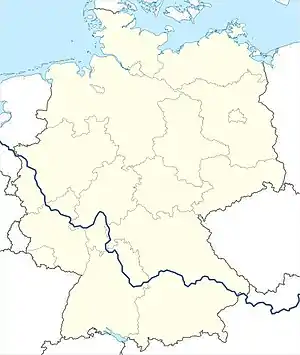

.jpg.webp)

The ethnogenesis of the Germanic tribes remains debated. However, for author Averil Cameron it is obvious that a steady process has occurred during the Nordic Bronze Age, or at the latest during the Pre-Roman Iron Age.[20] From their homes in southern Scandinavia and northern Germany the tribes began expanding south, east and west during the 1st century BC,[21] and came into contact with the Celtic tribes of Gaul, as well as with Iranian,[22] Baltic,[23] and Slavic cultures in Central/Eastern Europe.[24]
Factual and detailed knowledge about the early history of the Germanic tribes is rare. Researchers have to be content with the recordings of the tribes' affairs with the Romans, linguistic conclusions, archaeological discoveries and the rather new yet auspicious results of archaeogenetic study.[25] In the mid-1st century BC, Julius Caesar erected the first known bridges across the Rhine during his campaign in Gaul and led a military contingent across and into the territories of the local Germanic tribes. After several days and having made no contact with Germanic troops (who had retreated inland) Caesar returned to the west of the river.[26] The Suebi tribe under chieftain Ariovistus, had around 60 BC conquered lands of the Gallic Aedui tribe to the west of the Rhine. Consequent plans to populate the region with Germanic settlers from the east were vehemently opposed by Caesar, who had already launched his ambitious campaign to subjugate all Gaul. Julius Caesar confronts and beats the Suebi forces in 58 BC in the Battle of Vosges and forces Ariovist to retreat across the Rhine.[27][28]
Collision with the Roman Empire
Emperor Augustus considered conquest beyond the Rhine and the Danube not only regular foreign policy but also necessary to counter Germanic incursions into a still rebellious Gaul. A series of forts and commercial centers were established along the two rivers. Some tribes, such as the Ubii consequently allied with Rome and readily adopted advanced Roman culture. During the 1st century CE Roman legions conducted extended campaigns into Germania magna, the area north of the Upper Danube and east of the Rhine, attempting to subdue the various tribes. Roman ideas of administration, the imposition of taxes and a legal framework were frustrated by the total absence of an infrastructure. The campaigns of Germanicus, for example were almost exclusively characterized by frequent massacres of villagers and indiscriminate pillaging. The tribes, however maintained their elusive identities. In 9 AD a coalition of tribes under the Cherusci chieftain Arminius, who was familiar with Roman tactical doctrines, defeated a sizeable Roman force in the Battle of the Teutoburg Forest. Consequently, Rome resolved to permanently establish the Rhine/Danube border and refrain from further territorial advance into Germania.[29][30] By AD 100 the frontier along the Rhine and the Danube and the Limes Germanicus was firmly established. Several Germanic tribes lived under Roman rule south and west of the border, as described in Tacitus's Germania. These lands represent the modern states Baden-Württemberg, southern Bavaria, southern Hesse, Saarland and the Rhineland. Austria formed the regular provinces of Noricum and Raetia.[31][32][33] The provinces Germania Inferior (with the capital situated at Colonia Claudia Ara Agrippinensium, modern Cologne) and Germania Superior (with its capital at Mogontiacum, modern Mainz), were formally established in 85 AD, after long and painful campaigns as lasting military control was confined to the lands surrounding the rivers.[34]
The 3rd century saw the emergence of a number of large West Germanic tribes: the Alamanni, Franks, Bavarii, Chatti, Saxons, Frisii, Sicambri, and Thuringii. By the 3rd century the Germanic speaking peoples began to migrate beyond the limes and the Danube frontier.[35] Several large tribes – the Visigoths, Ostrogoths, Vandals, Burgundians, Lombards, Saxons and Franks – migrated and played their part in the decline of the Roman Empire and the transformation of the old Western Roman Empire.[36]
Christianity was introduced to Roman controlled southwestern Germania and Christian religious structures such as the Aula Palatina of Trier were built during the reign of Constantine I (r. (306–337 AD). By the end of the 4th century the Huns invaded eastern and central Europe. The event triggered the Migration Period.[37] Hunnic hegemony over a vast territory in central and eastern Europe lasted until the death of Attila's son Dengizich in 469.[38]
Stem duchies and marches
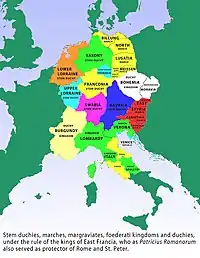
Stem duchies (German: Stammesherzogtümer) in Germany refer to the traditional territory of the various Germanic tribes. The concept of such duchies survived especially in the areas which by the 9th century would constitute East Francia,[39] which included the Duchy of Bavaria, the Duchy of Swabia, the Duchy of Saxony, the Duchy of Franconia and the Duchy of Thuringia,[40] unlike further west the County of Burgundy or Lorraine in Middle Francia.[41] [42] [43]
The Salian emperors (reigned 1027–1125) retained the stem duchies as the major divisions of Germany, but they became increasingly obsolete during the early high-medieval period under the Hohenstaufen, and Frederick Barbarossa finally abolished them in 1180 in favour of more numerous territorial duchies.
Successive kings of Germany founded a series of border counties or marches in the east and the north. These included Lusatia, the North March (which would become Brandenburg and the heart of the future Prussia), and the Billung March. In the south, the marches included Carniola, Styria, and the March of Austria that would become Austria.[44]
Frankish Empire
%252C_Augusta_Treverorum%252C_Trier_(8749080929).jpg.webp)

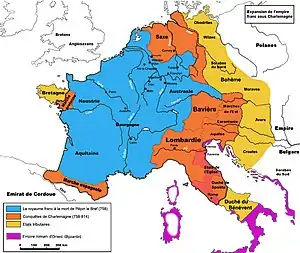
Blue = realm of Pippin III in 758,
Orange = expansion under Charlemagne until 814
Yellow = marches and dependencies
Red = Papal States
After the fall of the Western Roman Empire in the 5th century, the Franks, like other post-Roman Western Europeans, emerged as a tribal confederacy in the Middle Rhine-Weser region, among the territory soon to be called Austrasia (the "eastern land"), the northeastern portion of the future Kingdom of the Merovingian Franks. As a whole, Austrasia comprised parts of present-day France, Germany, Belgium, Luxembourg and the Netherlands. Unlike the Alamanni to their south in Swabia, they absorbed large swaths of former Roman territory as they spread west into Gaul, beginning in 250. Clovis I of the Merovingian dynasty conquered northern Gaul in 486 and in the Battle of Tolbiac in 496 the Alemanni tribe in Swabia, which eventually became the Duchy of Swabia.
By 500, Clovis had united all the Frankish tribes, ruled all of Gaul[45] and was proclaimed King of the Franks between 509 and 511.[46] Clovis, unlike most Germanic rulers of the time, was baptized directly into Roman Catholicism instead of Arianism. His successors would cooperate closely with papal missionaries, among them Saint Boniface. After the death of Clovis in 511, his four sons partitioned his kingdom including Austrasia. Authority over Austrasia passed back and forth from autonomy to royal subjugation, as successive Merovingian kings alternately united and subdivided the Frankish lands.[47]
During the 5th and 6th centuries the Merovingian kings conquered the Thuringii (531 to 532), the Kingdom of the Burgundians and the principality of Metz and defeated the Danes, the Saxons and the Visigoths.[48] King Chlothar I (558 to 561) ruled the greater part of what is now Germany and undertook military expeditions into Saxony, while the South-east of what is modern Germany remained under the influence of the Ostrogoths. Saxons controlled the area from the northern sea board to the Harz Mountains and the Eichsfeld in the south.[49]
The Merovingians placed the various regions of their Frankish Empire under the control of semi-autonomous dukes – either Franks or local rulers,[50] and followed imperial Roman strategic traditions of social and political integration of the newly conquered territories.[51][52] While allowed to preserve their own legal systems,[53] the conquered Germanic tribes were pressured to abandon the Arian Christian faith.[54]
In 718 Charles Martel waged war against the Saxons in support of the Neustrians. In 743 his son Carloman in his role as Mayor of the Palace renewed the war against the Saxons, who had allied with and aided the duke Odilo of Bavaria.[55] The Catholic Franks, who by 750 controlled a vast territory in Gaul, north-western Germany, Swabia, Burgundy and western Switzerland, that included the alpine passes allied with the Curia in Rome against the Lombards, who posed a permanent threat to the Holy See.[45] Pressed by Liutprand, King of the Lombards, a Papal envoy for help had already been sent to the de facto ruler Charles Martel after his victory in 732 over the forces of the Umayyad Caliphate at the Battle of Tours, however a lasting and mutually beneficial alliance would only materialize after Charles' death under his successor Duke of the Franks, Pepin the Short.[56]
In 751 Pippin III, Mayor of the Palace under the Merovingian king, himself assumed the title of king and was anointed by the Church. Pope Stephen II bestowed him the hereditary title of Patricius Romanorum as protector of Rome and St. Peter[57] in response to the Donation of Pepin, that guaranteed the sovereignty of the Papal States. Charles the Great (who ruled the Franks from 774 to 814) launched a decades-long military campaign against the Franks' heathen rivals, the Saxons and the Avars. The campaigns and insurrections of the Saxon Wars lasted from 772 to 804. The Franks eventually overwhelmed the Saxons and Avars, forcibly converted the people to Christianity, and annexed their lands to the Carolingian Empire.
Middle Ages
Foundation of the Holy Roman Empire
After the death of Frankish king Pepin the Short in 768, his oldest son "Charlemagne" ("Charles the Great") consolidated his power over and expanded the Kingdom. Charlemagne ended 200 years of Royal Lombard rule with the Siege of Pavia, and in 774 he installed himself as King of the Lombards. Loyal Frankish nobles replaced the old Lombard aristocracy following a rebellion in 776.[58] The next 30 years of his reign were spent ruthlessly strengthening his power in Francia and on the conquest of the Slavs and Pannonian Avars in the east and all tribes, such as the Saxons and the Bavarians.[59][60] On Christmas Day, 800 AD, Charlemagne was crowned Imperator Romanorum (Emperor of the Romans) in Rome by Pope Leo III.[60]
Fighting among Charlemagne's three grandsons over the continuation of the custom of partible inheritance or the introduction of primogeniture caused the Carolingian empire to be partitioned into three parts by the Treaty of Verdun of 843.[61] Louis the German received the Eastern portion of the kingdom, East Francia, all lands east of the Rhine river and to the north of Italy. This encompassed the territories of the German stem duchies – Franks, Saxons, Swabians, and Bavarians – that were united in a federation under the first non-Frankish king Henry the Fowler, who ruled from 919 to 936.[62] The royal court permanently moved in between a series of strongholds, called Kaiserpfalzen, that developed into economic and cultural centers. Aachen Palace played a central role, as the local Palatine Chapel served as the official site for all royal coronation ceremonies during the entire Medieval period until 1531.[60][63]
- The Holy Roman Empire, maps
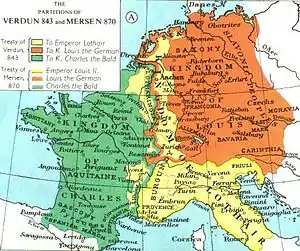 The division of the Carolingian Empire by the Treaty of Verdun in 843
The division of the Carolingian Empire by the Treaty of Verdun in 843 Territorial evolution of the Holy Roman Empire from 962 to 1806
Territorial evolution of the Holy Roman Empire from 962 to 1806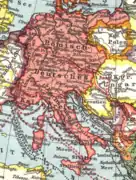 The Holy Roman Empire at its greatest territorial extent under Hohenstaufen emperor Frederick II, 13th century
The Holy Roman Empire at its greatest territorial extent under Hohenstaufen emperor Frederick II, 13th century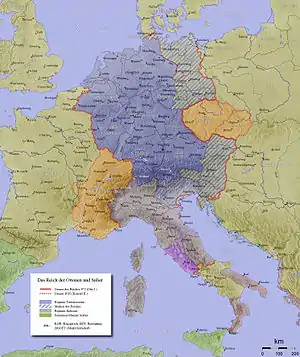
 The Holy Roman Empire around the year 1700
The Holy Roman Empire around the year 1700
Otto the Great
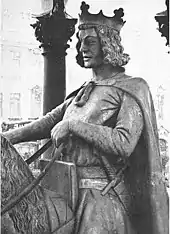
In 936, Otto I was crowned German king at Aachen, in 961 King of Italy in Pavia and crowned emperor by Pope John XII in Rome in 962. The tradition of the German King as protector of the Kingdom of Italy and the Latin Church resulted in the term Holy Roman Empire in the 12th century. The name, that was to identify with Germany continued to be used officially, with the extension added: Nationis Germanicæ (of the German nation) after the last imperial coronation in Rome in 1452 until its dissolution in 1806.[62] Otto strengthened the royal authority by re-asserting the old Carolingian rights over ecclesiastical appointments.[64] Otto wrested from the nobles the powers of appointment of the bishops and abbots, who controlled large land holdings. Additionally, Otto revived the old Carolingian program of appointing missionaries in the border lands. Otto continued to support celibacy for the higher clergy, so ecclesiastical appointments never became hereditary. By granting lands to the abbots and bishops he appointed, Otto actually turned these bishops into "princes of the Empire" (Reichsfürsten).[65] In this way, Otto was able to establish a national church. Outside threats to the kingdom were contained with the decisive defeat of the Hungarian Magyars at the Battle of Lechfeld in 955. The Slavs between the Elbe and the Oder rivers were also subjugated. Otto marched on Rome and drove John XII from the papal throne and for years controlled the election of the pope, setting a firm precedent for imperial control of the papacy for years to come.[66][67]
During the reign of Conrad II's son, Henry III (1039 to 1056), the empire supported the Cluniac reforms of the Church, the Peace of God, prohibition of simony (the purchase of clerical offices), and required celibacy of priests. Imperial authority over the Pope reached its peak. However, Rome reacted with the creation of the College of Cardinals and Pope Gregory VII's series of clerical reforms. Pope Gregory insisted in his Dictatus Papae on absolute papal authority over appointments to ecclesiastical offices. The subsequent conflict in which emperor Henry IV was compelled to submit to the Pope at Canossa in 1077, after having been excommunicated came to be known as the Investiture Controversy. In 1122 a temporary reconciliation was reached between Henry V and the Pope with the Concordat of Worms. With the conclusion of the dispute the Roman church and the papacy regained supreme control over all religious affairs.[68][69] Consequentlly the imperial Ottonian church system (Reichskirche) declined. It also ended the royal/imperial tradition of appointing selected powerful clerical leaders to counter the Imperial secular princes.[70]
Between 1095 and 1291 the various campaigns of the crusades to the Holy Land took place. Knightly religious orders were established, including the Knights Templar, the Knights of St John (Knights Hospitaller), and the Teutonic Order.[71][72]
The term sacrum imperium (Holy Empire) was first used officially by Friedrich I in 1157,[73] but the words Sacrum Romanum Imperium, Holy Roman Empire, were only combined in July 1180 and would never consistently appear on official documents from 1254 onwards.[74]
Hanseatic League
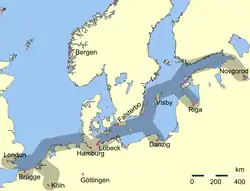
The Hanseatic League was a commercial and defensive alliance of the merchant guilds of towns and cities in northern and central Europe that dominated marine trade in the Baltic Sea, the North Sea and along the connected navigable rivers during the Late Middle Ages ( 12th to 15th centuries ). Each of the affiliated cities retained the legal system of its sovereign and, with the exception of the Free imperial cities, had only a limited degree of political autonomy.[75] Beginning with an agreement of the cities of Lübeck and Hamburg, guilds cooperated in order to strengthen and combine their economic assets, like securing trading routes and tax privileges, to control prices and better protect and market their local commodities. Important centers of commerce within the empire, such as Cologne on the Rhine river and Bremen on the North Sea joined the union, which resulted in greater diplomatic esteem.[76] Recognized by the various regional princes for the great economic potential, favorable charters for, often exclusive, commercial operations were granted.[77] During its zenith the alliance maintained trading posts and kontors in virtually all cities between London and Edinburgh in the west to Novgorod in the east and Bergen in Norway. By the late 14th century the powerful league enforced its interests with military means, if necessary. This culminated in a war with the sovereign Kingdom of Denmark from 1361 to 1370. Principal city of the Hanseatic League remained Lübeck, where in 1356 the first general diet was held and its official structure was announced. The league declined after 1450 due to a number of factors, such as the 15th-century crisis, the territorial lords' shifting policies towards greater commercial control, the silver crisis and marginalization in the wider Eurasian trade network, among others.[78][79]
Eastward expansion
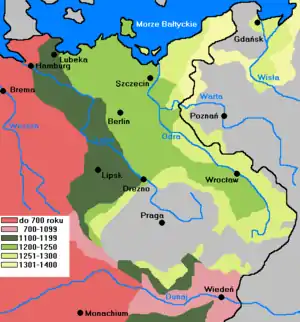
The Ostsiedlung (lit. Eastern settlement) is the term for a process of largely uncoordinated immigration and chartering of settlement structures by ethnic Germans into territories, already inhabited by Slavs and Balts east of the Saale and Elbe rivers, such as modern Poland and Silesia and to the south into Bohemia, modern Hungary and Romania during the High Middle Ages from the 11th to the 14th century.[80][81] The primary purpose of the early imperial military campaigns into the lands to the east during the 10th and 11th century, was to punish and subjugate the local heathen tribes. Conquered territories were mostly lost after the troops had retreated, but eventually were incorporated into the empire as marches, fortified borderlands with garrisoned troops in strongholds and castles, who were to ensure military control and enforce the exaction of tributes. Contemporary sources do not support the idea of policies or plans for the organized settlement of civilians.[82]
Emperor Lothair II re-established feudal sovereignty over Poland, Denmark and Bohemia since 1135 and appointed margraves to turn the borderlands into hereditary fiefs and install a civilian administration. There is no discernible chronology of the immigration process as it took place in many individual efforts and stages, often even encouraged by the Slavic regional lords. However, the new communities were subjected to German law and customs. Total numbers of settlers were generally rather low and, depending on who held a numerical majority, populations usually assimilated into each other. In many regions only enclaves would persist, like Hermannstadt, founded by the Transylvanian Saxons in the medieval Hungarian Kingdom(today in Romania) who called on by Geza II. in 1147[Saxons called those part of Transylvania as "Altland" to distinguish it from later immigrant Saxon settlements what established about 1220 by Teutonic Order][83][84]
In 1230 the Catholic monastic order of the Teutonic Knights launched the Prussian Crusade. The campaign, that was supported by the forces of Polish duke Konrad I of Masovia, initially intended to Christianize the Baltic Old Prussians, succeeded primarily in the conquest of large territories. The order, emboldened by imperial approval, quickly resolved to establish an independent state, without the consent of duke Konrad. Recognizing only papal authority and based on a solid economy, the order steadily expanded the Teutonic state during the following 150 years, engaging in several land disputes with its neighbors. Permanent conflicts with the Kingdom of Poland, the Grand Duchy of Lithuania, and the Novgorod Republic, eventually led to military defeat and containment by the mid-15th century. The last Grand Master Albert of Brandenburg converted to Lutheranism in 1525 and turned the remaining lands of the order into the secular Duchy of Prussia.[85][86]
Church and state
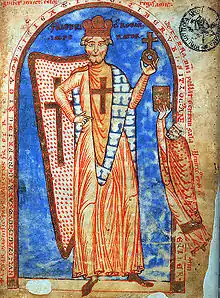

left to right: Archbishop of Cologne, Archbishop of Mainz, Archbishop of Trier, Count Palatine, Duke of Saxony, Margrave of Brandenburg and King of Bohemia (Codex Balduini Trevirorum, c. 1340)
.jpg.webp)
Henry V (1086–1125), great-grandson of Conrad II, who had overthrown his father Henry IV became Holy Roman Emperor in 1111. Hoping to gain greater control over the church inside the Empire, Henry V appointed Adalbert of Saarbrücken as the powerful archbishop of Mainz in the same year. Adalbert began to assert the powers of the Church against secular authorities, that is, the Emperor. This precipitated the "Crisis of 1111" as yet another chapter of the long-term Investiture Controversy.[87] In 1137 the prince-electors turned back to the Hohenstaufen family for a candidate, Conrad III. Conrad tried to divest his rival Henry the Proud of his two duchies—Bavaria and Saxony—that led to war in southern Germany as the empire was divided into two powerful factions. The faction of the Welfs or Guelphs (in Italian) supported the House of Welf of Henry the Proud, which was the ruling dynasty in the Duchy of Bavaria. The rival faction of the Waiblings or Ghibellines (in Italian) pledged allegiance to the Swabian House of Hohenstaufen. During this early period, the Welfs generally maintained ecclesiastical independence under the papacy and political particularism (the focus on ducal interests against the central imperial authority). The Waiblings, on the other hand, championed strict control of the church and a strong central imperial government.[88]
During the reign of the Hohenstaufen emperor Frederick I (Barbarossa), an accommodation was reached in 1156 between the two factions. The Duchy of Bavaria was returned to Henry the Proud's son Henry the Lion, duke of Saxony, who represented the Guelph party. However, the Margraviate of Austria was separated from Bavaria and turned into the independent Duchy of Austria by virtue of the Privilegium Minus in 1156.[89]
Having become wealthy through trade, the confident cities of Northern Italy, supported by the Pope, increasingly opposed Barbarossa's claim of feudal rule (Honor Imperii) over Italy. The cities united in the Lombard League and finally defeated Barbarossa in the Battle of Legnano in 1176. The following year a reconciliation was reached between the emperor and Pope Alexander III in the Treaty of Venice.[90] The 1183 Peace of Constance eventually settled that the Italian cities remained loyal to the empire but were granted local jurisdiction and full regal rights in their territories.[91]
In 1180, Henry the Lion was outlawed, Saxony was divided, and Bavaria was given to Otto of Wittelsbach, who founded the Wittelsbach dynasty, which was to rule Bavaria until 1918.)
From 1184 to 1186, the empire under Frederick I Barbarossa reached its cultural peak with the Diet of Pentecost held at Mainz and the marriage of his son Henry in Milan to the Norman princess Constance of Sicily.[92] The power of the feudal lords was undermined by the appointment of ministerials (unfree servants of the Emperor) as officials. Chivalry and the court life flowered, as expressed in the scholastic philosophy of Albertus Magnus and the literature of Wolfram von Eschenbach.[93]
Between 1212 and 1250, Frederick II established a modern, professionally administered state from his base in Sicily. He resumed the conquest of Italy, leading to further conflict with the Papacy. In the Empire, extensive sovereign powers were granted to ecclesiastical and secular princes, leading to the rise of independent territorial states. The struggle with the Pope sapped the Empire's strength, as Frederick II was excommunicated three times. After his death, the Hohenstaufen dynasty fell, followed by an interregnum during which there was no Emperor(1250-1273)until elected a small Swabian count, Rudolf of Habsburg as emperor.[94][95]
The failure of negotiations between Emperor Louis IV and the papacy led to the 1338 Declaration at Rhense by six princes of the Imperial Estate to the effect that election by all or the majority of the electors automatically conferred the royal title and rule over the empire, without papal confirmation. As result, the monarch was no longer subject to papal approbation and became increasingly dependent on the favour of the electors. Between 1346 and 1378 Emperor Charles IV of Luxembourg, king of Bohemia, sought to restore imperial authority. The 1356 decree of the Golden Bull stipulated that all future emperors were to be chosen by a college of only seven – four secular and three clerical – electors. The secular electors were the King of Bohemia, the Count Palatine of the Rhine, the Duke of Saxony, and the Margrave of Brandenburg, the clerical electors were the Archbishops of Mainz, Trier, and Cologne.[96]
Between 1347 and 1351 Germany and almost the entire European continent were consumed by the most severe outbreak of the Black Death pandemic. Estimated to have caused the abrupt death of 30 to 60% of Europe's population, it led to widespread social and economic disruption and deep religious disaffection and fanaticism. Minority groups, and Jews in particular were blamed, singled out and attacked. As a consequence, many Jews fled and resettled in Eastern Europe.[97][98]
Change and reform
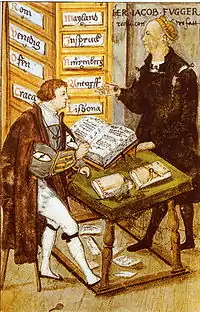
The early-modern European society gradually developed after the disasters of the 14th century as religious obedience and political loyalties declined in the wake of the Great Plague, the schism of the Church and prolonged dynastic wars. The rise of the cities and the emergence of the new burgher class eroded the societal, legal and economic order of feudalism.[99] The commercial enterprises of the mercantile patriciate family of the Fuggers of Augsburg generated unprecedented financial means. As financiers to both the leading ecclesiastical and secular rulers, the Fuggers fundamentally influenced the political affairs in the empire during the 15th and 16th century.[100] The increasingly money based economy also provoked social discontent among knights and peasants and predatory "robber knights" became common. The knightly classes had traditionally established their monopoly through warfare and military skill. However, the shift to practical mercenary infantry armies and military-technical advances led to a marginalization of heavy cavalry.[101]
From 1438 the Habsburg dynasty, who had acquired control in the south-eastern empire over the Duchy of Austria, Bohemia and Hungary after the death of King Louis II in 1526, managed to permanently occupy the position of the Holy Roman Emperor until 1806 (with the exception of the years between 1742 and 1745). However, this strict policy of dynastic rule over a vast multi-ethnic territory, prevented the development of concepts of patriotism and unity among the empire's territorial rulers and a national identity as in France and England.
During his reign from 1493 to 1519, Maximilian I tried to reform the empire. An Imperial supreme court (Reichskammergericht) was established, imperial taxes were levied, and the power of the Imperial Diet (Reichstag) was increased. The reforms, however, were frustrated by the continued territorial fragmentation of the Empire.[102]
Towns and cities
Total population estimates of the German territories range around 5 to 6 million by the end of Henry III's reign in 1056 and about 7 to 8 million after Friedrich Barabarossa's rule in 1190.[103][104] The vast majority were farmers, typically in a state of serfdom under feudal lords and monasteries.[88] Towns gradually emerged and in the 12th century many new cities were founded along the trading routes and near imperial strongholds and castles. The towns were subjected to the municipal legal system. Cities such as Cologne, that had acquired the status of Imperial Free Cities, were no longer answerable to the local landlords or bishops, but immediate subjects of the Emperor and enjoyed greater commercial and legal liberties.[105] The towns were ruled by a council of the – usually mercantile – elite, the patricians. Craftsmen formed guilds, governed by strict rules, which sought to obtain control of the towns; a few were open to women. Society had diversified, but was divided into sharply demarcated classes of the clergy, physicians, merchants, various guilds of artisans, unskilled day labourers and peasants. Full citizenship was not available to paupers. Political tensions arose from issues of taxation, public spending, regulation of business, and market supervision, as well as the limits of corporate autonomy.[106]
Cologne's central location on the Rhine river placed it at the intersection of the major trade routes between east and west and was the basis of Cologne's growth.[107] The economic structures of medieval and early modern Cologne were characterized by the city's status as a major harbor and transport hub upon the Rhine. It was the seat of an archbishop, under whose patronage the vast Cologne Cathedral was built since 1240. The cathedral houses sacred Christian relics and since it has become a well known pilgrimage destination. By 1288 the city had secured its independence from the archbishop (who relocated to Bonn), and was ruled by its burghers.[108]
- Towns and cities of the Medieval and Early Modern Holy Roman Empire
 Cologne, around 1411
Cologne, around 1411 Munich, Nuremberg Chronicle, 1493
Munich, Nuremberg Chronicle, 1493 Regensburg, in 1572
Regensburg, in 1572 Nordhausen, 17th century
Nordhausen, 17th century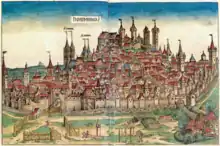 Nuremberg, in 1493
Nuremberg, in 1493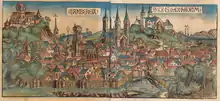 Bamberg, Nuremberg Chronicle, 1493
Bamberg, Nuremberg Chronicle, 1493
Women
From the early medieval period and continuing through to the 18th century, Germanic law assigned women to a subordinate and dependent position relative to men. Salic (Frankish) law, from which the laws of the German lands would be based, placed women at a disadvantage with regard to property and inheritance rights. Germanic widows required a male guardian to represent them in court. Unlike Anglo-Saxon law or the Visigothic Code, Salic law barred women from royal succession. Social status was based on military and biological roles, a reality demonstrated in rituals associated with newborns, when female infants were given a lesser value than male infants. The use of physical force against wives was condoned until the 18th century in Bavarian law.[109][110]
Some women of means asserted their influence during the Middle Ages, typically in royal court or convent settings. Hildegard of Bingen, Gertrude the Great, Elisabeth of Bavaria (1478–1504), and Argula von Grumbach are among the women who pursued independent accomplishments in fields as diverse as medicine, music composition, religious writing, and government and military politics.
Learning and culture
Benedictine abbess Hildegard von Bingen (1098–1179) wrote several influential theological, botanical, and medicinal texts, as well as letters, liturgical songs, poems, and arguably the oldest surviving morality play, while supervising brilliant miniature Illuminations. About 100 years later, Walther von der Vogelweide (c. 1170 – c. 1230) became the most celebrated of the Middle High German lyric poets.
Around 1439, Johannes Gutenberg of Mainz, used movable type printing and issued the Gutenberg Bible. He was the global inventor of the printing press, thereby starting the Printing Revolution. Cheap printed books and pamphlets played central roles for the spread of the Reformation and the Scientific Revolution.
Around the transition from the 15th to the 16th century, Albrecht Dürer from Nuremberg established his reputation across Europe as painter, printmaker, mathematician, engraver, and theorist when he was still in his twenties and secured his reputation as one of the most important figures of the Northern Renaissance.
The addition Nationis Germanicæ (of German Nation) to the emperor's title appeared first in the 15th century: in a 1486 law decreed by Frederick III and in 1512 in reference to the Imperial Diet in Cologne by Maximilian I. By then, the emperors had lost their influence in Italy and Burgundy. In 1525, the Heilbronn reform plan – the most advanced document of the German Peasants' War (Deutscher Bauernkrieg) – referred to the Reich as von Teutscher Nation (of German nation).
- influential German speaking authors, artists and scholars of the Late Middle Ages and the Renaissance
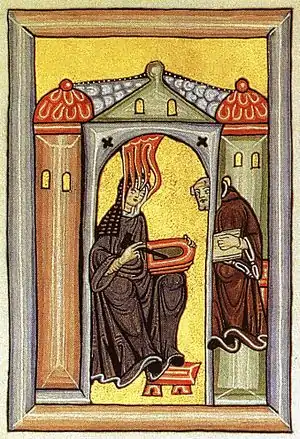 Hildegard von Bingen (1098–1179), Benedictine abbess, philosopher, author, artist and visionary naturalist
Hildegard von Bingen (1098–1179), Benedictine abbess, philosopher, author, artist and visionary naturalist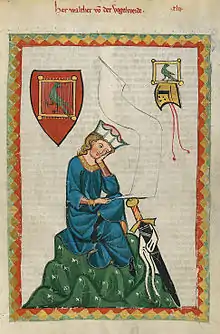
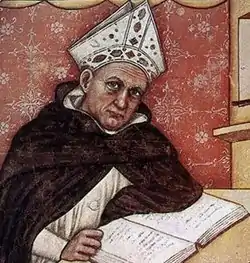 Albertus Magnus (c. 1193–1280), bishop, philosopher, theologian, Doctor of the Church
Albertus Magnus (c. 1193–1280), bishop, philosopher, theologian, Doctor of the Church Johannes Gutenberg (c. 1398–1468), pioneering user of the printing press with movable types
Johannes Gutenberg (c. 1398–1468), pioneering user of the printing press with movable types.jpg.webp) Albrecht Dürer (1471–1528), one of the most influential artists of the Northern Renaissance
Albrecht Dürer (1471–1528), one of the most influential artists of the Northern Renaissance Tilman Riemenschneider (c. 1460–1531), most accomplished sculptor, woodcarver and master in stone from the late Gothic to the Renaissance
Tilman Riemenschneider (c. 1460–1531), most accomplished sculptor, woodcarver and master in stone from the late Gothic to the Renaissance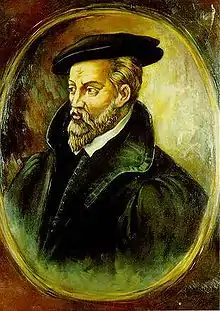
Early modern Germany
- See List of states in the Holy Roman Empire for subdivisions and the political structure
Protestant Reformation
-en.png.webp)
.svg.png.webp)
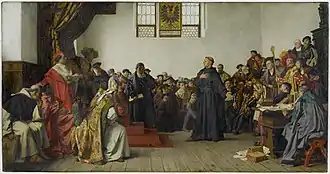
In order to manage their ever growing expenses, the Renaissance Popes of the 15th and early 16th century promoted the excessive sale of indulgences and offices and titles of the Roman Curia.
In 1517, the monk Martin Luther published a pamphlet with 95 Theses that he posted in the town square of Wittenberg and handed copies to feudal lords. Whether he nailed them to a church door at Wittenberg remains unclear. The list detailed 95 assertions, he argued, represented corrupt practice of the Christian faith and misconduct within the Catholic Church. Although perhaps not Luther's chief concern, he received popular support for his condemnation of the sale of indulgences and clerical offices, the pope's and higher clergy's abuse of power and his doubts of the very idea of the institution of the Church and the papacy.[111]
The Protestant Reformation was the first successful challenge to the Catholic Church and began in 1521 as Luther was outlawed at the Diet of Worms after his refusal to repent. The ideas of the reformation spread rapidly, as the new technology of the modern printing press ensured cheap mass copies and distribution of the theses and helped by the Emperor Charles V's wars with France and the Turks.[111] Hiding in the Wartburg Castle, Luther translated the Bible into German, thereby greatly contributing to the establishment of the modern German language. This is highlighted by the fact that Luther spoke only a local dialect of minor importance during that time. After the publication of his Bible, his dialect suppressed others and constitutes to a great extent what is now modern German. With the protestation of the Lutheran princes at the Imperial Diet of Speyer in 1529 and the acceptance and adoption of the Lutheran Augsburg Confession by the Lutheran princes beginning in 1530, the separate Lutheran church was established.[112]
The 1524/25 German Peasants' War, that began in the southwest in Alsace and Swabia and spread further east into Franconia, Thuringia and Austria, was a series of economic and religious revolts of the rural lower classes, encouraged by the rhethoric of various radical religious reformers and Anabaptists against the ruling feudal lords. Although occasionally assisted by war-experienced noblemen like Götz von Berlichingen and Florian Geyer (in Franconia) and the theologian Thomas Müntzer (in Thuringia), the peasant forces lacked military structure, skill, logistics and equipment and as many as 100,000 insurgents were eventually defeated and massacred by the territorial princes.[113]
The Catholic Counter-Reformation, initiated in 1545 at the Council of Trent was spearheaded by the scholarly religious Jesuit order, that was founded just five years prior by several clerics around Ignatius of Loyola. Its intent was to challenge and contain the Protestant Reformation via apologetic and polemical writings and decrees, ecclesiastical reconfiguration, wars and imperial political maneuverings. In 1547 emperor Charles V defeated the Schmalkaldic League, a military alliance of Protestant rulers.[114] The 1555 Peace of Augsburg decreed the recognition of the Lutheran Faith and religious division of the empire. It also stipulated the ruler's right to determine the official confession in his principality (Cuius regio, eius religio). The Counter-Reformation eventually failed to reintegrate the central and northern German Lutheran states. In 1608/1609 the Protestant Union and the Catholic League were formed.
Thirty Years' War, 1618–1648

The 1618 to 1648 Thirty Years' War, that took place almost exclusively in the Holy Roman Empire has its origins, that remain widely debated, in the unsolved and recurring conflicts of the Catholic and Protestant factions. The Catholic emperor Ferdinand II attempted to achieve the religious and political unity of the empire, while the opposing Protestant Union forces were determined to defend their religious rights. The religious motive served as the universal justification for the various territorial and foreign princes, who over the course of several stages joined either of the two warring parties in order to gain land and power.[115][116]
The conflict was sparked by the revolt of the Protestant nobility of Bohemia against emperor Matthias' succession policies. After imperial triumph at the Battle of White Mountain and a short-lived peace, the war grew to become a political European conflict by the intervention of King Christian IV of Denmark from 1625 to 1630, Gustavus Adolphus of Sweden from 1630 to 1648 and France under Cardinal Richelieu from 1635 to 1648. The conflict increasingly evolved into a struggle between the French House of Bourbon and the House of Habsburg for predominance in Europe, for which the central German territories of the empire served as the battleground.[117]
The war ranks among the most catastrophic in history as three decades of constant warfare and destruction had left the land devastated. Marauding armies incessantly pillaged the countryside, seized and levied heavy taxes on cities and indiscriminately plundered the food stocks of the peasantry. There were also the countless bands of murderous outlaws, sick, homeless, disrupted people and invalid soldiery. Overall social and economic disruption caused a dramatic decline in population as a result of pandemic murder and random rape and killings, endemic infectious diseases, crop failures, famine, declining birth rates, wanton burglary, witch-hunts and the emigration of terrified people. Estimates vary between a 38% drop from 16 million people in 1618 to 10 million by 1650 and a mere 20% drop from 20 million to 16 million. The Altmark and Württemberg regions were especially hard hit, where it took generations to fully recover.[118][116]
The war was the last major religious struggle in mainland Europe and ended in 1648 with the Peace of Westphalia. It resulted in increased autonomy for the constituent states of the Holy Roman Empire, limiting the power of the emperor. Alsace was permanently lost to France, Pomerania was temporarily lost to Sweden, and the Netherlands officially left the Empire.[119]
Culture and literacy
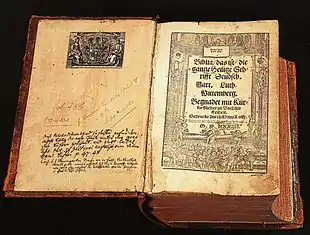
The population of Germany reached about twenty million people by the mid-16th century, the great majority of whom were peasant farmers.[120]
The Protestant Reformation was a triumph for literacy and the new printing press. Luther's translation of the Bible into German was a decisive impulse for the increase of literacy and stimulated printing and distribution of religious books and pamphlets. From 1517 onward religious pamphlets flooded Germany and much of Europe. The Reformation instigated a media revolution as by 1530 over 10,000 individual works are published with a total of ten million copies. Luther strengthened his attacks on Rome by depicting a "good" against "bad" church. It soon became clear that print could be used for propaganda in the Reformation for particular agendas. Reform writers used pre-Reformation styles, clichés, and stereotypes and changed items as needed for their own purposes.[121] Especially effective were Luther's Small Catechism, for use of parents teaching their children, and Larger Catechism, for pastors.[122] Using the German vernacular they expressed the Apostles' Creed in simpler, more personal, Trinitarian language. Illustrations in the newly translated Bible and in many tracts popularized Luther's ideas. Lucas Cranach the Elder (1472–1553), the great painter patronized by the electors of Wittenberg, was a close friend of Luther, and illustrated Luther's theology for a popular audience. He dramatized Luther's views on the relationship between the Old and New Testaments, while remaining mindful of Luther's careful distinctions about proper and improper uses of visual imagery.[123]
Luther's German translation of the Bible was also decisive for the German language and its evolution from Early New High German to Modern Standard. His bible promoted the development of non-local forms of language and exposed all speakers to forms of German from outside their own area.
Science
The German astronomical community played a central role in Europe in the early modern period. Several non-German scientists contributed to the community, such as Copernicus, the instigator of the scientific revolution who lived in Royal Prussia, a dependency of the King of Poland and Tycho Brahe, who worked in Denmark and Bohemia. Astronomer Johannes Kepler from Weil der Stadt was one of the pioneering minds of empirical and rational research. Through rigorous application of the principles of the Scientific method he construed his laws of planetary motion. His ideas influenced contemporary Italian scientist Galileo Galilei and provided fundamental mechanical principles for Isaac Newton's theory of universal gravitation.
- Scientists, scholars and artists of the Early modern period in Germany
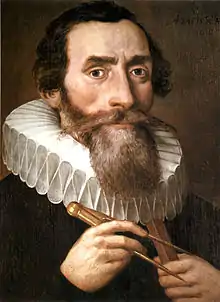 Johannes Kepler (1571–1630), astronomer and mathematician
Johannes Kepler (1571–1630), astronomer and mathematician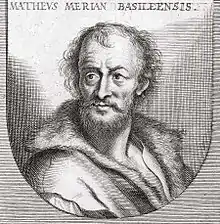 Matthäus Merian (1593–1650), engraver, painter and publisher, member of the Merian family
Matthäus Merian (1593–1650), engraver, painter and publisher, member of the Merian family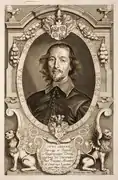 Otto von Guericke (1602–1686), scientist, inventor and politician, famous for demonstrating the power of atmospheric pressure with the Magdeburg hemispheres
Otto von Guericke (1602–1686), scientist, inventor and politician, famous for demonstrating the power of atmospheric pressure with the Magdeburg hemispheres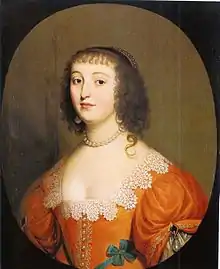 Elisabeth of the Palatinate (1618–1680), philosopher, critic of René Descartes' dualistic metaphysics
Elisabeth of the Palatinate (1618–1680), philosopher, critic of René Descartes' dualistic metaphysics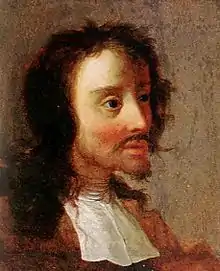 Hans Jakob Christoffel von Grimmelshausen (1621/22–1676), author of the novel Simplicius Simplicissimus
Hans Jakob Christoffel von Grimmelshausen (1621/22–1676), author of the novel Simplicius Simplicissimus Gottfried Wilhelm Leibniz (1646–1716), philosopher and mathematician
Gottfried Wilhelm Leibniz (1646–1716), philosopher and mathematician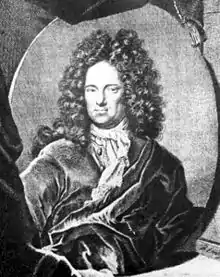 Ehrenfried Walther von Tschirnhaus (1651–1708), mathematician, physicist, physician, philosopher, co-inventor of European porcelain
Ehrenfried Walther von Tschirnhaus (1651–1708), mathematician, physicist, physician, philosopher, co-inventor of European porcelain
1648–1815
Rise of Prussia
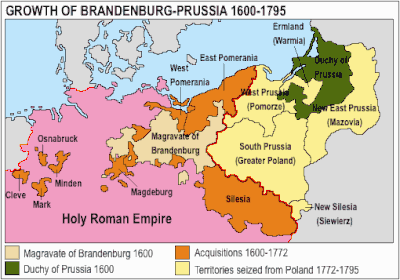
In 1640, Frederick William, also called the Great Elector, became ruler of Brandenburg-Prussia and immediately threw off his vassalage under the Kingdom of Poland and reorganized his loose and scattered territories. In 1648 he acquired East Pomerania via the treaty of Territorial Adjustments in the Peace of Westphalia.[124] King Frederick William I, known as the Soldier King, who reigned from 1713 to 1740, established the structures for the highly centralized future Prussian state and raised a standing army, that was to play a central role. In order to address the demographic problem of Prussia's largely rural population of about three million, the immigration and settlement of French Huguenots in urban areas, of whom many were craftsmen, was supported.[124]
The total population of Germany (in its 1914 territorial extent) grew from 16 million in 1700 to 17 million in 1750 and reached 24 million in 1800. The 18th-century economy noticeably profited from widespread practical application of the Scientific method as greater yields and a more reliable agricultural production and the introduction of hygienic standards positively affected the birth rate – death rate balance.[125]
Wars
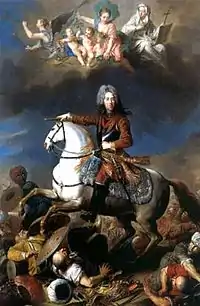
Louis XIV of France waged a series of successful wars in order to extend the French territory. He conquered Alsace and Lorraine (1678–1681) that included the free imperial city of Straßburg and invaded the Electorate of the Palatinate (1688–1697) in the War of the Grand Alliance.[126] Louis established a number of courts whose sole function was to reinterpret historic decrees and treaties, the Treaties of Nijmegen (1678) and the Peace of Westphalia (1648) in particular in favor of his policies of conquest. He considered the conclusions of these courts, the Chambres de réunion as sufficient justification for his boundless annexations. Louis' forces operated inside the Holy Roman Empire largely unopposed, because all available imperial contingents fought in Austria in the Great Turkish War. The Grand Alliance of 1689 took up arms against France and countered any further military advances of Louis. The conflict ended in 1697 as both parties agreed to peace talks after either side had realized, that a total victory was financially unattainable. The Treaty of Ryswick provided for the return of the Electorate of the Palatinate to the empire.[127]
After the last-minute relief of Vienna from a siege and the imminent seizure by a Turkish force in 1683, the combined troops of the Holy League, that had been founded the following year, embarked on the military containment of the Ottoman Empire and reconquered Hungary in 1687.[128] The Papal States, the Holy Roman Empire, the Polish–Lithuanian Commonwealth, the Republic of Venice and since 1686 Russia had joined the league under the leadership of Pope Innocent XI. Prince Eugene of Savoy, who served under emperor Leopold I, took supreme command in 1697 and decisively defeated the Ottomans in a series of spectacular battles and manoeuvres. The 1699 Treaty of Karlowitz marked the end of the Great Turkish War and Prince Eugene continued his service for the Habsburg Monarchy as president of the War Council. He effectively ended Turkish rule over most of the territorial states in the Balkans during the Austro-Turkish War of 1716–18. The Treaty of Passarowitz left Austria to freely establish royal domains in Serbia and the Banat and maintain hegemony in Southeast Europe, on which the future Austrian Empire was based.[129][130]
Enlightened absolutism
_-_Google_Art_Project.jpg.webp)
Frederick II "the Great" is best known for his military genius and unique utilisation of the highly organized army to make Prussia one of the great powers in Europe as well as escaping from almost certain national disaster at the last minute. However he was also an artist, author and philosopher, who conceived and promoted the concept of Enlightened absolutism. 19th-century historians created the romantic image of the glorified warrior and accomplished leader and he served as heroic role model for an aggressive Germany militarism down to 1945 and beyond.[131][132]
Austrian empress Maria Theresa succeeded in bringing about a favorable conclusion for her in the 1740 to 1748 war for recognition of her succession to the throne. However, Silesia was permanently lost to Prussia as a consequence of the Silesian Wars and the Seven Years' War. The 1763 Treaty of Hubertusburg ruled that Austria and Saxony had to relinquish all claims to Silesia. Prussia, that had nearly doubled its territory was eventually recognized as a great European power with the consequence that the politics of the following century were fundamentally influenced by German dualism, the rivalry of Austria and Prussia for supremacy in Central Europe.[133]
The concept of Enlightened absolutism, although rejected by the nobility and citizenry, was advocated in Prussia and Austria and implemented since 1763. Prussian king Frederick II defended the idea in an essay and argued that the benevolent monarch simply is the first servant of the state, who effects his absolute political power for the benefit of the population as a whole. A number of legal reforms (e.g. the abolition of torture and the emancipation of the rural population and the Jews), the reorganization of the Prussian Academy of Sciences, the introduction of compulsory education for boys and girls and promotion of religious tolerance, among others, caused rapid social and economic development.[134]
During 1772 to 1795 Prussia instigated the partitions of Poland by occupying the western territories of the former Polish–Lithuanian Commonwealth. Austria and Russia resolved to acquire the remaining lands with the effect that Poland ceased to exist as a sovereign state until 1918.[135]
Smaller states
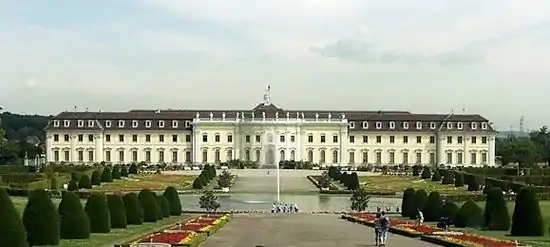

Completely overshadowed by Prussia and Austria, according to historian Hajo Holborn, the smaller German states were generally characterized by political lethargy and administrative inefficiency, often compounded by rulers who were more concerned with their mistresses and their hunting dogs than with the affairs of state. Bavaria was especially unfortunate in this regard; it was a rural land with very heavy debts and few growth centers. Saxony was in economically good shape, although its government was seriously mismanaged, and numerous wars had taken their toll. During the time when Prussia rose rapidly within Germany, Saxony was distracted by foreign affairs. The house of Wettin concentrated on acquiring and then holding on to the Polish throne which was ultimately unsuccessful. In Württemberg the duke lavished funds on palaces, mistresses, great celebration, and hunting expeditions. Many of the city-states of Germany were run by bishops, who in reality were from powerful noble families and showed scant interest in religion. None developed a significant reputation for good government.[136]
In Hesse-Kassel, the Landgrave Frederick II, ruled 1760–1785 as an enlightened despot, and raised money by renting soldiers (called "Hessians") to Great Britain to help fight the American Revolutionary War. He combined Enlightenment ideas with Christian values, cameralist plans for central control of the economy, and a militaristic approach toward diplomacy.[137]
Hanover did not have to support a lavish court—its rulers were also kings of England and resided in London. George III, elector (ruler) from 1760 to 1820, never once visited Hanover. The local nobility who ran the country opened the University of Göttingen in 1737; it soon became a world-class intellectual center. Baden sported perhaps the best government of the smaller states. Karl Friedrich ruled well for 73 years (1738–1811) and was an enthusiast for The Enlightenment; he abolished serfdom in 1783.[138]
The smaller states failed to form coalitions with each other, and were eventually overwhelmed by Prussia.[136] Between 1807 and 1871, Prussia swallowed up many of the smaller states, with minimal protest, then went on to found the German Empire. In the process, Prussia became too heterogeneous, lost its identity, and by the 1930s had become an administrative shell of little importance.
Nobility
The nobility represented the first estate in a typical early modern kingdom of Christian Europe, with Germany being no exception. The empire's pluralistic character also applied to its nobility, that greatly varied in power and wealth, ideas, ambition, loyalty and education. However, there existed the distinction between the Imperial nobility, the direct vassals of the emperor and the Territorial nobility, who have received their fief from the territorial princes.[139] Many of whom had been impoverished as their standard of life and culture had declined since the end of the Medieval period. In an ever more complex economy, they struggled to compete with the patricians and merchants of the cities. The Thirty Years' War marked the reversal of fortunes for those noblemen, who seized the initiative and had understood the requirements of higher education for a lucrative position in the post-war territorial administration. In the Prussian lands east of the Elbe river the system of manorial jurisdiction guaranteed near universal legal power and economic freedom for the local lords, called Junkers, who dominated not only the localities, but also the Prussian court, and especially the Prussian army. Increasingly after 1815, a centralized Prussian government based in Berlin took over the powers of the nobles, which in terms of control over the peasantry had been almost absolute. To help the nobility avoid indebtedness, Berlin set up a credit institution to provide capital loans in 1809, and extended the loan network to peasants in 1849. When the German Empire was established in 1871, the Junker nobility controlled the army and the Navy, the bureaucracy, and the royal court; they generally set governmental policies.[140]
Peasants and rural life
Peasants continued to center their lives in the village, where they were members of a corporate body, and to help manage the community resources and monitor the community life. In the East, they were serfs who were bound permanently to parcels of land. In most of Germany, farming was handled by tenant farmers who paid rents and obligatory services to the landlord, who was typically a nobleman. Peasant leaders supervised the fields and ditches and grazing rights, maintained public order and morals, and supported a village court which handled minor offenses. Inside the family the patriarch made all the decisions, and tried to arrange advantageous marriages for his children. Much of the villages' communal life centered around church services and holy days. In Prussia, the peasants drew lots to choose conscripts required by the army. The noblemen handled external relationships and politics for the villages under their control, and were not typically involved in daily activities or decisions.[141][142]
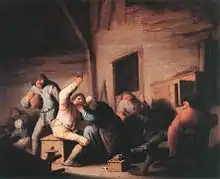
The emancipation of the serfs came in 1770–1830, beginning with Schleswig in 1780. The peasants were now ex-serfs and could own their land, buy and sell it, and move about freely. The nobles approved for now they could buy land owned by the peasants. The chief reformer was Baron vom Stein (1757–1831), who was influenced by The Enlightenment, especially the free market ideas of Adam Smith.[143] The end of serfdom raised the personal legal status of the peasantry. A bank was set up so that landowners could borrow government money to buy land from peasants (the peasants were not allowed to use it to borrow money to buy land until 1850). The result was that the large landowners obtained larger estates, and many peasants became landless tenants, or moved to the cities or to America. The other German states imitated Prussia after 1815. In sharp contrast to the violence that characterized land reform in the French Revolution, Germany handled it peacefully. In Schleswig the peasants, who had been influenced by the Enlightenment, played an active role; elsewhere they were largely passive. Indeed, for most peasants, customs and traditions continued largely unchanged, including the old habits of deference to the nobles whose legal authority remained quite strong over the villagers. Although the peasants were no longer tied to the same land as serfs had been, the old paternalistic relationship in East Prussia lasted into the 20th century.[141]
The agrarian reforms in northwestern Germany in the era 1770–1870 were driven by progressive governments and local elites. They abolished feudal obligations and divided collectively owned common land into private parcels and thus created a more efficient market-oriented rural economy, which increased productivity and population growth and strengthened the traditional social order because wealthy peasants obtained most of the former common land, while the rural proletariat was left without land; many left for the cities or America. Meanwhile, the division of the common land served as a buffer preserving social peace between nobles and peasants.[144] In the east the serfs were emancipated but the Junker class maintained its large estates and monopolized political power.[145]
Around 1800 the Catholic monasteries, which had large land holdings, were nationalized and sold off by the government. In Bavaria they had controlled 56% of the land.[146]
Bourgeois values spread to rural Germany
A major social change occurring between 1750 and 1850, depending on region, was the end of the traditional "whole house" ("ganzes Haus") system, in which the owner's family lived together in one large building with the servants and craftsmen he employed.[147] They reorganized into separate living arrangements. No longer did the owner's wife take charge of all the females in the different families in the whole house. In the new system, farm owners became more professionalized and profit-oriented. They managed the fields and the household exterior according to the dictates of technology, science, and economics. Farm wives supervised family care and the household interior, to which strict standards of cleanliness, order, and thrift applied. The result was the spread of formerly urban bourgeois values into rural Germany.[148]
The lesser families were now living separately on wages. They had to provide for their own supervision, health, schooling, and old-age. At the same time, because of the demographic transition, there were far fewer children, allowing for much greater attention to each child. Increasingly the middle-class family valued its privacy and its inward direction, shedding too-close links with the world of work.[149] Furthermore, the working classes, the middle classes and the upper classes became physically, psychologically and politically more separate. This allowed for the emergence of working-class organizations. It also allowed for declining religiosity among the working-class, who were no longer monitored on a daily basis.[150]
Enlightenment
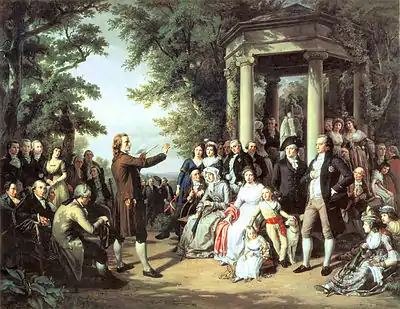
Since the mid-18th century recognition and application of Enlightenment ideas, higher cultural, intellectual and spiritual standards have led to higher quality works of art in music, philosophy, science and literature. Philosopher Christian Wolff (1679–1754) was a pioneering author on a near universal number of Enlightenment rationality topics in Germany and established German as the language of philosophic reasoning, scholarly instruction and research.[151]
In 1685 Margrave Frederick William of Prussia issued the Edict of Potsdam within a week after French king Louis XIV's Edict of Fontainebleau, that decreed the abolishment of the 1598 concession to free religious practice for Protestants. Frederick William offered his co-religionists, who are oppressed and assailed for the sake of the Holy Gospel and its pure doctrine...a secure and free refuge in all Our Lands.[152] Around 20,000 Huguenot refugees arrived in an immediate wave and settled in the cities, 40% in Berlin, the ducal residence alone. The French Lyceum in Berlin was established in 1689 and the French language had by the end of the 17th century replaced Latin to be spoken universally in international diplomacy. The nobility and the educated middle-class of Prussia and the various German states increasingly used the French language in public conversation in combination with universal cultivated manners. Like no other German state, Prussia had access to and the skill set for the application of pan-European Enlightenment ideas to develop more rational political and administrative institutions.[153] The princes of Saxony carried out a comprehensive series of fundamental fiscal, administrative, judicial, educational, cultural and general economic reforms. The reforms were aided by the country's strong urban structure and influential commercial groups, who modernized pre-1789 Saxony along the lines of classic Enlightenment principles.[154]
Johann Gottfried von Herder (1744–1803) broke new ground in philosophy and poetry, as a leader of the Sturm und Drang movement of proto-Romanticism. Weimar Classicism ("Weimarer Klassik") was a cultural and literary movement based in Weimar that sought to establish a new humanism by synthesizing Romantic, classical, and Enlightenment ideas. The movement, from 1772 until 1805, involved Herder as well as polymath Johann Wolfgang von Goethe (1749–1832) and Friedrich Schiller (1759–1805), a poet and historian. Herder argued that every folk had its own particular identity, which was expressed in its language and culture. This legitimized the promotion of German language and culture and helped shape the development of German nationalism. Schiller's plays expressed the restless spirit of his generation, depicting the hero's struggle against social pressures and the force of destiny.[155]
German music, sponsored by the upper classes, came of age under composers Johann Sebastian Bach (1685–1750), Joseph Haydn (1732–1809), and Wolfgang Amadeus Mozart (1756–1791).[156]
Königsberg philosopher Immanuel Kant (1724–1804) tried to reconcile rationalism and religious belief, individual freedom, and political authority. Kant's work contained basic tensions that would continue to shape German thought – and indeed all of European philosophy – well into the 20th century.[157][158] The ideas of the Enlightenment and their implementation received general approval and recognition as principal cause for widespread cultural progress.[159]
Women
Before the 19th century, young women lived under the economic and disciplinary authority of their fathers until they married and passed under the control of their husbands. In order to secure a satisfactory marriage, a woman needed to bring a substantial dowry. In the wealthier families, daughters received their dowry from their families, whereas the poorer women needed to work in order to save their wages so as to improve their chances to wed. Under the German laws, women had property rights over their dowries and inheritances, a valuable benefit as high mortality rates resulted in successive marriages. Before 1789, the majority of women lived confined to society's private sphere, the home.[160]
The Age of Reason did not bring much more for women: men, including Enlightenment aficionados, believed that women were naturally destined to be principally wives and mothers. Within the educated classes, there was the belief that women needed to be sufficiently educated to be intelligent and agreeable interlocutors to their husbands. However, the lower-class women were expected to be economically productive in order to help their husbands make ends meet.[161]
French Revolution, 1789–1815
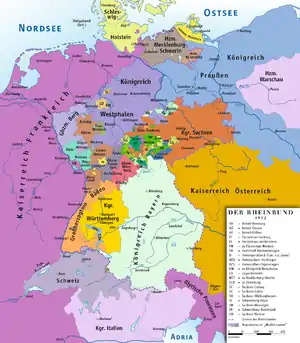
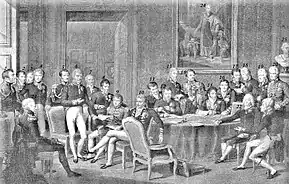
German reaction to the French Revolution was mixed at first. German intellectuals celebrated the outbreak, hoping to see the triumph of Reason and The Enlightenment. The royal courts in Vienna and Berlin denounced the overthrow of the king and the threatened spread of notions of liberty, equality, and fraternity. By 1793, the execution of the French king and the onset of the Terror disillusioned the Bildungsbürgertum (educated middle classes). Reformers said the solution was to have faith in the ability of Germans to reform their laws and institutions in peaceful fashion.[162]
Europe was racked by two decades of war revolving around France's efforts to spread its revolutionary ideals, and the opposition of reactionary royalty. War broke out in 1792 as Austria and Prussia invaded France, but were defeated at the Battle of Valmy (1792). The German lands saw armies marching back and forth, bringing devastation (albeit on a far lower scale than the Thirty Years' War, almost two centuries before), but also bringing new ideas of liberty and civil rights for the people. Prussia and Austria ended their failed wars with France but (with Russia) partitioned Poland among themselves in 1793 and 1795.
French consulate suzereignity
France took control of the Rhineland, imposed French-style reforms, abolished feudalism, established constitutions, promoted freedom of religion, emancipated Jews, opened the bureaucracy to ordinary citizens of talent, and forced the nobility to share power with the rising middle class. Napoleon created the Kingdom of Westphalia (1807–1813) as a model state.[163] These reforms proved largely permanent and modernized the western parts of Germany. When the French tried to impose the French language, German opposition grew in intensity. A Second Coalition of Britain, Russia, and Austria then attacked France but failed. Napoleon established direct or indirect control over most of western Europe, including the German states apart from Prussia and Austria. The old Holy Roman Empire was little more than a farce; Napoleon simply abolished it in 1806 while forming new countries under his control. In Germany Napoleon set up the "Confederation of the Rhine", comprising most of the German states except Prussia and Austria.[164]
Imperial French suzereignity
Under Frederick William II's weak rule (1786-.1797) Prussia had undergone a serious economic, political and military decline. His successor king Frederick William III tried to remain neutral during the War of the Third Coalition and French emperor Napoleon's dissolution of the Holy Roman Empire and reorganisation of the German principalities. Induced by the queen and a pro-war party Frederick William joined the Fourth Coalition in October 1806. Napoleon easily defeated the Prussian army at the Battle of Jena and occupied Berlin. Prussia lost its recently acquired territories in western Germany, its army was reduced to 42,000 men, no trade with Britain was allowed and Berlin had to pay Paris high reparations and fund the French army of occupation. Saxony changed sides to support Napoleon and joined the Confederation of the Rhine. Ruler Frederick Augustus I was rewarded with the title of king and given a slice of Poland taken from Prussia.[165]
After Napoleon's military fiasco in Russia in 1812, Prussia allied with Russia in the Sixth Coalition. A series of battles followed and Austria joined the alliance. Napoleon was decisively defeated in the Battle of Leipzig in late 1813. The German states of the Confederation of the Rhine defected to the Coalition against Napoleon, who rejected any peace terms. Coalition forces invaded France in early 1814, Paris fell and in April Napoleon surrendered. Prussia as one of the winners at the Congress of Vienna, gained extensive territory.[125]
1815–1871
Overview
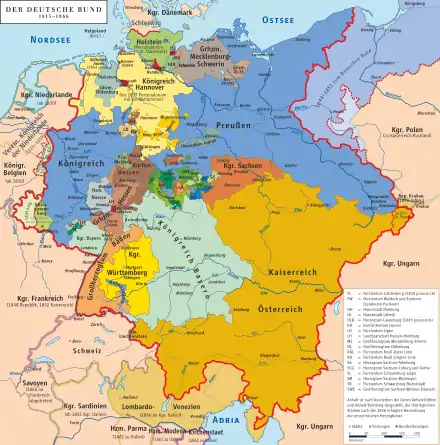
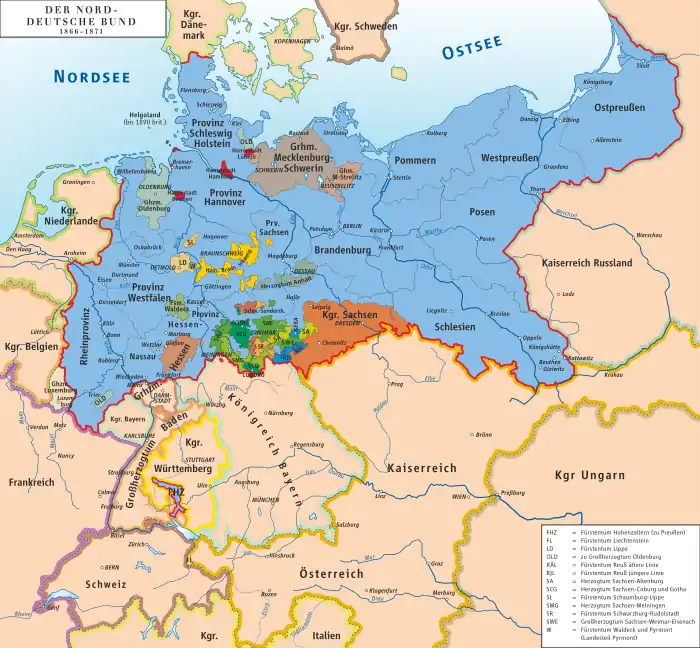
In 1815 continental Europe was in a state of overall turbulence and exhaustion, as a consequence of the French Revolutionary and Napoleonic Wars. The liberal spirit of the Enlightenment and Revolutionary era diverged toward the Romanticism of Edmund Burke, Joseph de Maistre and Novalis. The victorious members of the Coalition had negotiated a new peaceful balance of powers in Vienna and agreed to maintain a stable German heartland that keeps French imperialism at bay. However, the idea of reforming the defunct Holy Roman Empire was discarded. Napoleon's reorganization of the German states was continued and the remaining princes were allowed to keep their titles. In 1813, in return for guarantees from the Allies that the sovereignty and integrity of the Southern German states (Baden, Württemberg, and Bavaria) would be preserved, they broke with France.[166]
German Confederation
During the 1815 Congress of Vienna the 39 former states of the Confederation of the Rhine joined the German Confederation, a loose agreement for mutual defense. Attempts of economic integration and customs coordination were frustrated by repressive anti-national policies. Great Britain approved of the union, convinced that a stable, peaceful entity in central Europe could discourage aggressive moves by France or Russia. Most historians, however, concluded, that the Confederation was weak and ineffective and an obstacle to German nationalism. The union was undermined by the creation of the Zollverein in 1834, the 1848 revolutions, the rivalry between Prussia and Austria and was finally dissolved in the wake of the Austro-Prussian War of 1866,[167] to be replaced by the North German Confederation during the same year.[168]
Population
Between 1815 and 1865 the population of the German Confederation (excluding Austria) grew around 60% from 21 million to 34 million.[169] Simultaneously the Demographic Transition took place as the high birth rates and high death rates of the pre-industrial country shifted to low birth and death rates of the fast-growing industrialized urban economic and agricultural system. Increased agricultural productivity secured a steady food supply, as famines and epidemics declined. This allowed people to marry earlier, and have more children. The high birthrate was offset by a very high rate of infant mortality and after 1840, large-scale emigration to the United States. Emigration totaled at 480,000 in the 1840s, 1,200,000 in the 1850s, and at 780,000 in the 1860s. The upper and middle classes first practiced birth control, soon to be universally adopted.[170]
Industrialization
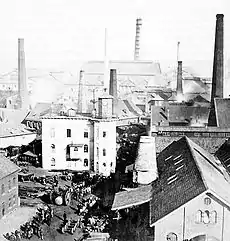

In 1800, Germany's social structure was poorly suited to entrepreneurship or economic development. Domination by France during the French Revolution (1790s to 1815), however, produced important institutional reforms, that included the abolition of feudal restrictions on the sale of large landed estates, the reduction of the power of the guilds in the cities, and the introduction of a new, more efficient commercial law. The idea, that these reforms were beneficial for Industrialization has been contested.[171] Nevertheless, traditionalism remained strong in the many small principalities. Until 1850, the guilds, the landed aristocracy, the churches and the government bureaucracies maintained many rules and restrictions that held entrepreneurship in low esteem and given little opportunity to develop. From the 1830s and 1840s, Prussia, Saxony and other states introduced agriculture based on sugar beets, turnips and potatoes, that yielded higher crops, which enabled a surplus rural population to move to industrial areas.
In the early 19th century the Industrial Revolution was in full swing in Britain, France, and Belgium. The various small federal states in Germany developed only slowly and independently as competition was strong. Early investments for the railway network during the 1830s came almost exclusively from private hands. Without a central regulatory agency the construction projects were quickly realized. Actual industrialization only took off after 1850 in the wake of the railroad construction.[172] The textile industry grew rapidly, profiting from the elimination of tariff barriers by the Zollverein.[173] During the second half of the 19th century the German industry grew exponentially and by 1900, Germany was an industrial world leader along with Britain and the United States.
Historian Thomas Nipperdey remarks:
On the whole, industrialisation in Germany must be considered to have been positive in its effects. Not only did it change society and the countryside, and finally the world...it created the modern world we live in. It solved the problems of population growth, under-employment and pauperism in a stagnating economy, and abolished dependency on the natural conditions of agriculture, and finally hunger. It created huge improvements in production and both short- and long-term improvements in living standards. However, in terms of social inequality, it can be assumed that it did not change the relative levels of income. Between 1815 and 1873 the statistical distribution of wealth was on the order of 77% to 23% for entrepreneurs and workers respectively. On the other hand, new problems arose, in the form of interrupted growth and new crises, such as urbanisation, 'alienation', new underclasses, proletariat and proletarian misery, new injustices and new masters and, eventually, class warfare.[174]
Urbanization
In 1800 the population was predominantly rural, as only 10% lived in communities of 5,000 or more people, and only 2% lived in cities of more than 100,000 people. After 1815, the urban population grew rapidly, due to the influx of young people from the rural areas. Berlin grew from 172,000 in 1800, to 826,000 inhabitants in 1870, Hamburg from 130,000 to 290,000, Munich from 40,000 to 269,000 and Dresden from 60,000 to 177,000.[175]
Railways
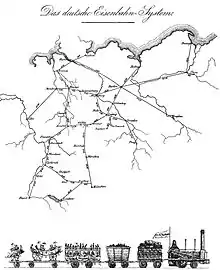
The takeoff stage of economic development came with the railroad revolution in the 1840s, which opened up new markets for local products, created a pool of middle managers, increased the demand for engineers, architects and skilled machinists and stimulated investments in coal and iron. Political disunity of three dozen states and a pervasive conservatism made it difficult to build railways in the 1830s. However, by the 1840s, trunk lines did link the major cities; each German state was responsible for the lines within its own borders. Economist Friedrich List summed up the advantages to be derived from the development of the railway system in 1841:
- 1. As a means of national defence, it facilitates the concentration, distribution and direction of the army.
- 2. It is a means to the improvement of the culture of the nation. It brings talent, knowledge and skill of every kind readily to market.
- 3. It secures the community against dearth and famine, and against excessive fluctuation in the prices of the necessaries of life.
- 4. It promotes the spirit of the nation, as it has a tendency to destroy the Philistine spirit arising from isolation and provincial prejudice and vanity. It binds nations by ligaments, and promotes an interchange of food and of commodities, thus making it feel to be a unit. The iron rails become a nerve system, which, on the one hand, strengthens public opinion, and, on the other hand, strengthens the power of the state for police and governmental purposes.[176]
Lacking a technological base at first, engineering and hardware was imported from Britain. In many cities, the new railway shops were the centres of technological awareness and training, so that by 1850, Germany was self-sufficient in meeting the demands of railroad construction, and the railways were a major impetus for the growth of the new steel industry. Observers found that even as late as 1890, their engineering was inferior to Britain. However, German unification in 1870 stimulated consolidation, nationalisation into state-owned companies, and further rapid growth. Unlike the situation in France, the goal was the support of industrialisation. Eventually numerous lines criss-crossed the Ruhr area and other industrial centers and provided good connections to the major ports of Hamburg and Bremen. By 1880, 9,400 locomotives pulled 43,000 passengers and 30,000 tons of freight a day.[172]
Newspapers and magazines
While there existed no national newspaper the many states issued a great variety of printed media, although they rarely exceeded regional significance. In a typical town existed one or two outlets, urban centers, such as Berlin and Leipzig had dozens. The audience was limited to a few percent of male adults, chiefly from the aristocratic and upper middle class. Liberal publishers outnumbered conservative ones by a wide margin. Foreign governments bribed editors to guarantee a favorable image.[177] Censorship was strict, and the imperial government issued the political news that was supposed to be published. After 1871, strict press laws were enforced by Bismarck to contain the Socialists and hostile editors. Editors focused on political commentary, culture, the arts, high culture and the popular serialized novels. Magazines were politically more influential and attracted intellectual authors.[178]
Science and culture during the 18th and 19th century
19th-century artists and intellectuals were greatly inspired by the ideas of the French Revolution and the great poets and writers Johann Wolfgang von Goethe (1749–1832), Gotthold Ephraim Lessing (1729–1781) and Friedrich Schiller (1759–1805). The Sturm und Drang romantic movement was embraced and emotion was given free expression in reaction to the perceived rationalism of the Enlightenment. Philosophical principles and methods were revolutionized by Immanuel Kant's paradigm shift. Ludwig van Beethoven (1770–1827) was the most influential composer of the period from classical to Romantic music. His use of tonal architecture in such a way as to allow significant expansion of musical forms and structures was immediately recognized as bringing a new dimension to music. His later piano music and string quartets, especially, showed the way to a completely unexplored musical universe, and influenced Franz Schubert (1797–1828) and Robert Schumann (1810–1856). In opera, a new Romantic atmosphere combining supernatural terror and melodramatic plot in a folkloric context was first successfully achieved by Carl Maria von Weber (1786–1826) and perfected by Richard Wagner (1813–1883) in his Ring Cycle. The Brothers Grimm (1785–1863 & 1786–1859) collected folk stories into the popular Grimm's Fairy Tales and are ranked among the founding fathers of German studies, who initiated the work on the Deutsches Wörterbuch ("The German Dictionary"), the most comprehensive work on the German language.[179]
University professors developed international reputations, especially in the humanities led by history and philology, which brought a new historical perspective to the study of political history, theology, philosophy, language, and literature. With Georg Wilhelm Friedrich Hegel (1770–1831), Friedrich Wilhelm Joseph Schelling (1775–1854), Arthur Schopenhauer (1788–1860), Friedrich Nietzsche (1844–1900), Max Weber (1864–1920), Karl Marx (1818–1883) and Friedrich Engels (1820–1895) in philosophy, Friedrich Schleiermacher (1768–1834) in theology and Leopold von Ranke (1795–1886) in history became famous. The University of Berlin, founded in 1810, became the world's leading university. Von Ranke, for example, professionalized history and set the world standard for historiography. By the 1830s mathematics, physics, chemistry, and biology had emerged with world class science, led by Alexander von Humboldt (1769–1859) in natural science and Carl Friedrich Gauss (1777–1855) in mathematics. Young intellectuals often turned to politics, but their support for the failed revolution of 1848 forced many into exile.[180]
- 18th- and 19th-century German artists, scientists and philosophers
.jpg.webp) Immanuel Kant (1724–1804)
Immanuel Kant (1724–1804)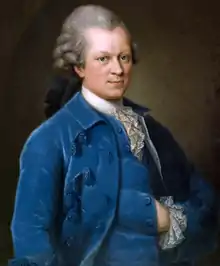 Gotthold Ephraim Lessing (1729–1781)
Gotthold Ephraim Lessing (1729–1781).jpg.webp) Johann Wolfgang von Goethe (1749–1832)
Johann Wolfgang von Goethe (1749–1832) Friedrich Schiller (1759–1805)
Friedrich Schiller (1759–1805) Alexander von Humboldt (1769–1859)
Alexander von Humboldt (1769–1859)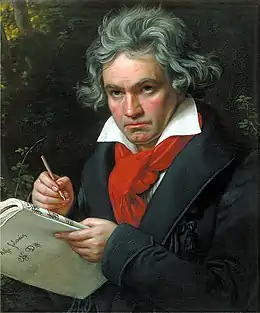 Ludwig van Beethoven (1770–1827)
Ludwig van Beethoven (1770–1827)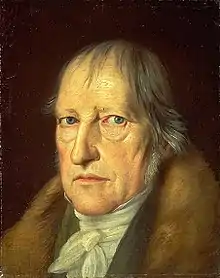 Friedrich Hegel (1770–1831)
Friedrich Hegel (1770–1831) Carl Friedrich Gauss (1777–1855)
Carl Friedrich Gauss (1777–1855)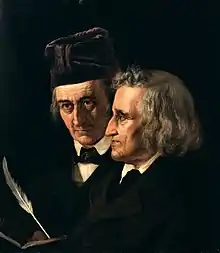 Brothers Grimm (1785–1863 & 1786–1859)
Brothers Grimm (1785–1863 & 1786–1859)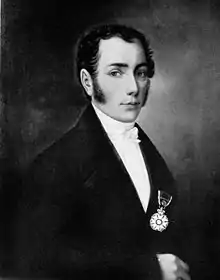 Joseph von Fraunhofer (1787–1826), physicist and optical lens manufacturer (1787–1826)
Joseph von Fraunhofer (1787–1826), physicist and optical lens manufacturer (1787–1826)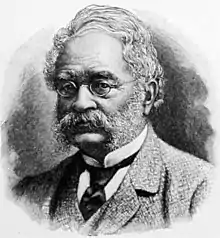 Werner von Siemens (1816–1892)
Werner von Siemens (1816–1892)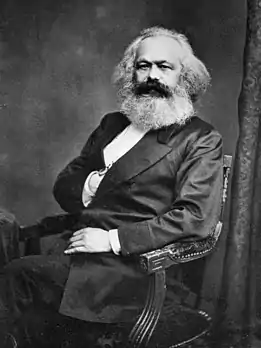 Karl Marx (1818–1883)
Karl Marx (1818–1883)
Religion
.jpg.webp)
Two main developments reshaped religion in Germany. Across the land, there was a movement to unite the larger Lutheran and the smaller Reformed Protestant churches. The churches themselves brought this about in Baden, Nassau, and Bavaria. However, in Prussia King Frederick William III was determined to handle unification entirely on his own terms, without consultation. His goal was to unify the Protestant churches, and to impose a single standardized liturgy, organization and even architecture. The long-term goal was to have fully centralized royal control of all the Protestant churches. In a series of proclamations over several decades the Church of the Prussian Union was formed, bringing together the more numerous Lutherans, and the less numerous Reformed Protestants. The government of Prussia now had full control over church affairs, with the king himself recognized as the leading bishop. Opposition to unification came from the "Old Lutherans" in Silesia who clung tightly to the theological and liturgical forms they had followed since the days of Luther. The government attempted to crack down on them, so they went underground. Tens of thousands migrated, to South Australia, and especially to the United States, where they formed the Missouri Synod, which is still in operation as a conservative denomination. Finally in 1845 a new king Frederick William IV offered a general amnesty and allowed the Old Lutherans to form a separate church association with only nominal government control.[181][182][183]
From the religious point of view of the typical Catholic or Protestant, major changes were underway in terms of a much more personalized religiosity that focused on the individual more than the church or the ceremony. The rationalism of the late 19th century faded away, and there was a new emphasis on the psychology and feeling of the individual, especially in terms of contemplating sinfulness, redemption, and the mysteries and the revelations of Christianity. Pietistic revivals were common among Protestants. Among, Catholics there was a sharp increase in popular pilgrimages. In 1844 alone, half a million pilgrims made a pilgrimage to the city of Trier in the Rhineland to view the Seamless robe of Jesus, said to be the robe that Jesus wore on the way to his crucifixion. Catholic bishops in Germany had historically been largely independent of Rome, but now the Vatican exerted increasing control, a new "ultramontanism" of Catholics highly loyal to Rome.[184] A sharp controversy broke out in 1837–38 in the largely Catholic Rhineland over the religious education of children of mixed marriages, where the mother was Catholic and the father Protestant. The government passed laws to require that these children always be raised as Protestants, contrary to Napoleonic law that had previously prevailed and allowed the parents to make the decision. It put the Catholic Archbishop under house arrest. In 1840, the new King Frederick William IV sought reconciliation and ended the controversy by agreeing to most of the Catholic demands. However Catholic memories remained deep and led to a sense that Catholics always needed to stick together in the face of an untrustworthy government.[185]
Politics of restoration and revolution
After Napoleon
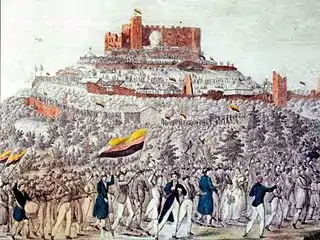
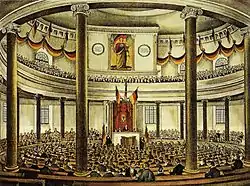
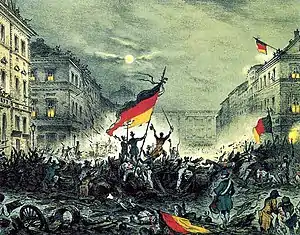
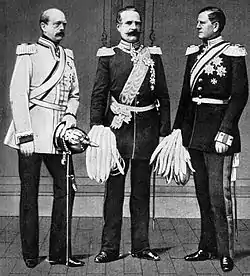
After the fall of Napoleon, Europe's statesmen convened in Vienna in 1815 for the reorganisation of European affairs, under the leadership of the Austrian Prince Metternich. The political principles agreed upon at this Congress of Vienna included the restoration, legitimacy and solidarity of rulers for the repression of revolutionary and nationalist ideas.
The German Confederation (German: Deutscher Bund) was founded, a loose union of 39 states (35 ruling princes and 4 free cities) under Austrian leadership, with a Federal Diet (German: Bundestag) meeting in Frankfurt am Main. It was a loose coalition that failed to satisfy most nationalists. The member states largely went their own way, and Austria had its own interests.
In 1819 a student radical assassinated the reactionary playwright August von Kotzebue, who had scoffed at liberal student organisations. In one of the few major actions of the German Confederation, Prince Metternich called a conference that issued the repressive Carlsbad Decrees, designed to suppress liberal agitation against the conservative governments of the German states.[186] The Decrees terminated the fast-fading nationalist fraternities (German: Burschenschaften), removed liberal university professors, and expanded the censorship of the press. The decrees began the "persecution of the demagogues", which was directed against individuals who were accused of spreading revolutionary and nationalist ideas. Among the persecuted were the poet Ernst Moritz Arndt, the publisher Johann Joseph Görres and the "Father of Gymnastics" Ludwig Jahn.[187]
In 1834 the Zollverein was established, a customs union between Prussia and most other German states, but excluding Austria. As industrialisation developed, the need for a unified German state with a uniform currency, legal system, and government became more and more obvious.
1848
Growing discontent with the political and social order imposed by the Congress of Vienna led to the outbreak, in 1848, of the March Revolution in the German states. In May the German National Assembly (the Frankfurt Parliament) met in Frankfurt to draw up a national German constitution.
But the 1848 revolution turned out to be unsuccessful: King Frederick William IV of Prussia refused the imperial crown, the Frankfurt parliament was dissolved, the ruling princes repressed the risings by military force, and the German Confederation was re-established by 1850. Many leaders went into exile, including a number who went to the United States and became a political force there.[188]
1850s
The 1850s were a period of extreme political reaction. Dissent was vigorously suppressed, and many Germans emigrated to America following the collapse of the 1848 uprisings. Frederick William IV became extremely depressed and melancholic during this period, and was surrounded by men who advocated clericalism and absolute divine monarchy. The Prussian people once again lost interest in politics. Prussia not only expanded its territory but began to industrialize rapidly, while maintaining a strong agricultural base.
Bismarck takes charge (1862–1866)
In 1857, the Prussian king Frederick William IV suffered a stroke and his brother William served as regent until 1861 when he became King William I. Although conservative, William was very pragmatic. His most significant accomplishment was the naming of Otto von Bismarck as Prussian minister president in 1862. The cooperation of Bismarck, Defense Minister Albrecht von Roon, and Field Marshal Helmut von Moltke set the stage for the military victories over Denmark, Austria, and France, that led to the unification of Germany.[189][190]
In 1863–64, disputes between Prussia and Denmark over Schleswig escalated, which was not part of the German Confederation, and which Danish nationalists wanted to incorporate into the Danish kingdom. The conflict led to the Second War of Schleswig in 1864. Prussia, joined by Austria, easily defeated Denmark and occupied Jutland. The Danes were forced to cede both the Duchy of Schleswig and the Duchy of Holstein to Austria and Prussia. The subsequent management of the two duchies led to tensions between Austria and Prussia. Austria wanted the duchies to become an independent entity within the German Confederation, while Prussia intended to annex them. The disagreement served as a pretext for the Seven Weeks War between Austria and Prussia, that broke out in June 1866. In July, the two armies clashed at Sadowa-Königgrätz (Bohemia) in an enormous battle involving half a million men. Prussian superior logistics and the modern breech-loading needle guns superioity over the slow muzzle-loading rifles of the Austrians, proved to be elementary for Prussia's victory. The battle had also decided the struggle for hegemony in Germany and Bismarck was deliberately lenient with defeated Austria, that was to play only a subordinate role in future German affairs.[191][192]
North German Confederation, 1866–1871
After the Seven Weeks War the German Confederation was dissolved and the North German Federation (German Norddeutscher Bund) was established under the leadership of Prussia. Austria was excluded and its immense influence over Germany finally came to an end. The North German Federation was a transitional organisation that existed from 1867 to 1871, between the dissolution of the German Confederation and the founding of the German Empire.[193]
German Empire, 1871–1918
Overview
.svg.png.webp)
-de.svg.png.webp)
Chancellor Otto von Bismarck determined the political course of the German Empire until 1890. He fostered alliances in Europe to contain France on the one hand and aspired to consolidate Germany's influence in Europe on the other. His principal domestic policies focused on the suppression of socialism and the reduction of the strong influence of the Roman Catholic Church on its adherents. He issued a series of anti-socialist laws in accord with a set of social laws, that included universal health care, pension plans and other social security programs. His Kulturkampf policies were vehemently resisted by Catholics, who organized political opposition in the Center Party (Zentrum). German industrial and economic power had grown to match Britain by 1900.
In 1888, the young and ambitious Kaiser Wilhelm II became emperor. He rejected advice from experienced politicians and ordered Bismarck's resignation in 1890. He opposed Bismarck's careful and delicate foreign policy and was determined to pursue colonialist policies, as Britain and France had been doing for centuries. The Kaiser promoted the active colonization of Africa and Asia for the lands that were not already colonies of other European powers. The Kaiser took a mostly unilateral approach in Europe only allied with the Austro-Hungarian Empire, and embarked on a dangerous naval arms race with Britain. His aggressive and erroneous policies greatly contributed to the situation in which the assassination of the Austrian-Hungarian crown prince would spark off World War I.
The new empire
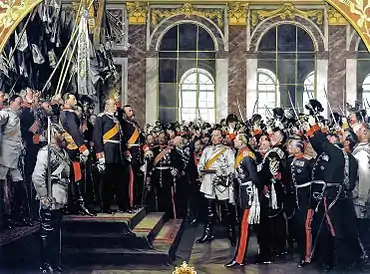
In 1868, the Spanish queen Isabella II was deposed in the Glorious Revolution, leaving the country's throne vacant. When Prussia suggested the Hohenzollern candidate, Prince Leopold as successor, France vehemently objected. The matter evolved into a diplomatic scandal and in July 1870, France resolved to end it in a full-scale war. The conflict was quickly decided as Prussia, joined by forces of a pan-German alliance never gave up the tactical initiative. A series of victories in north-eastern France followed and another French army group was simultaneously encircled at Metz. A few weeks later, the French army contingent under Emperor Napoleon III's personal command was finally forced to capitulate in the fortress of Sedan.[194][195] Napoleon was taken prisoner and a provisional government hastily proclaimed in Paris. The new government resolved to fight on and tried to reorganize the remaining armies while the Germans settled down to besiege Paris. The starving city surrendered in January 1871 and Jules Favre signed the surrender at Versailles. France was forced to pay indemnities of 5 billion francs and cede Alsace-Lorraine to Germany. This conclusion left the French national psyche deeply humiliated and further aggravated the French–German enmity.
During the Siege of Paris, the German princes assembled in the Hall of Mirrors of the Palace of Versailles on 18 January 1871 and announced the establishment of the German Empire and proclaimed the Prussian King Wilhelm I as German Emperor. The act unified all ethnic German states with the exception of Austria in the Little German solution of a federal economic, political and administrative unit. Bismarck, was appointed to serve as Chancellor.
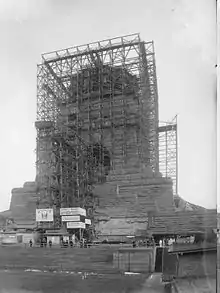
A federal empire
The new empire was a federal union of 25 states that varied considerably in size, demography, constitution, economy, culture, religion and socio-political development. However, even Prussia itself, which accounted for two-thirds of the territory as well as of the population, had emerged from the empire's periphery as a newcomer. It also faced colossal cultural and economic internal divisions. The Prussian provinces of Westphalia and the Rhineland for example had been under French control during the previous decades. The local people, who had benefited from the liberal, civil reforms, that were derived from the ideas of the French Revolution, had only little in common with predominantly rural communities in authoritarian and disjointed Junker estates of Pommerania.[196] The inhabitants of the smaller territorial lands, especially in central and southern Germany greatly rejected the Prussianized concept of the nation and preferred to associate such terms with their individual home state. The Hanseatic port cities of Hamburg, Bremen and Lübeck ranked among the most ferocious opponents of the so-called contract with Prussia. As advocates of free trade, they objected Prussian ideas of economic integration and refused to sign the renewed Zollverein (Custom Union) treaties until 1888.[197] The Hanseatic merchants' overseas economic success corresponded with their globalist mindset. The citizen of Hamburg, whom Bismark characterized as extremely irritating and the German ambassador in London as the worst Germans we have, were particularly appalled by Prussian militarism and its unopposed growing influence.[198]
The Prusso-German authorities were aware of necessary integration concepts as the results and the 52% voter turnout of the first imperial elections had clearly demonstrated. Historians increasingly argue, that the nation-state was forged through empire.[199] National identity was expressed in bombastic imperial stone iconography and was to be achieved as an imperial people, with an emperor as head of state and it was to develop imperial ambitions – domestic, European and global.[200][199]
Bismarck's domestic policies as Chancellor of Germany were based on his effort to universally adopt the idea of the Protestant Prussian state and achieve the clear separation of church and state in all imperial principalities. In the Kulturkampf (lit.: culture struggle) from 1871 to 1878, he tried to minimize the influence of the Roman Catholic Church and its political arm, the Catholic Centre Party, via secularization of all education and introduction of civil marriage, but without success. The Kulturkampf antagonised many Protestants as well as Catholics and was eventually abandoned. The millions of non-German imperial subjects, like the Polish, Danish and French minorities, were left with no choice but to endure discrimination or accept[201][202] the policies of Germanisation.
A three class system
- Aristocracy
The new Empire provided attractive top level career opportunities for the national nobility in the various branches of the consular and civil services and the army. As a consequence the aristocratic near total control of the civil sector guaranteed a dominant voice in the decision making in the universities and the churches. The 1914 German diplomatic corps consisted of 8 princes, 29 counts, 20 barons, 54 representants of the lower nobility and a mere 11 commoners. These commoners were indiscriminately recruited from elite industrialist and banking families. The consular corps employed numerous commoners, that however, occupied positions of little to no executive power.[203] The Prussian tradition to reserve the highest military ranks for young aristocrats was adopted and the new constitution put all military affairs under the direct control of the Emperor and beyond control of the Reichstag.[204] With its large corps of reserve officers across Germany, the military strengthened its role as "The estate which upheld the nation", and historian Hans-Ulrich Wehler added: "it became an almost separate, self-perpetuating caste".[205]
Power increasingly was centralized among the 7000 aristocrats, who resided in the national capital of Berlin and neighboring Potsdam. Berlin's rapidly increasing rich middle-class copied the aristocracy and tried to marry into it. A peerage could permanently boost a rich industrial family into the upper reaches of the establishment.[206] However, the process tended to work in the other direction as the nobility became industrialists. For example, 221 of the 243 mines in Silesia were owned by nobles or by the King of Prussia himself.[207]
- Middle class
The middle class in the cities grew exponentially, although it never acquired the powerful parliamentary representation and legislative rights as in France, Britain or the United States. The Association of German Women's Organizations or BDF was established in 1894 to encompass the proliferating women's organizations that had emerged since the 1860s. From the beginning the BDF was a bourgeois organization, its members working toward equality with men in such areas as education, financial opportunities, and political life. Working-class women were not welcome and were organized by the Socialists.[208]
- Working class
The rise of the Socialist Workers' Party (later known as the Social Democratic Party of Germany, SPD), aimed to peacefully establish a socialist order through the transformation of the existing political and social conditions. From 1878, Bismarck tried to oppose the growing social democratic movement by outlawing the party's organisation, its assemblies and most of its newspapers. Nonetheless, the Social Democrats grew stronger and Bismarck initiated his social welfare program in 1883 in order to appease the working class.[209]
Bismarck built on a tradition of welfare programs in Prussia and Saxony that began as early as the 1840s. In the 1880s he introduced old age pensions, accident insurance, medical care, and unemployment insurance that formed the basis of the modern European welfare state. His paternalistic programs won the support of German industry because its goals were to win the support of the working classes for the Empire and reduce the outflow of immigrants to America, where wages were higher but welfare did not exist.[210][211] Bismarck further won the support of both industry and skilled workers by his high tariff policies, which protected profits and wages from American competition, although they alienated the liberal intellectuals who wanted free trade.[212][213]
Kulturkampf
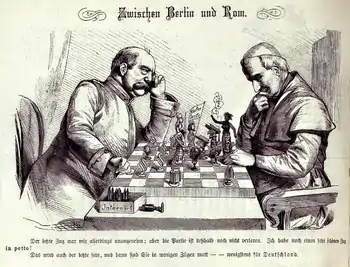
Bismarck would not tolerate any power outside Germany—as in Rome—having a say in domestic affairs. He launched the Kulturkampf ("culture war") against the power of the pope and the Catholic Church in 1873, but only in the state of Prussia. This gained strong support from German liberals, who saw the Catholic Church as the bastion of reaction and their greatest enemy. The Catholic element, in turn, saw in the National-Liberals the worst enemy and formed the Center Party.[214]
Catholics, although nearly a third of the national population, were seldom allowed to hold major positions in the Imperial government, or the Prussian government. After 1871, there was a systematic purge of the remaining Catholics; in the powerful interior ministry, which handled all police affairs, the only Catholic was a messenger boy. Jews were likewise heavily discriminated against.[215][216]
Most of the Kulturkampf was fought out in Prussia, but Imperial Germany passed the Pulpit Law which made it a crime for any cleric to discuss public issues in a way that displeased the government. Nearly all Catholic bishops, clergy, and laymen rejected the legality of the new laws and defiantly faced the increasingly heavy penalties and imprisonments imposed by Bismarck's government. Historian Anthony Steinhoff reports the casualty totals:
As of 1878, only three of eight Prussian dioceses still had bishops, some 1,125 of 4,600 parishes were vacant, and nearly 1,800 priests ended up in jail or in exile ... Finally, between 1872 and 1878, numerous Catholic newspapers were confiscated, Catholic associations and assemblies were dissolved, and Catholic civil servants were dismissed merely on the pretence of having Ultramontane sympathies.[217]
Bismarck underestimated the resolve of the Catholic Church and did not foresee the extremes that this struggle would attain.[218][219] The Catholic Church denounced the harsh new laws as anti-Catholic and mustered the support of its rank and file voters across Germany. In the following elections, the Center Party won a quarter of the seats in the Imperial Diet.[220] The conflict ended after 1879 because Pope Pius IX died in 1878 and Bismarck broke with the Liberals to put his main emphasis on tariffs, foreign policy, and attacking socialists. Bismarck negotiated with the conciliatory new pope Leo XIII.[221] Peace was restored, the bishops returned and the jailed clerics were released. Laws were toned down or taken back (Mitigation Laws 1880–1883 and Peace Laws 1886/87), but the laws concerning education, civil registry of marriages and religious disaffiliation remained in place. The Center Party gained strength and became an ally of Bismarck, especially when he attacked socialism.[222]
Foreign policies and relations
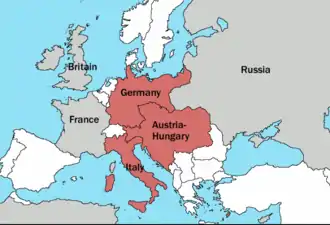
Chancellor Bismarck's imperial foreign policy basically aimed at security and the prevention of a Franco-Russian alliance, in order to avoid a likely Two-front war. The League of Three Emperors was signed in 1873 by Russia, Austria, and Germany. It stated that republicanism and socialism were common enemies and that the three powers would discuss any matters concerning foreign policy. Bismarck needed good relations with Russia in order to keep France isolated. Russia fought a victorious war against the Ottoman Empire from 1877 to 1878 and attempted to establish the Principality of Bulgaria, that was strongly opposed by France and Britain in particular, as they were long concerned with the preservation of the Ottoman Empire and Russian containment at the Bosphorus Strait and the Black Sea. Germany hosted the Congress of Berlin in 1878, where a more moderate peace settlement was agreed upon.
In 1879, Germany formed the Dual Alliance with Austria-Hungary, an agreement of mutual military assistance in the case of an attack from Russia, which was not satisfied with the agreement of the Congress of Berlin. The establishment of the Dual Alliance led Russia to take a more conciliatory stance and in 1887, the so-called Reinsurance Treaty was signed between Germany and Russia. In it, the two powers agreed on mutual military support in the case that France attacked Germany or an Austrian attack on Russia. Russia turned its attention eastward to Asia and remained largely inactive in European politics for the next 25 years. In 1882, Italy, seeking supporters for its interests in North Africa against France's colonial policy, joined the Dual Alliance, which became the Triple Alliance. In return for German and Austrian support, Italy committed itself to assisting Germany in the case of a French attack.[223]
Bismarck had always argued that the acquisition of overseas colonies was impractical and the burden of administration and maintenance would outweigh the benefits. Eventually, Bismarck gave way, and a number of colonies were established in Africa (Togo, the Cameroons, German South-West Africa, and German East Africa) and in Oceania (German New Guinea, the Bismarck Archipelago, and the Marshall Islands). Consequently, Bismarck initiated the Berlin Conference of 1885, a formal meeting of the European colonial powers, who sought to "established international guidelines for the acquisition of African territory" (see Colonisation of Africa). Its outcome, the General Act of the Berlin Conference, can be seen as the formalisation of the "Scramble for Africa" and "New Imperialism".[224]
Wilhelm II

Emperor William I died in 1888. His son Frederick III, open for a more liberal political course, reigned only for ninety-nine days, as he was stricken with throat cancer and died three months after his coronation. His son Wilhelm II followed him on the throne at the age of 29. Wilhelm rejected the liberal ideas of his parents and embarked on a conservative autocratic rule. He early on decided to replace the political elite and in March 1890 he forced chancellor Bismarck into retirement.[225] Following his principle of "Personal Regiment", Wilhelm was determined to exercise maximum influence on all government affairs.[226][227][228]
Alliances and diplomacy
The young Kaiser Wilhelm set out to apply his imperialist ideas of Weltpolitik (German: [ˈvɛltpoliˌtiːk], "world politics"), as he envisaged a gratuitously aggressive political course to increase the empire's influence in and control over the world. After the removal of Bismarck, foreign policies were tackled with by the Kaiser and the Federal Foreign Office under Friedrich von Holstein. Wilhelm's increasingly erratic and reckless conduct was unmistakably related to character deficits and the lack of diplomatic skills.[229][230] The foreign office's rather sketchy assessment of the current situation and its recommendations for the empire's most suitable course of action were:
First a long-term coalition between France and Russia had to fall apart, secondly, Russia and Britain would never get together, and finally, Britain would eventually seek an alliance with Germany.
Subsequently, Wilhelm refused to renew the Reinsurance Treaty with Russia. Russia promptly formed a closer relationship with France in the Dual Alliance of 1894, as both countries were concerned about the novel disagreeability of Germany. Furthermore, Anglo–German relations provided, from a British point of view, no basis for any consensus as the Kaiser refused to divert from his, although somewhat peculiarly desperate and anachronistic, aggressive imperial engagement and the naval arms race in particular. Von Holstein's analysis proved to be mistaken on every point, Wilhelm, however, failed too, as he did not adopt a nuanced political dialogue. Germany was left gradually isolated and dependent on the Triple Alliance with Austria-Hungary, and Italy. This agreement was hampered by differences between Austria and Italy and in 1915 Italy left the alliance.[164]
In 1897 Admiral Alfred von Tirpitz, state secretary of the German Imperial Naval Office devised his initially rather practical, yet nonetheless ambitious plan to build a sizeable naval force. Although basically posing only an indirect threat as a Fleet in being, Tirpitz theorized, that its mere existence would force Great Britain, dependend on unrestricted movement on the seas, to agree to diplomatic compromises.[231] Tirpitz started the program of warship construction in 1898 and enjoyed the full support of Kaiser Wilhelm. Wilhelm entertained less rational ideas on the fleet, that circled around his romantic childhood dream to have a "fleet of [his] own some day" and his obsessive adherence to direct his policies along the line of Alfred Thayer Mahan's work The Influence of Sea Power upon History.[232] In exchange for the eastern African island of Zanzibar, Germany had bargained the island of Heligoland in the German Bight with Britain in 1890, and converted the island into a naval base and installed immense coastal defense batteries. Britain considered the imperial German endeavours to be a dangerous infringement on the century-old delicate balance of global affairs and trade on the seas under British control. The British, however, resolved to keep up the naval arms race and introduced the highly advanced new Dreadnought battleship concept in 1907. Germany quickly adopted the concept and by 1910 the arms race again escalated.[233][234]
In the First Moroccan Crisis of 1905, Germany nearly clashed with Britain and France when the latter attempted to establish a protectorate over Morocco. Kaiser Wilhelm II was upset at having not been informed about French intentions, and declared their support for Moroccan independence. William II made a highly provocative speech regarding this. The following year, a conference was held in which all of the European powers except Austria-Hungary (by now little more than a German satellite) sided with France. A compromise was brokered by the United States where the French relinquished some, but not all, control over Morocco.[235]
The Second Moroccan Crisis of 1911 saw another dispute over Morocco erupt when France tried to suppress a revolt there. Germany, still smarting from the previous quarrel, agreed to a settlement whereby the French ceded some territory in central Africa in exchange for Germany's renouncing any right to intervene in Moroccan affairs. This confirmed French control over Morocco, which became a full protectorate of that country in 1912.[236]
Economy
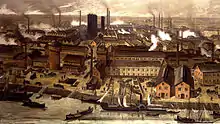
By 1890 the economy continued to industrialize and grow on an even higher rate than during the previous two decades and increased dramatically in the years leading up to World War I. Growth rates for the individual branches and sectors often varied considerably, and periodical figures provided by the Kaiserliches Statistisches Amt ("Imperial Statistical Bureau) are often disputed or just assessments. Classification and naming of internationally traded commodities and exported goods was still in progress and the structure of production and export had changed during four decades. Published documents provide numbers such as: The proportion of goods manufactured by the modern industry was approximately 25% in 1900, while the proportion of consumer related products in manufactured exports stood at 40%.[237] Reasonably exact are the figures for the entire industrial production between 1870 and 1914, which increased about 500%.[238]
Historian J. A. Perkins argued that more important than Bismarck's new tariff on imported grain was the introduction of the sugar beet as a main crop. Farmers quickly abandoned traditional, inefficient practices in favor of modern methods, including the use of artificial fertilizers and mechanical tools. Intensive methodical farming of sugar and other root crops made Germany the most efficient agricultural producer in Europe by 1914. Even so, farms were usually small in size and women did much of the field work. An unintended consequence was the increased dependence on migratory, especially foreign, labor.[239][240]
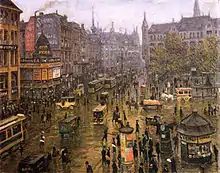
The basics of the modern chemical research laboratory layout and the introduction of essential equipment and instruments such as Bunsen burners, the Petri dish, the Erlenmeyer flask, task-oriented working principles and team research originated in 19th-century Germany and France. The organisation of knowledge acquisition was further refined by laboratory integration in research institutes of the universities and the industries. Germany acquired the leading role in the world's Chemical industry by the late 19th century through strictly organized methodology. In 1913, the German Chemical industry produced almost 90 percent of the global supply of dyestuffs and sold about 80 percent of its production abroad.[241][242]
Germany became Europe's leading steel-producing nation in the 1890s, thanks in large part to the protection from American and British competition afforded by tariffs and cartels.[243] The leading firm was "Friedrich Krupp AG Hoesch-Krupp", run by the Krupp family.[244] The merger of several major firms into the Vereinigte Stahlwerke (United Steel Works) in 1926 was modeled on the U.S. Steel corporation in the United States. The new company emphasized rationalization of management structures and modernization of the technology; it employed a multi-divisional structure and used return on investment as its measure of success. By 1913, American and German exports dominated the world steel market, as Britain slipped to third place.[245]
In machinery, iron and steel, and other industries, German firms avoided cut-throat competition and instead relied on trade associations. Germany was a world leader because of its prevailing "corporatist mentality", its strong bureaucratic tradition, and the encouragement of the government. These associations regulate competition and allowed small firms to function in the shadow of much larger companies.[246]
Women
Germany's unification process after 1871 was heavily dominated by men and give priority to the "Fatherland" theme and related male issues, such as military prowess.[247] Nevertheless, middle-class women enrolled in the Bund Deutscher Frauenvereine, the Union of German Feminist Organizations (BDF). Founded in 1894, it grew to include 137 separate women's rights groups from 1907 until 1933, when the Nazi regime disbanded the organization.[248] The BDF gave national direction to the proliferating women's organizations that had sprung up since the 1860s. From the beginning the BDF was a bourgeois organization, its members working toward equality with men in such areas as education, financial opportunities, and political life. Working-class women were not welcome; they were organized by the Socialists.[208]
Formal organizations for promoting women's rights grew in numbers during the Wilhelmine period. German feminists began to network with feminists from other countries, and participated in the growth of international organizations.
Colonies
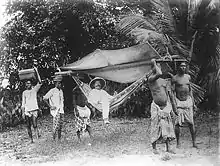
By the 1890s, German colonial expansion in Asia and the Pacific (Kiauchau in China, the Marianas, the Caroline Islands, Samoa) led to frictions with Britain, Russia, Japan and the United States.[249] The construction of the Baghdad Railway, financed by German banks, was designed to eventually connect Germany with the Turkish Empire and the Persian Gulf, but it also collided with British and Russian geopolitical interests.[250]
The largest colonial enterprises were in Africa.[251] The harsh treatment of the Nama and Herero in what is now Namibia in Africa in 1906–07 led to charges of genocide against the Germans. Historians are examining the links and precedents between the Herero and Namaqua Genocide and the Holocaust of the 1940s.[252][253][254]
World War I
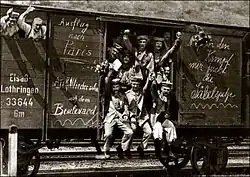
Causes
Ethnic demands for nation states upset the balance between the empires that dominated Europe, leading to World War I, which started in August 1914. Germany stood behind its ally Austria in a confrontation with Serbia, but Serbia was under the protection of Russia, which was allied to France. Germany was the leader of the Central Powers, which included Austria-Hungary, the Ottoman Empire, and later Bulgaria; arrayed against them were the Allies, consisting chiefly of Russia, France, Britain, and in 1915 Italy.
In explaining why neutral Britain went to war with Germany, author Paul M. Kennedy recognized it was critical for war that Germany become economically more powerful than Britain, but he downplays the disputes over economic trade imperialism, the Baghdad Railway, confrontations in Central and Eastern Europe, high-charged political rhetoric and domestic pressure-groups. Germany's reliance time and again on sheer power, while Britain increasingly appealed to moral sensibilities, played a role, especially in seeing the invasion of Belgium as a necessary military tactic or a profound moral crime. The German invasion of Belgium was not important because the British decision had already been made and the British were more concerned with the fate of France. Kennedy argues that by far the main reason was London's fear that a repeat of 1870 – when Prussia and the German states smashed France – would mean that Germany, with a powerful army and navy, would control the English Channel and northwest France. British policy makers insisted that would be a catastrophe for British security.[255]
Western Front

In the west, Germany sought a quick victory by encircling Paris using the Schlieffen Plan. But it failed due to Belgian resistance, Berlin's diversion of troops, and very stiff French resistance on the Marne, north of Paris. The Western Front became an extremely bloody battleground of trench warfare. The stalemate lasted from 1914 until early 1918, with ferocious battles that moved forces a few hundred yards at best along a line that stretched from the North Sea to the Swiss border. The British imposed a tight naval blockade in the North Sea which lasted until 1919, sharply reducing Germany's overseas access to raw materials and foodstuffs. Food scarcity became a serious problem by 1917.[256] The United States joined with the Allies in April 1917. The entry of the United States into the war – following Germany's declaration of unrestricted submarine warfare – marked a decisive turning-point against Germany.[257]
Total casualties on the Western Front were 3,528,610 killed and 7,745,920 wounded.[258]
Eastern Front
More wide open was the fighting on the Eastern Front. In the east, there were decisive victories against the Russian army, the trapping and defeat of large parts of the Russian contingent at the Battle of Tannenberg, followed by huge Austrian and German successes. The breakdown of Russian forces – exacerbated by internal turmoil caused by the 1917 Russian Revolution – led to the Treaty of Brest-Litovsk the Bolsheviks were forced to sign on 3 March 1918 as Russia withdrew from the war. It gave Germany control of Eastern Europe. Spencer Tucker says, "The German General Staff had formulated extraordinarily harsh terms that shocked even the German negotiator."[259] When Germany later complained that the Treaty of Versailles of 1919 was too harsh on them, the Allies responded that it was more benign than Brest-Litovsk.[260]
1918

By defeating Russia in 1917 Germany was able to bring hundreds of thousands of combat troops from the east to the Western Front, giving it a numerical advantage over the Allies. By retraining the soldiers in new storm-trooper tactics, the Germans expected to unfreeze the Battlefield and win a decisive victory before the American army arrived in strength.[261] However, the spring offensives all failed, as the Allies fell back and regrouped, and the Germans lacked the reserves necessary to consolidate their gains. In the summer, with the Americans arriving at 10,000 a day, and the German reserves exhausted, it was only a matter of time before multiple Allied offenses destroyed the German army.[262]
Homefront
Unexpectedly Germany plunged into World War I (1914–1918). It rapidly mobilized its civilian economy for the war effort, the economy was handicapped by the British blockade that cut off food supplies.[263] Meanwhile, conditions deteriorated rapidly on the home front, with severe food shortages reported in all urban areas. Causes involved the transfer of many farmers and food workers into the military, an overburdened railroad system, shortages of coal, and the British blockade that cut off imports from abroad. The winter of 1916–1917 was known as the "turnip winter", because that vegetable, usually fed to livestock, was used by people as a substitute for potatoes and meat, which were increasingly scarce. Thousands of soup kitchens were opened to feed the hungry people, who grumbled that the farmers were keeping the food for themselves. Even the army had to cut the rations for soldiers.[264] Morale of both civilians and soldiers continued to sink.
1918 was also the year of the deadly 1918 Spanish Flu pandemic which struck hard at a population weakened by years of malnutrition.
Revolution 1918
The end of October 1918, in Wilhelmshaven, in northern Germany, saw the beginning of the German Revolution of 1918–19. Units of the German Navy refused to set sail for a last, large-scale operation in a war which they saw as good as lost, initiating the uprising. On 3 November, the revolt spread to other cities and states of the country, in many of which workers' and soldiers' councils were established. Meanwhile, Hindenburg and the senior commanders had lost confidence in the Kaiser and his government. The Kaiser and all German ruling princes abdicated. On 9 November 1918, the Social Democrat Philipp Scheidemann proclaimed a Republic.
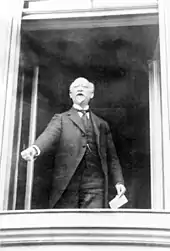
On 11 November, the Compiègne armistice was signed, ending the war. The Treaty of Versailles was signed on 28 June 1919. Germany was to cede Alsace-Lorraine to France. Eupen-Malmédy would temporarily be ceded to Belgium, with a plebiscite to be held to allow the people the choice of the territory either remaining with Belgium or being returned to German control. Following a plebiscite, the territory was allotted to Belgium on 20 September 1920. The future of North Schleswig was to be decided by plebiscite. In the Schleswig Plebiscites, the Danish-speaking population in the north voted for Denmark and the southern, German speaking populace, part voted for Germany. Schleswig was thus partitioned. Holstein remained German without a referendum. Memel was ceded to the Allied and Associated powers, to decide the future of the area. On 9 January 1923, Lithuanian forces invaded the territory. Following negotiations, on 8 May 1924, the League of Nations ratified the annexation on the grounds that Lithuania accepted the Memel Statute, a power-sharing arrangement to protect non-Lithuanians in the territory and its autonomous status. Until 1929, German-Lithuanian co-operation increased and this power sharing arrangement worked. Poland was restored and most of the provinces of Posen and West Prussia, and some areas of Upper Silesia were reincorporated into the reformed country after plebiscites and independence uprisings. All German colonies were to be handed over to League of Nations, who then assigned them as Mandates to Australia, France, Japan, New Zealand, Portugal, and the United Kingdom. The new owners were required to act as a disinterested trustee over the region, promoting the welfare of its inhabitants in a variety of ways until they were able to govern themselves. The left and right banks of the Rhine were to be permanently demilitarised. The industrially important Saarland was to be governed by the League of Nations for 15 years and its coalfields administered by France. At the end of that time a plebiscite was to determine the Saar's future status. To ensure execution of the treaty's terms, Allied troops would occupy the left (German) bank of the Rhine for a period of 5–15 years. The German army was to be limited to 100,000 officers and men; the general staff was to be dissolved; vast quantities of war material were to be handed over and the manufacture of munitions rigidly curtailed. The navy was to be similarly reduced, and no military aircraft were allowed. Germany was also required to pay reparations for all civilian damage caused during the war.
Weimar Republic, 1919–1933
Overview
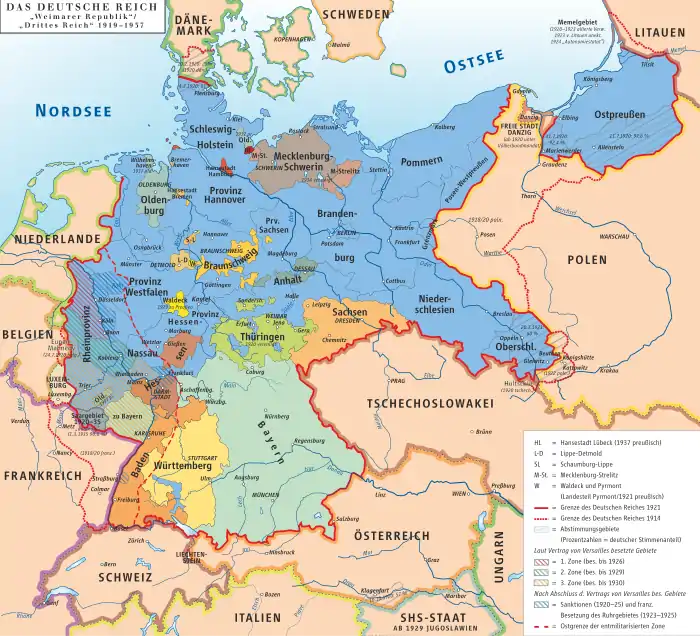
The humiliating peace terms in the Treaty of Versailles provoked bitter indignation throughout Germany, and seriously weakened the new democratic regime. In December 1918, the Communist Party of Germany (KPD) was founded, and in 1919 it tried and failed to overthrow the new republic. Adolf Hitler in 1919 took control of the new National Socialist German Workers' Party (NSDAP), which failed in a coup in Munich in 1923. Both parties, as well as parties supporting the republic, built militant auxiliaries that engaged in increasingly violent street battles. Electoral support for both parties increased after 1929 as the Great Depression hit the economy hard, producing many unemployed men who became available for the paramilitary units. The Nazis (formerly the German Workers' Party), with a mostly rural and lower middle class base, overthrew the Weimar regime and ruled Germany in 1933–1945.
The early years
On 11 August 1919, the Weimar constitution came into effect, with Friedrich Ebert as first President.
On 30 December 1918, the Communist Party of Germany was founded by the Spartacus League, who had split from the Social Democratic Party during the war. It was headed by Rosa Luxemburg and Karl Liebknecht, and rejected the parliamentary system. In 1920, about 300,000 members from the Independent Social Democratic Party of Germany joined the party, transforming it into a mass organization. The Communist Party had a following of about 10% of the electorate.[265]
.svg.png.webp)
In the first months of 1920, the Reichswehr was to be reduced to 100,000 men, in accordance with the Treaty of Versailles. This included the dissolution of many Freikorps – units made up of volunteers. In an attempt at a coup d'état in March 1920, the Kapp Putsch, extreme right-wing politician Wolfgang Kapp let Freikorps soldiers march on Berlin and proclaimed himself Chancellor of the Reich. After four days the coup d'état collapsed, due to popular opposition and lack of support by the civil servants and the officers. Other cities were shaken by strikes and rebellions, which were bloodily suppressed.
Germany was the first state to establish diplomatic relations with the new Soviet Union. Under the Treaty of Rapallo, Germany accorded the Soviet Union de jure recognition, and the two signatories mutually cancelled all pre-war debts and renounced war claims.
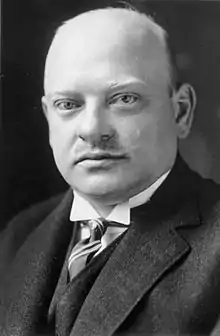
When Germany defaulted on its reparation payments, French and Belgian troops occupied the heavily industrialised Ruhr district (January 1923). The German government encouraged the population of the Ruhr to passive resistance: shops would not sell goods to the foreign soldiers, coal-miners would not dig for the foreign troops, trams in which members of the occupation army had taken a seat would be left abandoned in the middle of the street. The passive resistance proved effective, insofar as the occupation became a loss-making deal for the French government. But the Ruhr fight also led to hyperinflation, and many who lost all their fortune would become bitter enemies of the Weimar Republic, and voters of the anti-democratic right. See 1920s German inflation.

In September 1923, the deteriorating economic conditions led Chancellor Gustav Stresemann to call an end to the passive resistance in the Ruhr. In November, his government introduced a new currency, the Rentenmark (later: Reichsmark), together with other measures to stop the hyperinflation. In the following six years the economic situation improved. In 1928, Germany's industrial production even regained the pre-war levels of 1913.
The national elections of 1924 led to a swing to the right. Field Marshal Paul von Hindenburg was elected President in 1925.
In October 1925 the Treaty of Locarno was signed by Germany, France, Belgium, Britain and Italy; it recognised Germany's borders with France and Belgium. Moreover, Britain, Italy and Belgium undertook to assist France in the case that German troops marched into the demilitarised Rheinland. Locarno paved the way for Germany's admission to the League of Nations in 1926.
Reparations
The actual amount of reparations that Germany was obliged to pay out was not the 132 billion marks decided in the London Schedule of 1921 but rather the 50 million marks stipulated in the A and B Bonds. Historian Sally Marks says the 112 billion marks in "C bonds" were entirely chimerical—a device to fool the public into thinking Germany would pay much more. The actual total payout from 1920 to 1931 (when payments were suspended indefinitely) was 20 billion German gold marks, worth about US$5 billion or £1 billion British pounds. 12.5 billion was cash that came mostly from loans from New York bankers. The rest was goods like coal and chemicals, or from assets like railway equipment. The reparations bill was fixed in 1921 on the basis of a German capacity to pay, not on the basis of Allied claims. The highly publicized rhetoric of 1919 about paying for all the damages and all the veterans' benefits was irrelevant for the total, but it did determine how the recipients spent their share. Germany owed reparations chiefly to France, Britain, Italy and Belgium; the US received $100 million.[266]
Economic collapse and political problems, 1929–1933
The Wall Street Crash of 1929 marked the beginning of the worldwide Great Depression, which hit Germany as hard as any nation. In July 1931, the Darmstätter und Nationalbank – one of the biggest German banks – failed. In early 1932, the number of unemployed had soared to more than 6,000,000.
On top of the collapsing economy came a political crisis: the political parties represented in the Reichstag were unable to build a governing majority in the face of escalating extremism from the far right (the Nazis, NSDAP). In March 1930, President Hindenburg appointed Heinrich Brüning Chancellor, invoking article 48 of Weimar's constitution, which allowed him to override the Parliament. To push through his package of austerity measures against a majority of Social Democrats, Communists and the NSDAP (Nazis), Brüning made use of emergency decrees and dissolved Parliament. In March and April 1932, Hindenburg was re-elected in the German presidential election of 1932.[267]
The Nazi Party was the largest party in the national elections of 1932. On 31 July 1932 it received 37.3% of the votes, and in the election on 6 November 1932 it received less, but still the largest share, 33.1%, making it the biggest party in the Reichstag. The Communist KPD came third, with 15%.[268] Together, the anti-democratic parties of the far right were now able to hold a considerable share of seats in Parliament, but they were at sword's point with the political left, fighting it out in the streets. The Nazis were particularly successful among Protestants, among unemployed young voters, among the lower middle class in the cities and among the rural population. It was weakest in Catholic areas and in large cities. On 30 January 1933, pressured by former Chancellor Franz von Papen and other conservatives, President Hindenburg appointed Hitler as Chancellor.[269]
Science and culture in 19th and 20th century
The Weimar years saw a flowering of German science and high culture, before the Nazi regime resulted in a decline in the scientific and cultural life in Germany and forced many renowned scientists and writers to flee. German recipients dominated the Nobel prizes in science.[270] Germany dominated the world of physics before 1933, led by Hermann von Helmholtz, Wilhelm Conrad Röntgen, Albert Einstein, Otto Hahn, Max Planck and Werner Heisenberg. Chemistry likewise was dominated by German professors and researchers at the great chemical companies such as BASF and Bayer and persons like Justus von Liebig, Fritz Haber and Emil Fischer. Theoretical mathematicians Georg Cantor in the 19th century and David Hilbert in the 20th century. Karl Benz, the inventor of the automobile, and Rudolf Diesel were pivotal figures of engineering, and Wernher von Braun, rocket engineer. Ferdinand Cohn, Robert Koch and Rudolph Virchow were three key figures in microbiology.
Among the most important German writers were Thomas Mann (1875–1955), Hermann Hesse (1877–1962) and Bertolt Brecht (1898–1956). The reactionary historian Oswald Spengler wrote The Decline of the West (1918–23) on the inevitable decay of Western Civilization, and influenced intellectuals in Germany such as Martin Heidegger, Max Scheler, and the Frankfurt School, as well as intellectuals around the world.[271]
After 1933, Nazi proponents of "Aryan physics", led by the Nobel Prize-winners Johannes Stark and Philipp Lenard, attacked Einstein's theory of relativity as a degenerate example of Jewish materialism in the realm of science. Many scientists and humanists emigrated; Einstein moved permanently to the U.S. but some of the others returned after 1945.[272][273]
- 19th and 20th century German authors, scientists and philosophers
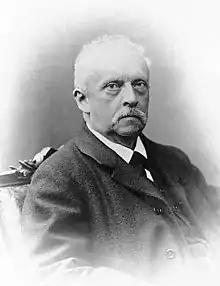 Hermann von Helmholtz (1821–1894)
Hermann von Helmholtz (1821–1894)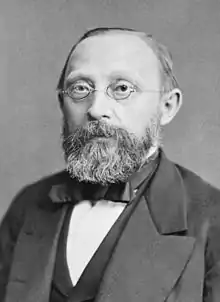 Rudolf Virchow (1821–1902)
Rudolf Virchow (1821–1902)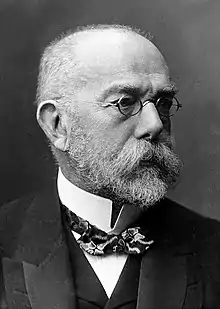 Robert Koch (1843–1910)
Robert Koch (1843–1910)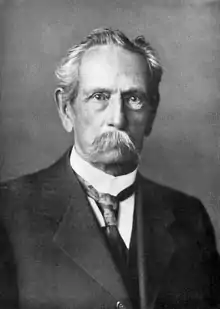 Karl Benz (1844–1929)
Karl Benz (1844–1929)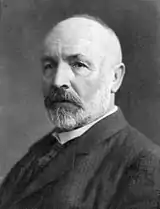 Georg Cantor (1845–1918)
Georg Cantor (1845–1918) Wilhelm Conrad Röntgen (1845–1923)
Wilhelm Conrad Röntgen (1845–1923)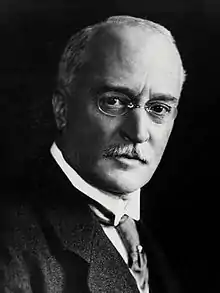 Rudolf Diesel (1858–1913)
Rudolf Diesel (1858–1913) Max Planck (1858–1947)
Max Planck (1858–1947)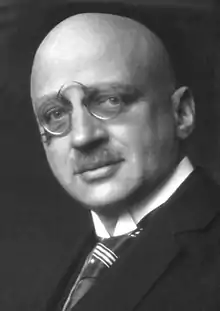 Fritz Haber (1868–1934)
Fritz Haber (1868–1934)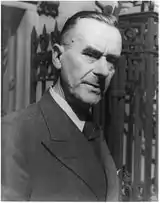 Thomas Mann (1875–1955)
Thomas Mann (1875–1955)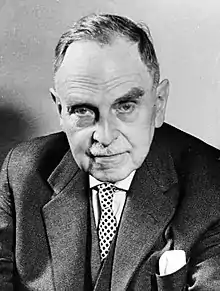 Otto Hahn (1879–1968)
Otto Hahn (1879–1968).jpg.webp) Martin Heidegger (1889–1976)
Martin Heidegger (1889–1976)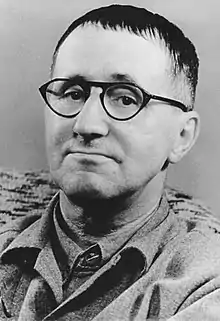 Bertolt Brecht (1898–1956)
Bertolt Brecht (1898–1956) Werner Heisenberg (1901–1976)
Werner Heisenberg (1901–1976)
Nazi Germany, 1933–1945
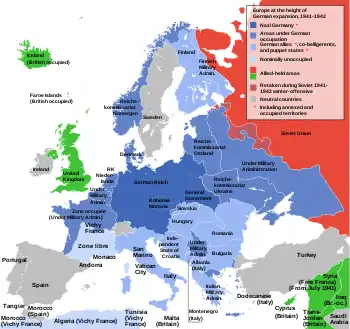
The Nazi regime restored economic prosperity and ended mass unemployment using heavy spending on the military, while suppressing labor unions and strikes. The return of prosperity gave the Nazi Party enormous popularity, with only minor, isolated and subsequently unsuccessful cases of resistance among the German population over the 12 years of rule. The Gestapo (secret police) under Heinrich Himmler destroyed the political opposition and persecuted the Jews, trying to force them into exile, while taking their property. The Party took control of the courts, local government, and all civic organizations except the Protestant and Catholic churches. All expressions of public opinion were controlled by Hitler's propaganda minister, Joseph Goebbels, who made effective use of film, mass rallies, and Hitler's hypnotic speaking. The Nazi state idolized Hitler as its Führer (leader), putting all powers in his hands. Nazi propaganda centered on Hitler and was quite effective in creating what historians called the "Hitler Myth"—that Hitler was all-wise and that any mistakes or failures by others would be corrected when brought to his attention.[274] In fact Hitler had a narrow range of interests and decision making was diffused among overlapping, feuding power centers; on some issues he was passive, simply assenting to pressures from whoever had his ear. All top officials reported to Hitler and followed his basic policies, but they had considerable autonomy on a daily basis.[275]
Establishment of the Nazi regime
.svg.png.webp)
In order to secure a majority for his Nazi Party in the Reichstag, Hitler called for new elections. On the evening of 27 February 1933, the Reichstag building was set afire. Hitler swiftly blamed an alleged Communist uprising, and convinced President Hindenburg to sign the Reichstag Fire Decree, which rescinded most German civil liberties, including rights of assembly and freedom of the press. The decree allowed the police to detain people indefinitely without charges or a court order. Four thousand members of the Communist Party of Germany were arrested.[276] Communist agitation was banned, but at this time not the Communist Party itself. Communists and Socialists were brought into hastily prepared Nazi concentration camps such as Kemna concentration camp, where they were at the mercy of the Gestapo, the newly established secret police force. Communist Reichstag deputies were taken into protective custody (despite their constitutional privileges).
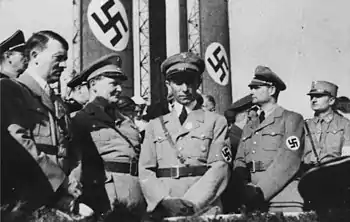
Despite the terror and unprecedented propaganda, the last free General Elections of 5 March 1933, while resulting in 43.9% failed to give the majority for the NSDAP as Hitler had hoped. Together with the German National People's Party (DNVP), however, he was able to form a slim majority government. In March 1933, the Enabling Act, an amendment to the Weimar Constitution, passed in the Reichstag by a vote of 444 to 94.[277] To obtain the two-thirds majority needed to pass the bill, accommodations were made to the Catholic Centre Party, and the Nazis used the provisions of the Reichstag Fire Decree to keep several Social Democratic deputies from attending, and the Communists deputies had already been banned.[278] This amendment allowed Hitler and his cabinet to pass laws—even laws that violated the constitution—without the consent of the president or the Reichstag.[279] The Enabling Act formed the basis for the dictatorship and the dissolution of the Länder; the trade unions and all political parties other than the Nazi Party were suppressed. A centralised totalitarian state was established, no longer based on the liberal Weimar constitution. Germany left the League of Nations. The coalition parliament was rigged by defining the absence of arrested and murdered deputies as voluntary and therefore cause for their exclusion as wilful absentees. Subsequently, in July the Centre Party was voluntarily dissolved in a quid pro quo with the Pope under the anti-communist Pope Pius XI for the Reichskonkordat; and by these manoeuvres Hitler achieved movement of these Catholic voters into the Nazi Party, and a long-awaited international diplomatic acceptance of his regime. According to Professor Dick Geary the Nazis gained a larger share of their vote in Protestant areas than in Catholic areas, in the elections held between 1928 and November 1932.[280] The Communist Party was proscribed in April 1933.
Thereafter, the Chief of Staff of the SA, Ernst Röhm, demanded more political and military power for he and his men, which caused anxiety among military, industrial, and political leaders. In response, Hitler used the SS and Gestapo to purge the entire SA leadership—along with a number of Hitler's political adversaries (such as Gregor Strasser and former chancellor Kurt von Schleicher). It became known as the Night of the Long Knives and took place from 30 June to 2 July 1934.[281] As a reward, the SS became an independent organisation under the command of the Reichsführer-SS Heinrich Himmler. He would rise to become Chief of German Police in June 1936 and already had control over the concentration camps system. Upon Hindenburg's death on 2 August 1934, Hitler's cabinet passed a law proclaiming the presidency to be vacant and transferred the role and powers of the head of state to Hitler as Chancellor and Führer (Leader).
Antisemitism and the Holocaust
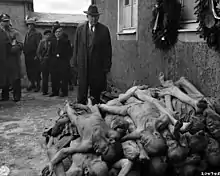
The Nazi regime was particularly hostile towards Jews, who became the target of unending antisemitic propaganda attacks. The Nazis attempted to convince the German people to view and treat Jews as "subhumans"[282] and immediately after winning almost 44% of parliamentary seats in the 1933 federal elections the Nazis imposed a nationwide boycott of Jewish businesses. In March 1933 the first official Nazi concentration camp was established at Dachau in Bavaria[283] and from 1933 to 1935 the Nazi regime consolidated their power. The Law for the Restoration of the Professional Civil Service passed on 7 April 1933, which forced all Jewish civil servants to retire from the legal profession and the civil service.[284] The Nuremberg Laws of 1935 banned sexual relations between Jews and Germans and only those of German or related blood were eligible to be considered citizens; the remainder were classed as state subjects, without citizenship rights.[285] This stripped Jews, Roma and others of their legal rights.[286] Jews continued to suffer persecution under the Nazi regime, exemplified by the Kristallnacht pogrom of 1938, and about half of Germany's 500,000 Jews fled the country before 1939, after which escape became almost impossible.[287]
In 1941, the Nazi leadership decided to implement a plan that they called the "Final Solution" which came to be known as the Holocaust. Under the plan, Jews and other "lesser races" along with political opponents from Germany as well as occupied countries were systematically murdered at murder sites, and starting in 1942, at extermination camps.[288] Between 1941 and 1945 Jews, Gypsies, Slavs, communists, homosexuals, the mentally and physically disabled and members of other groups were targeted and methodically murdered – the origin of the word "genocide". In total approximately 17 million people were killed during the Holocaust including 1.5 million children Jewish children .[289]
Military
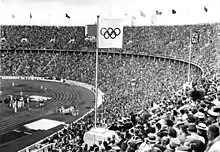
In 1935, Hitler officially re-established the Luftwaffe (air force) and reintroduced universal military service. This was in breach of the Treaty of Versailles; Britain, France and Italy issued notes of protest. Hitler had the officers swear their personal allegiance to him.[290] In 1936 German troops marched into the demilitarised Rhineland.[291] As the territory was part of Germany, the British and French governments did not feel that attempting to enforce the treaty was worth the risk of war.[292] The move strengthened Hitler's standing in Germany. His reputation swelled further with the 1936 Summer Olympics, which were held in the same year in Berlin, and proved another great propaganda success for the regime as orchestrated by master propagandist Joseph Goebbels.[293]
Women
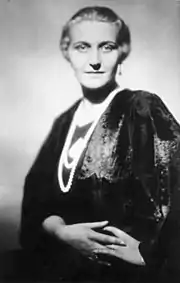
Historians have paid special attention to the efforts by Nazi Germany to reverse the gains women made before 1933, especially in the relatively liberal Weimar Republic.[294] It appears the role of women in Nazi Germany changed according to circumstances. Theoretically the Nazis advocated a patriarchal society in which the German woman would recognise that her "world is her husband, her family, her children, and her home".[295] However, before 1933, women played important roles in the Nazi organization and were allowed some autonomy to mobilize other women. After Hitler came to power in 1933, feminist groups were shut down or incorporated into the National Socialist Women's League, which coordinated groups throughout the country to promote feminine virtues, motherhood and household activities. Courses were offered on childrearing, sewing and cooking.[296] The Nazi regime did promote a liberal code of conduct regarding heterosexual relations among Germans and was sympathetic to women who bore children out of wedlock. The Lebensborn (Fountain of Life) association, founded by Himmler in 1935, created a series of maternity homes where single mothers could be accommodated during their pregnancies.[297]
As Germany prepared for war, large numbers were incorporated into the public sector and with the need for full mobilization of factories by 1943, all women under the age of fifty were required to register with the employment office for work assignments to help the war effort.[298] Women's wages remained unequal and women were denied positions of leadership or control.[299] In 1944–45 more than 500,000 women were volunteer uniformed auxiliaries in the German armed forces (Wehrmacht). About the same number served in civil aerial defense, 400,000 volunteered as nurses, and many more replaced drafted men in the wartime economy.[300] In the Luftwaffe they served in auxiliary roles helping to operate the anti-aircraft systems that shot down Allied bombers.[301]
Foreign policy

Hitler's diplomatic strategy in the 1930s was to make seemingly reasonable demands, threatening war if they were not met. When opponents tried to appease him, he accepted the gains that were offered, then went to the next target. That aggressive strategy worked as Germany pulled out of the League of Nations (1933), rejected the Versailles Treaty and began to re-arm (1935), won back the Saar (1935), remilitarized the Rhineland (1936), formed an alliance ("axis") with Mussolini's Italy (1936), sent massive military aid to Franco in the Spanish Civil War (1936–39), annexed Austria (1938), took over Czechoslovakia after the British and French appeasement of the Munich Agreement of 1938, formed a peace pact with Joseph Stalin's Soviet Union in August 1939, and finally invaded Poland on 1 September 1939. Britain and France declared war on Germany two days later and World War II in Europe began.[302][303]
After establishing the "Rome-Berlin axis" with Benito Mussolini, and signing the Anti-Comintern Pact with Japan – which was joined by Italy a year later in 1937 – Hitler felt able to take the offensive in foreign policy. On 12 March 1938, German troops marched into Austria, where an attempted Nazi coup had been unsuccessful in 1934. When Austrian-born Hitler entered Vienna, he was greeted by loud cheers. Four weeks later, 99% of Austrians voted in favour of the annexation (Anschluss) of their country to the German Reich. After Austria, Hitler turned to Czechoslovakia, where the 3.5 million-strong Sudeten German minority was demanding equal rights and self-government. At the Munich Conference of September 1938, Hitler, the Italian leader Benito Mussolini, British Prime Minister Neville Chamberlain and French Prime Minister Édouard Daladier agreed upon the cession of Sudeten territory to the German Reich by Czechoslovakia. Hitler thereupon declared that all of German Reich's territorial claims had been fulfilled. However, hardly six months after the Munich Agreement, in March 1939, Hitler used the smoldering quarrel between Slovaks and Czechs as a pretext for taking over the rest of Czechoslovakia as the Protectorate of Bohemia and Moravia. In the same month, he secured the return of Memel from Lithuania to Germany. Chamberlain was forced to acknowledge that his policy of appeasement towards Hitler had failed.
World War II
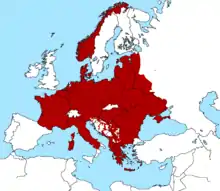
At first Germany was very successful in its military operations. In less than three months (April – June 1940), Germany conquered Denmark, Norway, the Low Countries, and France. The unexpectedly swift defeat of France resulted in an upswing in Hitler's popularity and an upsurge in war fever.[304][305] Hitler made peace overtures to the new British leader Winston Churchill in July 1940, but Churchill remained dogged in his defiance. Churchill had major financial, military, and diplomatic help from President Franklin D. Roosevelt in the U.S. Hitler's bombing campaign against Britain (September 1940–May 1941) failed. Some 43,000 British civilians were killed and 139,000 wounded in the Blitz; much of London was destroyed, with 1,400,245 buildings destroyed or damaged. Germany's armed forces invaded the Soviet Union in June 1941 – weeks behind schedule due to the invasion of Yugoslavia – but swept forward until they reached the gates of Moscow. Hitler had assembled more than 4,000,000 troops, including 1,000,000 from his Axis allies. The Soviets had lost nearly 3,000,000 killed in action, while 3,500,000 Soviet troops were captured in the first six months of the war. The Einsatzgruppen (Nazi mobile death squads) executed all Soviet Jews that it located, while the Germans went to Jewish households and forced the families into concentration camps for labor or to extermination camps for death.
The tide began to turn in December 1941, when the invasion of the Soviet Union hit determined resistance in the Battle of Moscow and Hitler declared war on the United States in the wake of the Japanese Pearl Harbor attack. After surrender in North Africa and losing the Battle of Stalingrad in 1942–43, the Germans were forced into the defensive. By late 1944, the United States, Canada, France, and Great Britain were closing in on Germany in the West, while the Soviets were victoriously advancing in the East.
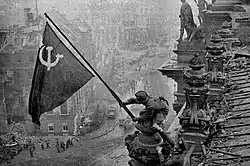
In 1944–45, Soviet forces completely or partially liberated Romania, Bulgaria, Hungary, Yugoslavia, Poland, Czechoslovakia, Austria, Denmark, and Norway. Nazi Germany collapsed as Berlin was taken by the Soviet Union's Red Army in a fight to the death on the city streets. 2,000,000 Soviet troops took part in the assault, and they faced 750,000 German troops. 78,000–305,000 Soviets were killed, while 325,000 German civilians and soldiers were killed.[306] Hitler committed suicide on 30 April 1945. The final German Instrument of Surrender was signed on 8 May 1945.
By September 1945, Nazi Germany and its Axis partners (Italy and Japan) had all been defeated, chiefly by the forces of the Soviet Union, the United States, and Great Britain. Much of Europe lay in ruins, over 60 million people worldwide had been killed (most of them civilians), including approximately 6 million Jews and 11 million non-Jews in what became known as the Holocaust. World War II resulted in the destruction of Germany's political and economic infrastructure and led directly to its partition, considerable loss of territory (especially in the East), and historical legacy of guilt and shame.[307]
Germany during the Cold War, 1945–1990
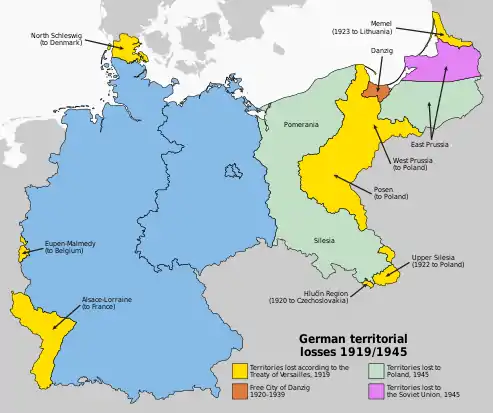
As a consequence of the defeat of Nazi Germany in 1945 and the onset of the Cold War in 1947, the country's territory was shrunk and split between the two global blocs in the East and West, a period known as the division of Germany. Millions of refugees from Central and Eastern Europe moved west, most of them to West Germany. Two countries emerged: West Germany was a parliamentary democracy, a NATO member, a founding member of what since became the European Union as one of the world's largest economies and under allied military control until 1955,[308] while East Germany was a totalitarian Communist dictatorship controlled by the Soviet Union as a satellite of Moscow. With the collapse of Communism in Europe in 1989, reunion on West Germany's terms followed.
No one doubted Germany's economic and engineering prowess; the question was how long bitter memories of the war would cause Europeans to distrust Germany, and whether Germany could demonstrate it had rejected totalitarianism and militarism and embraced democracy and human rights.[309]
Expulsion
At the Potsdam Conference, Germany was divided into four military occupation zones by the Allies and did not regain independence until 1949. The provinces east of the Oder and Neisse rivers (the Oder-Neisse line) were transferred to Poland and Russia (Kaliningrad oblast), pending a final peace conference with Germany, which eventually never took place.[310] Most of the remaining German population was expelled. Around 6.7 million Germans living in "west-shifted" Poland, mostly within previously German lands, and the 3 million in German-settled regions of Czechoslovakia were deported west.[311]
Post-war chaos
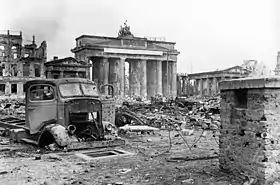
The total of German war dead was 8% to 10% out of a prewar population of 69,000,000, or between 5.5 million and 7 million people. This included 4.5 million in the military, and between 1 and 2 million civilians. There was chaos as 11 million foreign workers and POWs left, while soldiers returned home and more than 14 million displaced German-speaking refugees from East-Central and Eastern Europe were expelled from their native land and came to German lands often foreign to them.[312] During the Cold War, the West German government estimated a death toll of 2.2 million civilians due to the flight and expulsion of Germans and through forced labour in the Soviet Union.[313][314] This figure remained unchallenged until the 1990s, when some historians put the death toll at 500,000–600,000 confirmed deaths.[315] In 2006 the German government reaffirmed its position that 2.0–2.5 million deaths occurred.
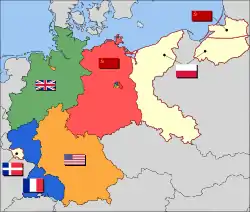
Denazification removed, imprisoned, or executed most top officials of the old regime, but most middle and lower ranks of civilian officialdom were not seriously affected. In accordance with the Allied agreement made at the Yalta Conference, millions of POWs were used as forced labor by the Soviet Union and other European countries.[316]
In the East, the Soviets crushed dissent and imposed another police state, often employing ex-Nazis in the dreaded Stasi. The Soviets extracted about 23% of the East German GNP for reparations, while in the West reparations were a minor factor.[317]
In 1945–46 housing and food conditions were bad, as the disruption of transport, markets, and finances slowed a return to normal. In the West, bombing had destroyed the fourth of the housing stock,[318] and over 10 million refugees from the east had crowded in, most living in camps.[319] Food production in 1946–48 was only two-thirds of the prewar level, while grain and meat shipments – which usually supplied 25% of the food – no longer arrived from the East. Furthermore, the end of the war brought the end of large shipments of food seized from occupied nations that had sustained Germany during the war. Coal production was down 60%, which had cascading negative effects on railroads, heavy industry, and heating.[320] Industrial production fell more than half and reached prewar levels only at the end of 1949.[321]
Allied economic policy originally was one of industrial disarmament plus building the agricultural sector. In the western sectors, most of the industrial plants had minimal bomb damage and the Allies dismantled 5% of the industrial plants for reparations.[322]
However, deindustrialization became impractical and the U.S. instead called for a strong industrial base in Germany so it could stimulate European economic recovery.[323] The U.S. shipped food in 1945–47 and made a $600 million loan in 1947 to rebuild German industry. By May 1946 the removal of machinery had ended, thanks to lobbying by the U.S. Army. The Truman administration finally realised that economic recovery in Europe could not go forward without the reconstruction of the German industrial base on which it had previously been dependent. Washington decided that an "orderly, prosperous Europe requires the economic contributions of a stable and productive Germany".[324][325]
In 1945 the occupying powers took over all newspapers in Germany and purged them of Nazi influence. The American occupation headquarters, the Office of Military Government, United States (OMGUS) began its own newspaper based in Munich, Die Neue Zeitung. It was edited by German and Jewish émigrés who fled to the United States before the war. Its mission was to encourage democracy by exposing Germans to how American culture operated. The paper was filled with details on American sports, politics, business, Hollywood, and fashions, as well as international affairs.[326]
East Germany
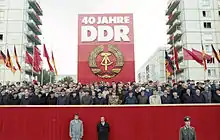
In 1949 the western half of the Soviet zone became the "Deutsche Demokratische Republik" – "DDR" ("German Democratic Republic" – "GDR", simply often "East Germany"), under control of the Socialist Unity Party. Neither country had a significant army until the 1950s, but East Germany built the Stasi into a powerful secret police that infiltrated every aspect of its society.[327]
East Germany was an Eastern bloc state under political and military control of the Soviet Union through her occupation forces and the Warsaw Treaty. Political power was solely executed by leading members (Politburo) of the communist-controlled Socialist Unity Party (SED). A Soviet-style command economy was set up; later the GDR became the most advanced Comecon state. While East German propaganda was based on the benefits of the GDR's social programs and the alleged constant threat of a West German invasion, many of her citizens looked to the West for political freedoms and economic prosperity.[328]
Walter Ulbricht (1893–1973) was the party boss from 1950 to 1971. In 1933, Ulbricht had fled to Moscow, where he served as a Comintern agent loyal to Stalin. As World War II was ending, Stalin assigned him the job of designing the postwar German system that would centralize all power in the Communist Party. Ulbricht became deputy prime minister in 1949 and secretary (chief executive) of the Socialist Unity (Communist) party in 1950.[329] Some 2.6 million people had fled East Germany by 1961 when he built the Berlin Wall to stop them – shooting those who attempted it. What the GDR called the "Anti-Fascist Protective Wall" was a major embarrassment for the program during the Cold War, but it did stabilize East Germany and postpone its collapse.[330][331] Ulbricht lost power in 1971, but was kept on as a nominal head of state. He was replaced because he failed to solve growing national crises, such as the worsening economy in 1969–70, the fear of another popular uprising as had occurred in 1953, and the disgruntlement between Moscow and Berlin caused by Ulbricht's détente policies toward the West.
The transition to Erich Honecker (General Secretary from 1971 to 1989) led to a change in the direction of national policy and efforts by the Politburo to pay closer attention to the grievances of the proletariat. Honecker's plans were not successful, however, with the dissent growing among East Germany's population.
In 1989, the socialist regime collapsed after 40 years, despite its omnipresent secret police, the Stasi. The main reasons for its collapse included severe economic problems and growing emigration towards the West.
East Germany's culture was shaped by Communism and particularly Stalinism. It was characterized by East German psychoanalyst Hans-Joachim Maaz in 1990 as having produced a "Congested Feeling" among Germans in the East as a result of Communist policies criminalizing personal expression that deviates from government approved ideals, and through the enforcement of Communist principals by physical force and intellectual repression by government agencies, particularly the Stasi.[332] Critics of the East German state have claimed that the state's commitment to communism was a hollow and cynical tool of a ruling elite. This argument has been challenged by some scholars who claim that the Party was committed to the advance of scientific knowledge, economic development, and social progress. However, the vast majority regarded the state's Communist ideals to be nothing more than a deceptive method for government control.[332]
According to German historian Jürgen Kocka (2010):
- Conceptualizing the GDR as a dictatorship has become widely accepted, while the meaning of the concept dictatorship varies. Massive evidence has been collected that proves the repressive, undemocratic, illiberal, nonpluralistic character of the GDR regime and its ruling party.[333]
West Germany (Bonn Republic)
.svg.png.webp)
1949 – present
In 1949, the three western occupation zones (American, British, and French) were combined into the Federal Republic of Germany (FRG, West Germany). The government was formed under Chancellor Konrad Adenauer and his conservative CDU/CSU coalition.[334] The CDU/CSU was in power during most of the period since 1949. The capital was Bonn until it was moved to Berlin in 1990. In 1990 FRG absorbed East Germany and gained full sovereignty over Berlin. At all points West Germany was much larger and richer than East Germany, which became a dictatorship under the control of the Communist Party and was closely monitored by Moscow. Germany, especially Berlin, was a cockpit of the Cold War, with NATO and the Warsaw Pact assembling major military forces in west and east. However, there was never any combat.[335]
Economic miracle

West Germany enjoyed prolonged economic growth beginning in the early 1950s (Wirtschaftswunder or "Economic Miracle").[336] Industrial production doubled from 1950 to 1957, and gross national product grew at a rate of 9 or 10% per year, providing the engine for economic growth of all of Western Europe. Labor unions supported the new policies with postponed wage increases, minimized strikes, support for technological modernization, and a policy of co-determination (Mitbestimmung), which involved a satisfactory grievance resolution system as well as requiring representation of workers on the boards of large corporations.[337] The recovery was accelerated by the currency reform of June 1948, U.S. gifts of $1.4 billion as part of the Marshall Plan, the breaking down of old trade barriers and traditional practices, and the opening of the global market.[338] West Germany gained legitimacy and respect, as it shed the horrible reputation Germany had gained under the Nazis.
West Germany played a central role in the creation of European cooperation; it joined NATO in 1955 and was a founding member of the European Economic Community in 1958.
Refugee settlements
To house the German-speakers expelled from all over Eastern Europe, quarters with cheap building were erected on the outskirts of all major and minor towns and villages of West Germany. Most often, these quarters are recognizable by the streets being named after towns of former Eastern Germany, Sudetenland, or other previously German-settled towns.
1948 currency reform

The most dramatic and successful policy event was the currency reform of 1948.[339] Since the 1930s, prices and wages had been controlled, but money had been plentiful. That meant that people had accumulated large paper assets, and that official prices and wages did not reflect reality, as the black market dominated the economy and more than half of all transactions were taking place unofficially. On 21 June 1948, the Western Allies withdrew the old currency and replaced it with the new Deutsche Mark at the rate of 1 new per 10 old. This wiped out 90% of government and private debt, as well as private savings. Prices were decontrolled, and labor unions agreed to accept a 15% wage increase, despite the 25% rise in prices. The result was that prices of German export products held steady, while profits and earnings from exports soared and were poured back into the economy. The currency reforms were simultaneous with the $1.4 billion in Marshall Plan money coming in from the United States, which was used primarily for investment.
In addition, the Marshall Plan forced German companies, as well as those in all of Western Europe, to modernize their business practices and take account of the international market. Marshall Plan funding helped overcome bottlenecks in the surging economy caused by remaining controls (which were removed in 1949), and Marshall Plan business reforms opened up a greatly expanded market for German exports. Overnight, consumer goods appeared in the stores, because they could be sold for realistic prices, emphasizing to Germans that their economy had turned a corner.[319]
The success of the currency reform angered the Soviets, who cut off all road, rail, and canal links between the western zones and West Berlin. This was the Berlin Blockade, which lasted from 24 June 1948 to 12 May 1949. In response, the U.S. and Britain launched an airlift of food and coal and distributed the new currency in West Berlin as well. The city thereby became economically integrated into West Germany.[340]
Adenauer

Konrad Adenauer (1876–1967) was the dominant leader in West Germany.[341] He was the first chancellor (top official) of the FRG, 1949–63, and until his death was the founder and leader of the Christian Democratic Union (CDU), a coalition of conservatives, ordoliberals, and adherents of Protestant and Catholic social teaching that dominated West Germany politics for most of its history. During his chancellorship, the West Germany economy grew quickly, and West Germany established friendly relations with France, participated in the emerging European Union, established the country's armed forces (the Bundeswehr), and became a pillar of NATO as well as firm ally of the United States. Adenauer's government also commenced the long process of reconciliation with the Jews and Israel after the Holocaust.[342]
Erhard
Ludwig Erhard (1897–1977) was in charge of economic policy as economics director for the British and American occupation zones and was Adenauer's long-time economics minister. Erhard's decision to lift many price controls in 1948 (despite opposition from both the social democratic opposition and Allied authorities), plus his advocacy of free markets, helped set the Federal Republic on its strong growth from wartime devastation.[343] Norbert Walter, a former chief economist at Deutsche Bank, argues that "Germany owes its rapid economic advance after World War II to the system of the Social Market Economy, established by Ludwig Erhard."[344][345] Erhard was politically less successful when he served as the CDU Chancellor from 1963 until 1966. Erhard followed the concept of a social market economy, and was in close touch with professional economists. Erhard viewed the market itself as social and supported only a minimum of welfare legislation. However, Erhard suffered a series of decisive defeats in his effort to create a free, competitive economy in 1957; he had to compromise on such key issues as the anti-cartel legislation. Thereafter, the West German economy evolved into a conventional west European welfare state.[346]
Meanwhile, in adopting the Godesberg Program in 1959, the Social Democratic Party of Germany (SPD) largely abandoned Marxism ideas and embraced the concept of the market economy and the welfare state. Instead it now sought to move beyond its old working class base to appeal the full spectrum of potential voters, including the middle class and professionals. Labor unions cooperated increasingly with industry, achieving labor representation on corporate boards and increases in wages and benefits.[347]
Grand coalition
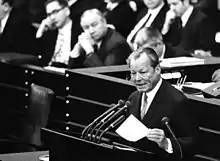
In 1966 Erhard lost support and Kurt Kiesinger (1904–1988) was elected as Chancellor by a new CDU/CSU-SPD alliance combining the two largest parties. Socialist (SPD) leader Willy Brandt was Deputy Federal Chancellor and Foreign Minister. The Grand Coalition lasted 1966–69 and is best known for reducing tensions with the Soviet bloc nations and establishing diplomatic relations with Czechoslovakia, Romania and Yugoslavia.
Guest workers
With a booming economy short of unskilled workers, especially after the Berlin Wall cut off the steady flow of East Germans, the FRG negotiated migration agreements with Italy (1955), Spain (1960), Greece (1960), and Turkey (1961) that brought in hundreds of thousands of temporary guest workers, called Gastarbeiter. In 1968 the FRG signed a guest worker agreement with Yugoslavia that employed additional guest workers. Gastarbeiter were young men who were paid full-scale wages and benefits, but were expected to return home in a few years.[348]
The agreement with Turkey ended in 1973 but few workers returned because there were few good jobs in Turkey.[349] By 2010 there were about 4 million people of Turkish descent in Germany. The generation born in Germany attended German schools, but had a poor command of either German or Turkish, and had either low-skilled jobs or were unemployed.[350][351]
Brandt and Ostpolitik
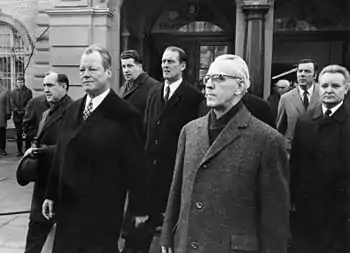
Willy Brandt (1913–1992) was the leader of the Social Democratic Party in 1964–87 and West German Chancellor in 1969–1974. Under his leadership, the German government sought to reduce tensions with the Soviet Union and improve relations with the German Democratic Republic, a policy known as the Ostpolitik.[336] Relations between the two German states had been icy at best, with propaganda barrages in each direction. The heavy outflow of talent from East Germany prompted the building of the Berlin Wall in 1961, which worsened Cold War tensions and prevented East Germans from travel. Although anxious to relieve serious hardships for divided families and to reduce friction, Brandt's Ostpolitik was intent on holding to its concept of "two German states in one German nation".
Ostpolitik was opposed by the conservative elements in Germany, but won Brandt an international reputation and the Nobel Peace Prize in 1971.[352] In September 1973, both West and East Germany were admitted to the United Nations. The two countries exchanged permanent representatives in 1974, and, in 1987, East Germany's leader Erich Honecker paid an official state visit to West Germany.[353]
Economic crisis of 1970s

After 1973, Germany was hard hit by a worldwide economic crisis, soaring oil prices, and stubbornly high unemployment, which jumped from 300,000 in 1973 to 1.1 million in 1975. The Ruhr region was hardest hit, as its easy-to-reach coal mines petered out, and expensive German coal was no longer competitive. Likewise the Ruhr steel industry went into sharp decline, as its prices were undercut by lower-cost suppliers such as Japan. The welfare system provided a safety net for the large number of unemployed workers, and many factories reduced their labor force and began to concentrate on high-profit specialty items. After 1990 the Ruhr moved into service industries and high technology. Cleaning up the heavy air and water pollution became a major industry in its own right. Meanwhile, formerly rural Bavaria became a high-tech center of industry.[322]
A spy scandal forced Brandt to step down as Chancellor while remaining as party leader. He was replaced by Helmut Schmidt (b. 1918), of the SPD, who served as Chancellor in 1974–1982. Schmidt continued the Ostpolitik with less enthusiasm. He had a PhD in economics and was more interested in domestic issues, such as reducing inflation. The debt grew rapidly as he borrowed to cover the cost of the ever more expensive welfare state.[354] After 1979, foreign policy issues grew central as the Cold War turned hot again. The German peace movement mobilized hundreds of thousands of demonstrators to protest against American deployment in Europe of new medium-range ballistic missiles. Schmidt supported the deployment but was opposed by the left wing of the SPD and by Brandt.
The pro-business Free Democratic Party (FDP) had been in coalition with the SPD, but now it changed direction.[355] Led by Finance Minister Otto Graf Lambsdorff (1926–2009) the FDP adopted the market-oriented "Kiel Theses" in 1977; it rejected the Keynesian emphasis on consumer demand, and proposed to reduce social welfare spending, and try to introduce policies to stimulate production and facilitate jobs. Lambsdorff argued that the result would be economic growth, which would itself solve both the social problems and the financial problems. As a consequence, the FDP switched allegiance to the CDU and Schmidt lost his parliamentary majority in 1982. For the only time in West Germany's history, the government fell on a vote of no confidence.[319][356]
Kohl

Helmut Kohl (1930–2017) brought the conservatives back to power with a CDU/CSU-FDP coalition in 1982, and served as Chancellor until 1998.[336] After repeated victories in 1983, 1987, 1990 and 1994 he was finally defeated by a landslide that was the biggest on record, for the left in the 1998 federal elections, and was succeeded as Chancellor by Gerhard Schröder of the SPD. Kohl is best known for orchestrating reunification with the approval of all the Four Powers from World War II, who still had a voice in German affairs.[357]
Reunification
During the summer of 1989, rapid changes known as peaceful revolution or Die Wende took place in East Germany, which quickly led to German reunification.[336] Growing numbers of East Germans emigrated to West Germany, many via Hungary after Hungary's reformist government opened its borders.
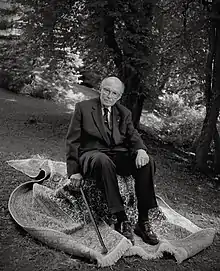
The opening of the Iron Curtain between Austria and Hungary at the Pan-European Picnic in August 1989 then triggered a chain reaction, at the end of which there was no longer a GDR and the Eastern Bloc had disintegrated. Otto von Habsburg's idea developed the greatest mass exodus since the construction of the Berlin Wall and it was shown that the USSR and the rulers of the Eastern European satellite states were not ready to keep the Iron Curtain effective. This made their loss of power visible and clear that the GDR no longer received effective support from the other communist Eastern Bloc countries.[358][359][360] Thousands of East Germans then tried to reach the West by staging sit-ins at West German diplomatic facilities in other East European capitals, most notably in Prague. The exodus generated demands within East Germany for political change, and mass demonstrations in several cities continued to grow.[361]

Unable to stop the growing civil unrest, Erich Honecker was forced to resign in October, and on 9 November, East German authorities unexpectedly allowed East German citizens to enter West Berlin and West Germany. Hundreds of thousands of people took advantage of the opportunity; new crossing points were opened in the Berlin Wall and along the border with West Germany. This led to the acceleration of the process of reforms in East Germany that ended with the German reunification that came into force on 3 October 1990.[362]
Federal Republic of Germany, 1990–present

Schröder

The SPD in coalition with the Greens won the elections of 1998. SPD leader Gerhard Schröder positioned himself as a centrist "Third Way" candidate in the mold of British Prime Minister Tony Blair and United States President Bill Clinton.
Schröder, in March 2003, reversed his position and proposed a significant downsizing of the welfare state, known as Agenda 2010. He had enough support to overcome opposition from the trade unions and the SPD's left wing. Agenda 2010 had five goals: tax cuts; labor market deregulation, especially relaxing rules protecting workers from dismissal and setting up Hartz concept job training; modernizing the welfare state by reducing entitlements; decreasing bureaucratic obstacles for small businesses; and providing new low-interest loans to local governments.[363]
On 26 December 2004 during a Christmas holiday and Boxing Day celebration, several thousand Germans in Thailand and other parts across the region of South and Southeast Asia were affected by the catastrophic tsunami from the magnitude 9.0 earthquake off the Indonesian island's west coast of Sumatra, and many thousands are lost of German lives. A memorial service held at Berlin Cathedral and Bundestag on 20 January 2005. On behalf of all Germans.
On 22 May 2005, after the SPD lost to the Christian Democratic Union (CDU) in North Rhine-Westphalia, Gerhard Schröder announced he would call federal elections "as soon as possible". A motion of confidence was subsequently defeated in the Bundestag on 1 July 2005 by 151 to 296 (with 148 abstaining), after Schröder urged members not to vote for his government in order to trigger new elections. In response, a grouping of left-wing SPD dissidents and the neo-communist Party of Democratic Socialism agreed to run on a joint ticket in the general election, with Schröder's rival Oskar Lafontaine leading the new group.
Merkel
From 2005 to 2009, Germany was ruled by a grand coalition led by the CDU's Angela Merkel as chancellor. Since the 2009 elections, Merkel has headed a centre-right government of the CDU/CSU and FDP.[364]

Together with France and other EU states, Germany has played the leading role in the European Union. Germany (especially under Chancellor Helmut Kohl) was one of the main supporters of admitting many East European countries to the EU. Germany is at the forefront of European states seeking to exploit the momentum of monetary union to advance the creation of a more unified and capable European political, defence and security apparatus. German Chancellor Schröder expressed an interest in a permanent seat for Germany in the UN Security Council, identifying France, Russia, and Japan as countries that explicitly backed Germany's bid. Germany formally adopted the Euro on 1 January 1999 after permanently fixing the Deutsche Mark rate on 31 December 1998.[365][366]
Since 1990, the German Bundeswehr has participated in a number of peacekeeping and disaster relief operations abroad. Since 2002, German troops formed part of the International Security Assistance Force in the war in Afghanistan, resulting in the first German casualties in combat missions since World War II.
In the worldwide economic recession that began in 2008, Germany did relatively well. However, the economic instability of Greece and several other EU nations in 2010–11 forced Germany to reluctantly sponsor a massive financial rescue.
In the wake of the 2011 natural disaster to the nuclear industry in Japan following its 9.0 magnitude earthquake and tsunami, German public opinion turned sharply against nuclear power in Germany, which produces a fourth of the electricity supply. In response Merkel has announced plans to close down the nuclear system over the next decade, and to rely even more heavily on wind and other alternative energy sources, in addition to coal and natural gas.[367] For further information, see Germany in 2011.
Germany was affected by the European migrant crisis in 2015 as it became the final destination of choice for many asylum seekers from Africa and the Middle East entering the EU. The country took in over a million refugees and migrants and developed a quota system which redistributed migrants around its federal states based on their tax income and existing population density.[368] The decision by Merkel to authorize unrestricted entry led to heavy criticism in Germany as well as within Europe.[369][370]
Historiography
Sonderweg debate
A major historiographical debate about the German history concerns the Sonderweg, the alleged "special path" that separated German history from the normal course of historical development, and whether or not Nazi Germany was the inevitable result of the Sonderweg. Proponents of the Sonderweg theory such as Fritz Fischer point to such events of the Revolution of 1848, the authoritarianism of the Second Empire and the continuation of the Imperial elite into the Weimar and Nazi periods. Opponents such as Gerhard Ritter of the Sonderweg theory argue that proponents of the theory are guilty of seeking selective examples, and there was much contingency and chance in German history. In addition, there was much debate within the supporters of the Sonderweg concept as for the reasons for the Sonderweg, and whether or not the Sonderweg ended in 1945. Was there a Sonderweg? Winkler says:
- "For a long time, educated Germans answered it in the positive, initially by laying claim to a special German mission, then, after the collapse of 1945, by criticizing Germany's deviation from the West. Today, the negative view is predominant. Germany did not, according to the now prevailing opinion, differ from the great European nations to an extent that would justify speaking of a 'unique German path.' And, in any case, no country on earth ever took what can be described as the 'normal path.'"[371]
See also
- Conservatism in Germany
- Economic history of Germany
- Feminism in Germany
- German monarchs Family tree
- History of Austria
- History of Berlin
- History of German foreign policy
- History of German journalism
- History of German women
- History of the Jews in Germany
- Liberalism in Germany
- List of Chancellors of Germany
- List of German monarchs
- Medieval East Colonisation by German noblemen and farmers
- Military history of Germany
- Names of Germany for terminology applied to Germany
- Politics of Germany
- Territorial evolution of Germany
- Timeline of German history
Notes
Footnotes
Citations
- Richard Overy, The Bombers and the Bombed: Allied Air War Over Europe 1940–1945 (2014) pp 306–7
- Thum, Gregor (2011). Uprooted: How Breslau Became Wroclaw during the Century of Expulsions. Princeton University Press. p. 55. ISBN 978-1-40083-996-4.
- Wagner 2010, pp. 19726–19730.
- Gerhard Trnka. Rezension zu: H. Thieme (Hrsg.): Die Schöninger Speere, ...es sind acht Speere...(There are eight javelins). H-Soz-Kult. ISBN 9783806221640. Retrieved 1 March 2019.
- Guido Kleinhubbert (20 April 2020). "Vogelkiller aus der Steinzeit". SPIEGEL Akademie. Retrieved 23 April 2020.
- "Hominids and hybrids: The place of Neanderthals in human evolution Ian Tattersall and Jeffrey H. Schwartz". National Academy of Sciences. 22 June 1999. Retrieved 22 March 2019.
- Conard, Nicholas J. (2009). "A female figurine from the basal Aurignacian of Hohle Fels Cave in southwestern Germany". Nature. 459 (7244): 248–252. Bibcode:2009Natur.459..248C. doi:10.1038/nature07995. PMID 19444215. S2CID 205216692.
- "Ice Age Lion Man is the world's earliest figurative sculpture – The Art Newspaper". The Art Newspaper.
- "The Venus of Hohle Fels". donsmaps.com.
- "Earliest music instruments found". BBC News. 25 May 2012.
- Eva Fernández (5 June 2014). "Ancient DNA Analysis of 8000 B.C. Near Eastern Farmers Supports an Early Neolithic Pioneer Maritime Colonization of Mainland Europe through Cyprus and the Aegean Islands". PLOS Genetics. 10 (6): e1004401. doi:10.1371/journal.pgen.1004401. PMC 4046922. PMID 24901650.
- Wolfgang Haak. "Massive migration from the steppe was a source forIndo-European languages in Europe". Retrieved 17 April 2020.
- Iñigo Olalde (8 March 2018). "The Beaker Phenomenon and the Genomic Transformation of Northwest Europe". Nature. National Center for Biotechnology. 555 (7695): 190–196. Bibcode:2018Natur.555..190O. doi:10.1038/nature25738. PMC 5973796. PMID 29466337.
- "Heuneburg (Herbertingen-Hundersingen)". Landeskunde Online. Retrieved 17 April 2020.
- Herodotus (1857). Herodoti Musae. in bibliopolio Hahniano.
- Herodotus (1829). Herodoti historiarum libri IX. G. Fr. Meyer. pp. 110–.
- Marija Gimbutas (25 August 2011). Bronze Age cultures in Central and Eastern Europe. Walter de Gruyter. pp. 100–. ISBN 978-3-11-166814-7.
- Sarunas Milisauskas (30 June 2002). European Prehistory: A Survey. Springer Science & Business Media. pp. 363–. ISBN 978-0-306-47257-2.
- David Rankin; H. D. Rankin (1996). Celts and the Classical World. Psychology Press. ISBN 978-0-415-15090-3.
- Wolf Liebeschuetz (19 May 2015). "6 the Debate about the Ethnogenesis of the Germanic Tribes". The Debate about the Ethnogenesis of the Germanic Tribes. BRILL. pp. 85–100. doi:10.1163/9789004289529_007. ISBN 9789004289529. Retrieved 2 March 2019.
- Kristinsson 2010, p. 147: "In the 1st century BC it was the Suebic tribes who were expanding most conspicuously. [...] Originating from central Germania, they moved to the south and southwest. [...] As Rome was conquering the Gauls, Germans were expanding to meet them, and this was the threat from which Caesar claimed to be saving the Gauls. [...] For the next half-century the expansion concentrated on southern Germany and Bohemia, assimilating or driving out the previous Gallic or Celtic inhabitants. The oppida in this area fell and were abandoned one after another as simple, egalitarian Germanic societies replaced the complex, stratified Celtic ones."
- Green & Heather 2003, p. 29: "Greek may have followed the Persians in devising its terms for their military formations, but the Goths were dependent [...] on Iranians of the Pontic region for terms which followed the Iranian model more closely in using the cognate Gothic term for the second element of its compounds. (Gothic dependence on Iranian may have gone even further, affecting the numeral itself, if we recall that the two Iranian loanwords in Crimean Gothic are words for 'hundred' and 'thousand')."
- Fortson 2011, p. 433: "Baltic territory began to shrink shortly before the dawn of the Christian era due to the Gothic migrations into their southwestern territories [...]."
- Green 2000, pp. 172–73: "Jordanes [...] mentions the Slavs (Getica 119) and associates them more closely than the Balts with the center of Gothic power. [...] This location of the early Slavs partly at least in the region covered by the Cernjahov culture, together with their contacts (warlike or not) with the Goths under Ermanric and almost certainly before, explains their openness to Gothic loanword influence. That this may have begun early, before the expansion of the Slavs from their primeval habitat, is implied by the presence of individual loan-words in a wide range of Slavonic languages."
- Claster 1982, p. 35.
- Brown, Robert D. (2013). "Caesar's Description of Bridging the Rhine (Bellum Gallicum 4.16–19): A Literary Analysis". Classical Philology. 108: 41–53. doi:10.1086/669789. S2CID 162278924.
- Julius Caesar, Commentarii de Bello Gallico 1.31–53
- C. Julius Caesar. "C. Julius Caesar, Gallic War". Perseus Project. Retrieved 20 March 2019.
- Smithsonian (September 2005).
- Ozment 2005, pp. 2–21.
- Fichtner 2009, p. xlviii: "When the Romans began to appear in the region, shortly before the beginning of the Christian era, they turned Noricum into an administrative province, which encompassed much of what today is Austria."
- "The Journal of the Anthropological Society of Bombay". The Journal of the Anthropological Society of Bombay. 10: 647. 1917.
[...] Raetia (modern Bavaria and the adjoining country) [...].
- Ramirez-Faria 2007, p. 267: "Provinces of Germany[:] Germania was the name of two Roman provinces on the left bank of the Rhine, but also the general Roman designation for the lands east of the Rhine."
- Rüger 2004, pp. 527–28.
- Bowman 2005, p. 442.
- Heather 2010.
- Guy Halsall (20 December 2007). Barbarian Migrations and the Roman West, 376–568. Cambridge University Press. pp. 1–. ISBN 978-0-521-43491-1.
- Heather 2006, p. 349: "By 469, just sixteen years after [Attila's] death, the last of the Huns were seeking asylum inside the eastern Roman Empire."
- Bradbury 2004, p. 154: "East Francia consisted of four main principalities, the stem duchies – Saxony, Bavaria, Swabia and Franconia."
- Rodes 1964, p. 3: "It was plagued by the existence of immensely strong tribal duchies, such as Bavaria, Swabia, Thuringia, and Saxony – often referred to as stem duchies, from the German word Stamm, meaning tribe [...]."
- Wiesflecker 1991, p. 292: "Er mußte bekanntlich den demütigenden Vertrag von Arras (1482) hinnehmen und seine Tochter Margarethe mit dem Stammherzogtum Burgund-Bourgogne und vielen anderen Herrschaften an Frankreich ausliefern. [One has to recognise that [Maxiimilian I] had to accept the humiliating Treaty of Arras (1482) and to deliver to France his daughter Margaret along with the stem-duchy of Burgundy-Bourgogne and many other lordships.]"
- Historicus 1935, p. 50: "Franz von Lothringen muß sein Stammherzogtum an Stanislaus Leszinski, den französischen Kandidaten für Polen, ueberlassen [...]. [Francis of Lorraine had to bequeath his stem-duchy to Stanislaus Leszinski, the French candidate for the Polish crown [...].]"
-
Compare:
Langer, William Leonard, ed. (1968). "ANCIENT HISTORY". An encyclopedia of world history: ancient, medieval and modern, chronologically arranged (4 ed.). Harrap. p. 174.
These stem duchies were: Franconia [...]; Lorraine (not strictly a stem duchy but with a tradition of unity); Swabia [...] .
- "Germany, the Stem Duchies & Marches". Friesian.com. 13 February 1945. Retrieved 18 October 2012.
- Wilson 2016, p. 24.
- "Gregory of Tours (539–594): The Conversion of Clovis, 42. When they were dead Clovis received all their kingdom and treasures". Sourcebooks. Retrieved 2 March 2019.
- Kibler 1995, p. 1159: "From time to time, Austrasia received a son of the Merovingian king as an autonomous ruler."
- Bernard S. Bachrach (1972). Merovingian Military Organization, 481–751. U of Minnesota Press. pp. 9–. ISBN 978-0-8166-5700-1.
- James Westfall Thompson (1928). Feudal Germany, p. 167ff. ("Old Saxony" chapter). University of Chicago Press. Retrieved 4 March 2019.
- Van Dam & Fouracre 1995, p. 222: "Surrounding the core of Frankish kingdoms were other regions more or less subservient to the Merovingian kings. In some regions the Merovingians appointed, or perhaps simply acknowledged, various dukes, such as the duke of the Alamans, the duke of the Vascones in the western Pyrenees, and the duke of the Bavarians. [...] Since these dukes, unlike those who served at the court of the Merovingians or administered particular regions in the Merovingian kingdoms, ruled over distinct ethnic groups, they had much local support and tended to act independently of the Merovingians, and even to make war on them occasionally."
- John Moreland, Robert Van de Noort (1992). "Integration and Social Reproduction in the Carolingian Empire". World Archaeology. 23 (3): 320–334. doi:10.1080/00438243.1992.9980183. JSTOR 124766.
- Damminger 2003, p. 74: "The area of Merovingian settlement in southwest Germany was pretty much confined to the so called 'Altsiedelland', those fertile regions which had been under the plough since neolithic times [...]."
- Drew 2011, pp. 8–9: "Some of the success of the Merovingian Frankish rulers may be their acceptance of the personality of law policy. Not only did Roman law remain in use among Gallo-Romans and churchmen, Burgundian law among the Burgundians, and Visigothic law among the Visigoths, but the more purely Germanic peoples of the eastern frontier were allowed to retain their own 'national' law."
- Hen 1995, p. 17: "Missionaries, mainly from the British Isles, continued to operate in the Merovingian kingdoms throughout the sixth to the eighth centuries. Yet, their efforts were directed at the fringes of the Merovingian territory, that is, at Frisia, north-east Austrasia and Thuringia. These areas were hardly Romanised, if at all, and therefore lacked any social, cultural or physical basis for the expansion of Christianity. These areas stayed pagan long after Merovingian society completed its conversion, and thus attracted the missionaries' attention. [...] Moreover, there is evidence of missionary and evangelising activity from Merovingian Gual, out of places like Metz, Strasbourg or Worms, into the 'pagan regions' [...]."
- Michael Frassetto (2003). Encyclopedia of Barbarian Europe: Society in Transformation. ABC-CLIO. pp. 90–. ISBN 978-1-57607-263-9.
- Wilson 2016, p. 25.
- Johann P. Arnason; Kurt A. Raaflaub (23 December 2010). The Roman Empire in Context: Historical and Comparative Perspectives. John Wiley & Sons. pp. 212–. ISBN 978-1-4443-9020-9.
- Wilson 2016, p. 26.
- Wilson 2016, pp. 26–27.
- Nelson, Janet L. (1998), Charlemagne's church at Aachen, 48, History Today, pp. 62–64
- Jenny Benham. "Treaty of Verdun (843)". Retrieved 8 March 2019.
- Schulman 2002, pp. 325–27.
- "Aachen Cathedral". UNESCO World Heritage Centre, Outstanding Universal Value. Retrieved 18 March 2019.
- Barraclough 1984, p. 59.
- Timothy Reuter (25 March 2011). "The 'Imperial Church System' of the Ottonian and Salian Rulers: a Reconsideration". The Journal of Ecclesiastical History. Cambridge Press. 33 (3): 347–374. doi:10.1017/S0022046900026245.
- Nicholas Hooper; Nick Hooper; Matthew Bennett (26 January 1996). The Cambridge Illustrated Atlas of Warfare: The Middle Ages, 768–1487. Cambridge University Press. pp. 30–. ISBN 978-0-521-44049-3.
- Trudy Ring; Noelle Watson; Paul Schellinger (28 October 2013). Northern Europe: International Dictionary of Historic Places. Routledge. pp. 124–. ISBN 978-1-136-63944-9.
- Simon Dirscherl (23 May 2005). "The clerical reform movement and the investiture controversy". University Passau. Retrieved 6 March 2019.
- Uta-Renate Blumenthal (1988). The Investiture Controversy: Church and Monarchy from the Ninth to the Twelfth Century. University of Pennsylvania Press. ISBN 9780812213867. JSTOR j.ctt3fht77.
- "What is the significance of the "Investiture Controversy?"". E Notes. Retrieved 2 March 2019.
- "A History of the Crusades". University of Wisconsin. 1969. Retrieved 2 March 2019. Cite journal requires
|journal=(help) - Paul Crawford. "THE MILITARY ORDERS: INTRODUCTION". ORB Encyclopedia. Archived from the original on 6 October 2014. Retrieved 2 March 2019.
- "The Official Name of the Holy Roman Empire". Holy Roman Empire Association. Retrieved 2 March 2019.
- Wilson 2016, p. 19.
- Day 1914, p. 252.
- Thompson 1931, pp. 146–79.
- Translation of the grant of privileges to merchants in 1229: Paul Halsall. "Medieval Sourcebook: Privileges Granted to German Merchants at Novgorod, 1229". Fordham.edu. Retrieved 6 March 2019.
- Istvan Szepesi, "Reflecting the Nation: The Historiography of Hanseatic Institutions". Waterloo Historical Review 7 (2015). online Archived 5 September 2017 at the Wayback Machine
- Murray N. Rothbard (23 November 2009). "The Great Depression of the 14th Century". Mises Institute. Retrieved 14 March 2019.
- Alan V. Murray (15 May 2017). The North-Eastern Frontiers of Medieval Europe: The Expansion of Latin Christendom in the Baltic Lands. Taylor & Francis. pp. 23–. ISBN 978-1-351-88483-9.
- Nora Berend (15 May 2017). The Expansion of Central Europe in the Middle Ages. Taylor & Francis. pp. 194–. ISBN 978-1-351-89008-3.
- "Ostsiedlung – ein gesamteuropäisches Phänomen". GRIN Verlag. Retrieved 7 March 2019.
- A SZÁSZOK BETELEPÜLÉSE ÉS A DÉLI HATÁRVÉDELEM ÁTSZERVEZÉSE[Establishment of Saxons and reorganisation of border defence in Transylvania] In: Erdély története három kötetben[History of Transylvania in three volume]. Editor: Köpeczi, Béla. Budapest, 1986, Akadémiai Kiadó. ISBN 963054203X http://mek.oszk.hu/02100/02109/html/59.html#67
- Enno Bünz (2008). Ostsiedlung und Landesausbau in Sachsen: die Kührener Urkunde von 1154 und ihr historisches Umfeld. Leipziger Universitätsverlag. pp. 17–. ISBN 978-3-86583-165-1.
- Carsten 1958, pp. 52–68.
- "Staat des Deutschen Ordens". Ordensstaat de. Retrieved 7 March 2019.
- Blumenthal, Uta-Renate (1991). The Investiture Controversy: Church and Monarchy from the Ninth to the Twelfth Century. pp. 159–73.
- Fuhrmann, Horst (1986). Germany in the High Middle Ages, c. 1050–1200. Cambridge University Press.
- Kahn, Robert A. (1974). A History of the Habsburg Empire 1526–1918. p. 5.
- "The Peace of Venice; 1177". Yale Law School. Archived from the original on 25 August 2006. Retrieved 14 March 2019.
- John E. Law (5 December 2016). Communes and Despots in Medieval and Renaissance Italy. Taylor & Francis. pp. 162–. ISBN 978-1-351-95035-0.
- Joachim Bumke (1 January 1991). Courtly Culture: Literature and Society in the High Middle Ages. University of California Press. pp. 206–. ISBN 978-0-520-06634-2.
- Aldo D. Scaglione (1 January 1991). Knights at Court: Courtliness, Chivalry & Courtesy from Ottonian Germany to the Italian Renaissance. University of California Press. pp. 17–. ISBN 978-0-520-07270-1.
- Kantorowicz, Ernst (1957). Frederick the Second, 1194–1250.
- Walther Köhler (1903). "Emperor Frederick II., The Hohenstaufe". The American Journal of Theology. 7 (2): 225–248. doi:10.1086/478355. JSTOR 3153729.
- "The Golden Bull of the Emperor Charles IV 1356 A.D." Lillian Goldman Law Library. Retrieved 18 March 2019.
- Austin Alchon, Suzanne (2003). A pest in the land: new world epidemics in a global perspectiveress. University of New Mexico P. p. 21. ISBN 978-0-8263-2871-7.
- Alfred Haverkamp. "Jews in the Medieval German Kingdom" (PDF). University of Trier. Retrieved 19 March 2019.
- Stanley William Rothstein (1995). Class, Culture, and Race in American Schools: A Handbook. Greenwood Publishing Group. pp. 9–. ISBN 978-0-313-29102-9.
- Daniel Eckert (6 June 2016). "So wurde Fugger zum reichsten Menschen der Geschichte". Die Welt. Welt. Retrieved 18 March 2019.
- David Schwope. "The Death of the Knight: Changes in Military Weaponry during the Tudor Period" (PDF). Academic Forum. Retrieved 18 March 2019.
- Joachim Whaley (2012). Germany and the Holy Roman Empire: Volume I: Maximilian I to the Peace of Westphalia, 1493–1648. OUP Oxford. ISBN 978-0-19-873101-6.
- Horst Fuhrmann (9 October 1986). Germany in the High Middle Ages: C.1050–1200. Cambridge University Press. pp. 11–. ISBN 978-0-521-31980-5.
- Robert C. Allen. "Economic structure and agricultural productivity in Europe, 1300-1800, page 9" (PDF). University of British Columbia. Retrieved 19 March 2019.
- Haverkamp, Alfred (1988). Medieval Germany, 1056–1273. Oxford University Press.
- Nicholas, David (1997). The Growth of the Medieval City: From Late Antiquity to the Early Fourteenth Century. Longman. pp. 69–72, 133–42, 202–20, 244–45, 300–307.
- Strait, Paul (1974). Cologne in the Twelfth Century.
- Huffman, Joseph P. (1998). Family, Commerce, and Religion in London and Cologne. – covers from 1000 to 1300.
- Sagarra, Eda (1977). A Social History of Germany: 1648 – 1914. p. 405.
- Judith M. Bennett and Ruth Mazo Karras, eds. The Oxford Handbook of Women and Gender in Medieval Europe (2013).
- Jeremiah Dittmar, Skipper Seabold. "Media, Markets and Institutional Change: Evidence from the Protestant Reformation" (PDF). CEP. Retrieved 19 March 2019.
- John Lotherington, The German Reformation (2014)
- Michael G. Baylor, The German Reformation and the Peasants' War: A Brief History with Documents (2012)
- John Lotherington, The Counter-Reformation (2015)
- Peter H. Wilson (1 June 2008). "The Causes of the Thirty Years War 1618–48". The English Historical Review. Oxford University Press. CXXIII (502): 554–586. doi:10.1093/ehr/cen160.
- Simon Adams (1997). The Thirty Years' War - p. 138 to 191. Psychology Press. ISBN 978-0-415-12883-4.
- Wilson, Peter H. (2009). The Thirty Years War: Europe's Tragedy.
- Geoffrey Parker, The Thirty Years' War (1997) p. 178 has 15–20% decline; Tryntje Helfferich, The Thirty Years' War: A Documentary History (2009) p. xix, estimates a 25% decline. Wilson (2009) pp. 780–95 reviews the estimates.
- Nicole Smith (7 December 2011). "The Consequences and Effects of the Thirty Years War". Article Myriad. Retrieved 20 March 2019.
- Holborn, Hajo (1959). A History of Germany: The Reformation. p. 37.
- Edwards, Jr., Mark U. (1994). Printing, Propaganda, and Martin Luther.
- See texts at Project Wittenberg: "Selected Hymns of Martin Luther"
- Weimer, Christoph (2004). "Luther and Cranach on Justification in Word and Image". Lutheran Quarterly. 18 (4): 387–405.
- "Rise of Prussia". Heritage History. Retrieved 21 March 2019.
- Sheehan 1989, pp. 75, 207–291, 291–323, 324–371, 802–820.
- Sagarra. Social History of Germany 1648–1914, A – p.22. Transaction Publishers. ISBN 978-1-4128-3431-5.
- "treaty of Ryswick". Oxford Reference. Retrieved 22 March 2019.
- Tomek E. Jankowski (20 May 2014). Eastern Europe!: Everything You Need to Know About the History (and More) of a Region that Shaped Our World and Still Does. Steerforth Press. pp. 274–. ISBN 978-0-9850623-3-0.
- "Eugen Prinz von Savoyen". Deutsche Biographie. Retrieved 21 March 2019.
- Michael Hochedlinger (22 December 2015). Austria's Wars of Emergence, 1683–1797. Routledge. ISBN 978-1-317-88793-5.
- Dennis Showalter, Frederick the Great: A Military History (2012)
- Ritter, Gerhard (1974) [1936]. Peter Peret (ed.). Frederick the Great: A Historical Profile. Berkeley: University of California Press. ISBN 978-0-520-02775-6.; called by Russell Weigley "The best introduction to Frederick the Great and indeed to European warfare in his time." Russell Frank Weigley (2004). The Age of Battles: The Quest for Decisive Warfare from Breitenfeld to Waterloo. Indiana U.P. p. 550. ISBN 978-0253217073.
- Jörg Ulbert (2008). "France and German Dualism, 1756–1871". A History of Franco-German Relations in Europe. Springer Nature Switzerland AG. pp. 39–48. doi:10.1057/9780230616639_4. ISBN 978-1-349-37221-8.
- Florian Schui (14 March 2013). Rebellious Prussians: Urban Political Culture Under Frederick the Great and His Successors. OUP Oxford. pp. 92–. ISBN 978-0-19-959396-5.
- Lucjan R. Lewitter, "The Partitions of Poland" in A. Goodwyn, ed. The New Cambridge Modern History: vol 8 1763–93 (1965) pp 333–59
- Holborn, Hajo (1964). A History of Modern Germany: 1648–1840. pp. 291–302.
- Ingrao, Charles W. (2003). The Hessian Mercenary State: Ideas, Institutions, and Reform under Frederick II, 1760–1785.
- Liebel, Helen P. (1965). "Enlightened bureaucracy versus enlightened despotism in Baden, 1750–1792". Transactions of the American Philosophical Society. 55 (5): 1–132. doi:10.2307/1005911. JSTOR 1005911.
- "The Imperial Nobility of Germany". Holy Roman Empire Association. Retrieved 14 April 2019.
- Segarra, Eda (1977). A Social History of Germany: 1648–1914. pp. 37–55, 183–202.
- Sagarra, Eda (1977). A Social History of Germany: 1648–1914. pp. 140–154, 341–45.
- For details on the life of a representative peasant farmer, who migrated in 1710 to Pennsylvania, see Bernd Kratz, "Jans Stauffer: A Farmer in Germany before his Emigration to Pennsylvania", Genealogist, Fall 2008, Vol. 22 Issue 2, pp 131–169
- Ford, Guy Stanton (1922). Stein and the era of reform in Prussia, 1807–1815. Princeton University Press. pp. 199–220.
- Brakensiek, Stefan (April 1994), "Agrarian Individualism in North-Western Germany, 1770–1870", German History, 12 (2), pp. 137–179
- Perkins, J. A. (April 1986), "Dualism in German Agrarian Historiography", Comparative Studies in Society and History, 28 (2), pp. 287–330
- Thomas Nipperdey, Germany from Napoleon to Bismarck: 1800–1866 (1996) p. 59
- Marion W. Gray, Productive men, reproductive women: the agrarian household and the emergence of separate spheres during the German Enlightenment (2000).
- Marion W. Gray and June K. Burton, "Bourgeois Values in the Rural Household, 1810–1840: The New Domesticity in Germany", The Consortium on Revolutionary Europe, 1750–1850 23 (1994): 449–56.
- Nipperdey, ch 2.
- Eda Sagarra, An introduction to Nineteenth century Germany (1980) pp 231–33.
- Gagliardo, John G. (1991). Germany under the Old Regime, 1600–1790. pp. 217–34, 375–95.
- "Edict of Potsdam, October 29, 1685". Deutsche Geschichte in Quellen und Darstellung. Retrieved 26 March 2019.
- Charles W. Ingrao, "A Pre-Revolutionary Sonderweg". German History 20#3 (2002), pp 279–286.
- Katrin Keller, "Saxony: Rétablissement and Enlightened Absolutism". German History 20.3 (2002): 309–331.
- Richter, Simon J., ed. (2005), The Literature of Weimar Classicism
- Owens, Samantha; Reul, Barbara M.; Stockigt, Janice B., eds. (2011). Music at German Courts, 1715–1760: Changing Artistic Priorities.
- Kuehn, Manfred (2001). Kant: A Biography.
- "Immanuel Kant "An Answer to the Question: What is Enlightenment?"". Internet Modern History Sourcebook. Retrieved 26 March 2019.
- Van Dulmen, Richard; Williams, Anthony, eds. (1992). The Society of the Enlightenment: The Rise of the Middle Class and Enlightenment Culture in Germany.
- Ruth-Ellen B. Joeres and Mary Jo Maynes, German women in the eighteenth and nineteenth centuries: a social and literary history (1986).
- Eda Sagarra, A Social History of Germany: 1648 – 1914 (1977).
- James J. Sheehan, German History, 1770–1866 (1993) pp 207–88
- Connelly, Owen (1966). "6". Napoleon's satellite kingdoms.
- Raff, Diethher (1988), History of Germany from the Medieval Empire to the Present, pp. 34–55, 202–206
- Neil M. Heyman (1966). "France Against Prussia: The Jena Campaign of 1806". Military Affairs. 30 (4): 186–198. doi:10.2307/1985399. JSTOR 1985399.
- Carr 1991, pp. 1–2.
- Lee 1985, pp. 332–46.
- Lee, Loyd E. (1985). "The German Confederation and the Consolidation of State Power in the South German States, 1815–1848". Consortium on Revolutionary Europe, 1750–1850: Proceedings. 15: 332–346. ISSN 0093-2574.
- Nipperdey 1996, p. 86.
- Nipperdey 1996, pp. 87–92, 99.
- Michael Kopsidis, Daniel W. Bromley. "The French Revolution and German industrialization: The new institutional economics rewrites history" (PDF). Leibniz Institute of Agricultural Development in Transition Economies. Retrieved 13 April 2019.
- Allan Mitchell (2006). The Great Train Race: Railways and the Franco-German Rivalry, 1815–1914. Berghahn Books. ISBN 978-1-84545-136-3.
- Tilly, Richard (1967), "Germany: 1815–1870", in Cameron, Rondo (ed.), Banking in the Early Stages of Industrialization: A Study in Comparative Economic History, Oxford University Press, pp. 151–182
- Thomas Nipperdey, Germany from Napoleon to Bismarck: 1800–1866 (1996) p 178
- Nipperdey, Germany from Napoleon to Bismarck: 1800–1866 (1996) pp. 96–97
- Nipperdey, Germany from Napoleon to Bismarck: 1800–1866 (1996) p. 165
- Theodore S. Hamerow, The Social Foundations of German Unification, 1858–1871: Ideas and Institutions (1969) pp 284–91
- Kenneth E. Olson, The history makers: The press of Europe from its beginnings through 1965 (LSU Press, 1966) pp 99–134
- Elmer H. Antonsen, James W. Marchand, and Ladislav Zgusta, eds. The Grimm brothers and the Germanic past (John Benjamins Publishing, 1990).
- Sheehan, James J. (1989). German History: 1770–1866. pp. 75, 207–291, 291–323, 324–371, 802–820.
- Christopher Clark, Iron Kingdom (2006) pp 412–19
- Christopher Clark, "Confessional policy and the limits of state action: Frederick William III and the Prussian Church Union 1817–40". Historical Journal 39.04 (1996) pp: 985–1004. JSTOR 2639865
- Hajo Holborn, A History of Modern Germany 1648–1840 (1964) pp 485–91
- Christopher Clark, Iron Kingdom (2006) pp 419–21
- Holborn, A History of Modern Germany 1648–1840 (1964) pp 498–509
- Taylor, A.J.P. (2001). The Course of German History. p. 52.
- Williamson, George S. (December 2000). "What Killed August von Kotzebue? The Temptations of Virtue and the Political Theology of German Nationalism, 1789–1819". Journal of Modern History. 72 (4): 890–943. doi:10.1086/318549. JSTOR 10.1086/318549. S2CID 144652797.
- Wittke, C. F. (1952). Refugees of Revolution: The German Forty-Eighters in America. Philadelphia: University of Pennsylvania Press.
- Holborn, A History of Modern Germany: 1840–1945 pp 131–67
- Edgar Feuchtwanger, Bismarck: A Political History (2nd ed., Routledge, 2014) pp 83–98
- Holborn, A History of Modern Germany: 1840–1945 pp 167–88
- Feuchtwanger, Bismarck: A Political History (2014) pp 99–147
- Gordon A. Craig, Germany, 1866–1945 (1978) pp 11–22 online edition
- Wilhelm Rüstow (1872). The War for the Rhine Frontier, 1870: Its Political and Military History. Blackwood.
- James D. McCabe. History of the war between Germany and France. HathiTrust Digital Library. Retrieved 23 March 2019.
- Stephen Tonge (11 November 2013). "Bismarck's Domestic Polices 1871 -1890". History Home. Retrieved 22 March 2019.
- Wolfgang Keller, Carol Hua Shiue. "The Trade Impact of the Zollverein". Research Gate. Retrieved 22 March 2019.
- Jack Harrold Guenther. ""Gateway to the World": Hamburg and the Global German Empire, 1881–1914". Wesleyan University. Retrieved 22 March 2019.
- Stefan Berger. "Building the Nation among Visions of German Empire". Stefan Berger/Alexei Miller (Eds.): National Empires, Pp. 247–308. Academia. Retrieved 22 March 2019.
- Patrick Wright (9 September 2006). "A fistful of Fredericks – He considers the "invention of tradition" in Prussia, and the importance of memorials and ceremonies of remembrance in shaping patriotic identity". Guardian. Retrieved 23 March 2019.
- "A German Voice of Opposition to Germanization (1914)". German History in Documents and Images. German Historical Institute. Retrieved 18 May 2019.
- "Germanization Policy: Speech by Ludwik Jazdzewski in a Session of the Prussian House of Representatives (January 15, 1901)". German History in Documents and Images. German Historical Institute. Retrieved 18 May 2019.
- J. C. G. Röhl (1967). "Higher Civil Servants in Germany, 1890–1900". Journal of Contemporary History. Sage Publications, Ltd. 2 (3): 101–121. doi:10.1177/002200946700200306. JSTOR 259809. S2CID 160827181.
- Christopher M. Clark (2006). Iron Kingdom: The Rise and Downfall of Prussia, 1600–1947, pp. 158, 603 – 623. Harvard University Press. ISBN 978-0-674-02385-7.
- Hans-Ulrich Wehler. "Hans Ulrich Wehler-The German Empire 1871-1918-Berg (1985), p 157". Scribd. Retrieved 31 March 2019.
- Alexandra Richie, Faust’s Metropolis. A History of Berlin (1998) p 207.
- David Blackbourn, The Long Nineteenth Century: A History of Germany, 1780–1918 (1998) p 32.
- Mazón, Patricia M. (2003). Gender and the Modern Research University: The Admission of Women to German Higher Education, 1865–1914. Stanford U.P. p. 53. ISBN 9780804746410.
- Moses, John Anthony (1982). Trade Unionism in Germany from Bismarck to Hitler, 1869–1933. Rowman & Littlefield. p. 149. ISBN 9780860434504.
- Hennock, E. P. (2007), The Origin of the Welfare State in England and Germany, 1850–1914: Social Policies Compared
- Beck, Hermann (1995), Origins of the Authoritarian Welfare State in Prussia, 1815–1870
- Spencer, Elaine Glovka (Spring 1979), "Rules of the Ruhr: Leadership and Authority in German Big Business Before 1914", Business History Review, [President and Fellows of Harvard College, Cambridge University Press], 53 (1), pp. 40–64, JSTOR 3114686
- Lambi, Ivo N. (March 1962), "The Protectionist Interests of the German Iron and Steel Industry, 1873–1879", Journal of Economic History, Cambridge University Press, 22 (1), pp. 59–70, JSTOR 2114256
- Douglas W. Hatfield, "Kulturkampf: The Relationship of Church and State and the Failure of German Political Reform", Journal of Church and State (1981) 23#3 pp. 465–484 JSTOR 23916757
- John C.G. Roehl, "Higher civil servants in Germany, 1890–1900" in James J. Sheehan, ed., Imperial Germany (1976) pp 128–151
- Margaret Lavinia Anderson, and Kenneth Barkin. "The myth of the Puttkamer purge and the reality of the Kulturkampf: Some reflections on the historiography of Imperial Germany". Journal of Modern History (1982): 647–686. esp. pp. 657–662 JSTOR 1906016
- Anthony J. Steinhoff, "Christianity and the creation of Germany", in Sheridan Gilley and Brian Stanley, eds., Cambridge History of Christianity: Volume 8: 1814–1914 (2008) p. 295
- John K. Zeender in The Catholic Historical Review, Vol. 43, No. 3 (Oct. 1957), pp. 328–330.
- Rebecca Ayako Bennette, Fighting for the Soul of Germany: The Catholic Struggle for Inclusion after Unification (Harvard U.P. 2012)
- Blackbourn, David (December 1975). "The Political Alignment of the Centre Party in Wilhelmine Germany: A Study of the Party's Emergence in Nineteenth-Century Württemberg" (PDF). Historical Journal. 18 (4): 821–850. doi:10.1017/s0018246x00008906. JSTOR 2638516.
- Clark, Christopher (2006). Iron Kingdom: The Rise and Downfall of Prussia, 1600–1947. pp. 568–576.
- Ronald J. Ross, The failure of Bismarck's Kulturkampf: Catholicism and state power in imperial Germany, 1871–1887 (1998).
- Weitsman, Patricia A. (2004), Dangerous alliances: proponents of peace, weapons of war, p. 79
- Belgum, Kirsten (1998). Popularizing the Nation: Audience, Representation, and the Production of Identity in "Die Gartenlaube", 1853–1900. p. 149.
- Neugebauer, Wolfgang (2003). Die Hohenzollern. Band 2 – Dynastie im säkularen Wandel (in German). Stuttgart: Kohlhammer Verlag. pp. 174–175. ISBN 978-3-17-012097-6.
- Kroll, Franz-Lothar (2000), "Wilhelm II. (1888–1918)", in Kroll, Franz-Lothar (ed.), Preussens Herrscher. Von den ersten Hohenzollern bis Wilhelm II. (in German), Munich: C. H. Beck, p. 290
- Christopher Clark, Kaiser Wilhelm II (2000) pp. 35–47
- John C. G. Wilhelm II: the Kaiser's personal monarchy, 1888–1900 (2004).
- On the Kaiser's "histrionic personality disorder", see Tipton (2003), pp. 243–245
- Röhl, J. C. G. (September 1966). "Friedrich von Holstein". Historical Journal. 9 (3): 379–388. doi:10.1017/s0018246x00026716.
- Woodward, David (July 1963). "Admiral Tirpitz, Secretary of State for the Navy, 1897–1916". History Today. 13 (8): 548–555.
- John B Hattendorf. he Influence of History on Mahan: Proceedings of a Conference Marking the Centenary of Alfred Thayer Mahan's Influence of Sea Power Upon History. Academia. Retrieved 4 April 2019.
- Herwig, Holger (1980). Luxury Fleet: The Imperial German Navy 1888–1918.
- Alfred Thayer Mahan (1890). The Influence of Sea Power Upon History. Archive Org. Retrieved 4 April 2019.
- Esthus, Raymond A. (1970). Theodore Roosevelt and the International Rivalries. pp. 66–111.
- Melvin Eugene Page; Penny M. Sonnenburg (2003). Colonialism: An International, Social, Cultural, and Political Encyclopedia. ABC-CLIO. pp. 8–. ISBN 978-1-57607-335-3.
- Christoph Buchheim (1986). "Germany on the World Market at the End of the 19th Century". German Yearbook on Business History 1985. Springer. pp. 41–55. doi:10.1007/978-3-642-71196-1_3. ISBN 978-3-642-71198-5.
- "Industrial Growth (1870–1914)". German History Docs. Retrieved 4 April 2019.
- Perkins, J. A. (Spring 1981). "The Agricultural Revolution in Germany 1850–1914". Journal of European Economic History. 10 (1): 71–119.
- Leslie Page Moch. "Internal migration before and during the Industrial Revolution: the case of France and Germany". EGO. Retrieved 4 April 2019.
- Fred Aftalion, Otto Theodor Benfey. "A History of the International Chemical Industry". University of Pennsylvania Press. Retrieved 4 April 2019.
- Haber, Ludwig Fritz (1958), The chemical industry during the nineteenth century
- Webb, Steven B. (June 1980). "Tariffs, Cartels, Technology, and Growth in the German Steel Industry, 1879 to 1914". Journal of Economic History. 40 (2): 309–330. doi:10.1017/s0022050700108228. JSTOR 2120181.
- James, Harold (2012). Krupp: A History of the Legendary German Firm. Princeton University Press.
- Allen, Robert C. (December 1979). "International Competition in Iron and Steel, 1850–1913". Journal of Economic History. 39 (4): 911–37. doi:10.1017/s0022050700098673. JSTOR 2120336.
- Feldman, Gerald D.; Nocken, Ulrich (Winter 1975). "Trade Associations and Economic Power: Interest Group Development in the German Iron and Steel and Machine Building Industries, 1900–1933". Business History Review. 49 (4): 413–45. doi:10.2307/3113169. JSTOR 3113169.
- Brigitte Young, Triumph of the fatherland: German unification and the marginalization of women (1999).
- Guido, Diane J. (2010). The German League for the Prevention of Women's Emancipation: Anti-Feminism in Germany, 1912–1920. p. 3.
- John Anthony Moses and Paul M. Kennedy, Germany in the Pacific and Far East, 1870–1914 (1977).
- sean McMeekin, The Berlin-Baghdad express: the Ottoman Empire and Germany's bid for world power, 1898–1918 (Penguin, 2011)
- Gann, L., and Peter Duignan, The Rulers of German Africa, 1884–1914 (1977) focuses on political and economic history; Perraudin, Michael, and Jürgen Zimmerer, eds. German Colonialism and National Identity (2010) focuses on cultural impact in Africa and Germany.
- Tilman Dedering, "The German‐Herero war of 1904: revisionism of genocide or imaginary historiography?". Journal of Southern African Studies (1993) 19#1 pp: 80–88.
- Jeremy Sarkin, Germany's Genocide of the Herero: Kaiser Wilhelm II, His General, His Settlers, His Soldier (2011)
- Kirsten Dyck, "Situating the Herero Genocide and the Holocaust among European Colonial Genocides". Przegląd Zachodni (2014) No. 1 pp: 153–172. abstract
- Kennedy, Paul M. (1980). The Rise of the Anglo-German Antagonism, 1860–1914. pp. 464–470.
- Winter, J.M. (1999). Capital Cities at War: Paris, London, Berlin, 1914–1919.
- Strachan, Hew (2004). The First World War.
- Clodfelter, Micheal (2017). Warfare and Armed Conflicts: A Statistical Encyclopedia of Casualty and Other Figures, 1492-2015, 4th ed. McFarland. p. 407. ISBN 978-0786474707.
- Spencer C. Tucker (2005). World War One. ABC-CLIO. p. 225. ISBN 9781851094202.
- Zara S. Steiner (2005). The Lights that Failed: European International History, 1919–1933. Oxford U.P. p. 68. ISBN 9780198221142.
- Herwig, Holger H. (1996). The First World War: Germany and Austria–Hungary 1914–1918.
- Paschall, Rod (1994). The defeat of imperial Germany, 1917–1918.
- Feldman, Gerald D. "The Political and Social Foundations of Germany's Economic Mobilization, 1914–1916", Armed Forces & Society (1976) 3#1 pp 121–145. online
- Chickering, Roger (2004). Imperial Germany and the Great War, 1914–1918. pp. 141–42.
- "The political parties in the Weimar Republic" (PDF). Deutscher Bundestag. March 2006. Archived from the original (PDF) on 25 November 2011. Retrieved 18 September 2011.
- Marks, Sally (1978). "The Myths of Reparations". Central European History. 11 (3): 231–55. doi:10.1017/s0008938900018707. JSTOR 4545835.
- Evans 2003, pp. 247–283.
- Richard F. Hamilton, Who Voted for Hitler? (1982)
- Evans 2003, pp. 283–308.
- "Nobel Prize". Nobelprize.org. Retrieved 19 November 2009.
- Joll, James (April 1985). "Two Prophets of the Twentieth Century: Spengler and Toynbee". Review of International Studies. 11 (2): 91–104. doi:10.1017/s026021050011424x.
- Stackelberg, Roderick (2007). The Routledge companion to Nazi Germany. p. 135.
- Ash, Mitchell G.; Söllner, Alfons, eds. (1996). Forced Migration and Scientific Change: Emigré German-Speaking Scientists and Scholars after 1933.
- Kershaw, Ian (2001). The "Hitler Myth": Image and Reality in the Third Reich.
- Williamson, David (2002). "Was Hitler a Weak Dictator?". History Review: 9+.
- Evans 2003, pp. 329–334.
- Evans 2003, p. 354.
- Evans 2003, p. 336.
- Evans 2003, p. 351.
- Geary, Dick (October 1998). "Who voted for the Nazis? (electoral history of the National Socialist German Workers Party)". History Today. 48 (10): 8–14.
- Kershaw 2008, pp. 309–314.
- M. Patricia Marchak (2003). Reigns of Terror. McGill-Queen's Press — MQUP. p. 195. ISBN 978-0-7735-2642-6.
- Evans 2003, p. 344.
- Majer 2003, p. 92.
- Kershaw 2008, p. 345.
- Evans 2005, p. 544.
- Friedlander, Saul (1998). Nazi Germany and the Jews. 1: The Years of Persecution 1933–1939.
- "Interpreting the 20th Century: The Struggle Over Democracy, The Holocaust, Pamela Radcliff, pp. 104–107" (PDF).
- Jennifer Rosenberg. "Holocaust Facts". About.com Education.
- Bullock, Alan (1991). Hitler: a study in tyranny. p. 170.
- Evans 2005, p. 633.
- Evans 2005, pp. 632–637.
- Thacker, Toby (2009). Joseph Goebbels: Life and Death. pp. 182–184.
- Bridenthal, Renate; Grossmann, Atina; Kaplan, Marion (1984). When Biology Became Destiny: Women in Weimar and Nazi Germany.
- Evans 2005, p. 331.
- Evans 2005, pp. 516–517.
- Longerich 2012, p. 371.
- Kershaw 2008, p. 749.
- Koonz, Claudia (1988). Mothers in the Fatherland: Women, the Family and Nazi Politics.
- Hagemann, Karen (2011). "Mobilizing Women for War: The History, Historiography, and Memory of German Women's War Service in the Two World Wars". Journal of Military History. 75 (4): 1055–1094.
- Campbell, D'Ann (April 1993). "Women in Combat: The World War Two Experience in the United States, Great Britain, Germany, and the Soviet Union". Journal of Military History. 57 (2): 301–323. doi:10.2307/2944060. JSTOR 2944060.
- Evans 2005, pp. 618, 623, 632–637, 641, 646–652, 671–674, 683.
- Beevor 2012, pp. 22, 27–28.
- Beevor 2012, pp. 70–71, 79.
- Kershaw 2008, p. 562.
- Axelrod, Alan; Kingston, Jack A. (2007). Encyclopedia of World War II, Volume 1. H W Fowler. p. 165.
- David Clay Large (2001). Berlin. Basic Books. p. 482. ISBN 9780465026326.
- "Allies end occupation of West Germany". A&E Television Networks. 13 November 2009. Retrieved 4 March 2019.
- Peter Stearns (2013). Demilitarization in the Contemporary World. University of Illinois Press. p. 176. ISBN 9780252095153.
- Geoffrey K. Roberts, Patricia Hogwood (2013). The Politics Today Companion to West European Politics. Oxford University Press. p. 50. ISBN 9781847790323.; Piotr Stefan Wandycz (1980). The United States and Poland. Harvard University Press. p. 303. ISBN 9780674926851.; Phillip A. Bühler (1990). The Oder-Neisse Line: a reappraisal under international law. East European Monographs. p. 33. ISBN 9780880331746.
- Schechtman, Joseph B. (April 1953). "Postwar Population Transfers in Europe: A Survey". Review of Politics. 15 (2): 151–178. doi:10.1017/s0034670500008081. JSTOR 1405220. "Most had left" is p. 158.
- Bessel, Richard (2009). Germany 1945: From War to Peace. Harper Collins Publishers. ISBN 978-0-06-054036-4.
- "Die Arbeit der Suchdienste – 6o Jahre nach dem Zweiten Weltkrieg: Narben bleiben – p.13" (PDF). Volksbund Deutsche Kriegsgräberfürsorge e.V. Retrieved 4 March 2019.
- Bernd Faulenbach (6 April 2005). "Die Vertreibung der Deutschen aus den Gebieten jenseits von Oder und Neiße". Bundeszentrale für politische Bildung. Retrieved 4 March 2019.
- Robert Bard, Historical Memory and the expulsion of ethnic Germans in Europe, 1944 (PhD. Diss. University of Hertfordshire, 2009) online
- Davidson, Eugene. The death and life of Germany: an account of the American occupation. p. 121.
- Peter Liberman (23 August 1998). Does Conquest Pay?: The Exploitation of Occupied Industrial Societies p. 147. Princeton University Press. ISBN 978-0-691-00242-2.
- 2.3 million units out of 9.5 million were destroyed.
- Tipton, Frank B. (2003). A History of Modern Germany since 1815. pp. 508–513, 596–599.
- Hoover, Calvin B. (May 1946). "The Future of the German Economy". American Economic Review. 36 (2): 642–649. JSTOR 1818235.
- Milward, Alan S. (1984). The Reconstruction of Western Europe: 1945–51. pp. 356, 436.
- Ardagh, John (1987). Germany and the Germans. pp. 74–82, 84.
- Gareau, Frederick H. (June 1961). "Morgenthau's Plan for Industrial Disarmament in Germany". Western Political Quarterly. 14 (2): 517–534. doi:10.2307/443604. JSTOR 443604.
- "Conferences: Pas de Pagaille!". Time. 28 July 1947.
- For US and Allied official policy statements see U.S. Dept. of State Germany, 1947–1949: The Story in Documents (1950) – available online; these are primary sources.
- Gienow-Hecht, Jessica C.E. (1999). "Art is democracy and democracy is art: Culture, propaganda, and the Neue Zeitung in Germany". Diplomatic History. 23 (1): 21–43. doi:10.1111/0145-2096.00150.
- Bruce, Gary (2010), The Firm: The Inside Story of the Stasi
- Fulbrook, Mary (2008). The People's State: East German Society from Hitler to Honecker.
- Granville, Johanna (September 2006). "East Germany in 1956: Walter Ulbricht's Tenacity in the Face of Opposition". Australian Journal of Politics and History. 52 (3): 417–438. doi:10.1111/j.1467-8497.2006.00427.x.
- Biesinger, Joseph A. (2006), Germany: a reference guide from the Renaissance to the present, p. 270
- Taylor, Frederick (2008), The Berlin Wall: A World Divided, 1961–1989
- Pence, Katherine; Betts, Paul (2011). Socialist modern: East German everyday culture and politics (4 ed.). University of Michigan Press. pp. 37, 59.
- Jürgen Kocka (2010). Civil Society and Dictatorship in Modern German History. UPNE. p. 37. ISBN 9781584658665.
- The Christian Social Union or CSU is the Bavaria branch of the CDU. It has always operated in close collaboration with the CDU, and the CDU/CSU is usually treated as a single party in national affairs.
- Jürgen Weber, Germany, 1945–1990: A Parallel History (Budapest, Central European University Press, 2004) in Questia
- Weber, Jurgen (2004). Germany, 1945–1990. Central European University Press. pp. 37–60, 103–18, 167–88, 221–264.
- Fürstenberg, Friedrich (May 1977). "West German Experience with Industrial Democracy". Annals of the American Academy of Political and Social Science. 431: 44–53. doi:10.1177/000271627743100106. JSTOR 1042033. S2CID 154284862.
- Junker, Detlef, ed. (2004). The United States and Germany in the Era of the Cold War, 1945–1968. 1. Cambridge University Press. pp. 291–309.
- Sauermann, Heinz (1950). "The Consequences of the Currency Reform in Western Germany". Review of Politics. 12 (2): 175–196. doi:10.1017/s0034670500045009. JSTOR 1405052.
- Giangreco, D. M.; Griffin, Robert E. (1988). Airbridge to Berlin: The Berlin Crisis of 1948, Its Origins and Aftermath. Presidio Press.
- Williams, Charles (2000). Konrad Adenauer: The Father of the New Germany.
- Hiscocks, Richard (1975). The Adenauer era. p. 290.
- Granieri, Ronald J. (2005). "Review". Journal of Interdisciplinary History. 36 (2): 262–263. doi:10.1162/0022195054741190. S2CID 142774747.
- Walter, Norbert. "The Evolving German Economy: Unification, the Social Market, European and Global Integration". SAIS Review (15 (Special Issue 1995)): 55–81.. Quote from p. 64
- Mierzejewski, Alfred C. (2004). Ludwig Erhard: a biography.
- Mierzejewski, Alfred C. (2004), "1957: Ludwig Erhard's Annus Terribilis", Essays in Economic and Business History, 22: 17–27, ISSN 0896-226X
- Turner, Henry Ashby (1987). The two Germanies since 1945. pp. 80–82.
- Shonick, Kaja (October 2009). "Politics, Culture, and Economics: Reassessing the West German Guest Worker Agreement with Yugoslavia". Journal of Contemporary History. 44 (4): 719–736. doi:10.1177/0022009409340648. S2CID 145180949.
- Castles, Stephen (1985). "The Guests Who Stayed – The Debate on 'Foreigners Policy' in the German Federal Republic". International Migration Review. 19 (3): 517–534. JSTOR 2545854. PMID 12341062.
- Ewing, Katherine Pratt (Spring–Summer 2003). "Living Islam in the Diaspora: Between Turkey and Germany". South Atlantic Quarterly. 102 (2/3): 405–431. doi:10.1215/00382876-102-2-3-405. S2CID 162029927.. In Project MUSE
- Mandel, Ruth (2008). Cosmopolitan Anxieties: Turkish Challenges to Citizenship and Belonging in Germany. Duke University Press.
- Fink, Carole; Schaefer, Bernd, eds. (2009). Ostpolitik, 1969–1974: European and Global Responses.
- Fulbrook, Mary (2002). History of Germany, 1918–2000: the divided nation. p. 170.
- Sinn, Hans-Werner (2007). Can Germany be saved?: the malaise of the world's first welfare state. MIT Press. p. 183.
- Cerny, Karl H. (1990). Germany at the polls: the Bundestag elections of the 1980s. p. 113.
- For a primary source see Helmut Schmidt, Men and Power: A Political Retrospective (1990)
- Pruys, Karl (1996). Kohl: Genius of the Present: A Biography of Helmut Kohl.
- Miklós Németh in Interview, Austrian TV - ORF "Report", 25 June 2019.
- Thomas Roser: DDR-Massenflucht: Ein Picknick hebt die Welt aus den Angeln (German - Mass exodus of the GDR: A picnic clears the world) in: Die Presse 16 August 2018.
- Michael Frank: Paneuropäisches Picknick – Mit dem Picknickkorb in die Freiheit (German: Pan-European picnic - With the picnic basket to freedom), in: Süddeutsche Zeitung 17 May 2010.
- Andreas Rödder, Deutschland einig Vaterland – Die Geschichte der Wiedervereinigung (2009).
- For primary sources in English translation and a brief survey see Konrad H. Jarausch, and Volker Gransow, eds. Uniting Germany: Documents and Debates, 1944–1993 (1994)
- Hockenos, Paul (2008). Joschka Fischer and the making of the Berlin Republic. pp. 313–14.
- Bolgherini, Silvia; Grotz, Florian, eds. (2010). Germany After the Grand Coalition: Governance and Politics in a Turbulent Environment. Palgrave Macmillan.
- "Determination of the euro conversion rates". European Central Bank. 31 December 1998. Retrieved 4 March 2019.
- Carol C. Bertaut, Murat F. Iyigun. "The Launch of the Euro" (PDF). Federal Reserve. Retrieved 4 March 2019.
- Mufson, Steven (30 May 2011). "Germany to close all of its nuclear plants by 2022". Washington Post.
- "Migrant crisis: Migration to Europe explained in seven charts". 28 January 2016. Retrieved 31 January 2016.
- "Chancellor Running Out of Time on Refugee Issue". Spiegel Online. 19 January 2016. Retrieved 7 June 2017.
- "Merkel Critic Says Chancellor's Refugee Policy Is a 'Time Bomb'". 9 August 2016. Retrieved 7 June 2017.
- Heinrich August Winkler, Germany: The Long Road West (2006), vol 1 p 1
References
- Adams, Simon (1997). The Thirty Years' War. Psychology Press. ISBN 978-0-415-12883-4.
- Barraclough, Geoffrey (1984). The Origins of Modern Germany?.
- Beevor, Antony (2012). The Second World War. New York: Little, Brown. ISBN 978-0-316-02374-0.
- Bradbury, Jim (2004). The Routledge Companion to Medieval Warfare. Routledge Companions to History. Routledge. ISBN 9781134598472.
- Bowman, Alan K.; Garnsey, Peter; Cameron, Averil (2005). The Crisis of Empire, A.D. 193–337. The Cambridge Ancient History. 12. Cambridge University Press. ISBN 978-0-521-30199-2.
- Carr, William (1991). A History of Germany: 1815-1990 (4 ed.). Routledge. ISBN 978-0-340-55930-7.
- Carsten, Francis (1958). The Origins of Prussia.
- Claster, Jill N. (1982). Medieval Experience: 300–1400. New York University Press. ISBN 978-0-8147-1381-5.
- Damminger, Folke (2003). "Dwellings, Settlements and Settlement Patterns in Merovingian Southwest Germany and adjacent areas". In Wood, Ian (ed.). Franks and Alamanni in the Merovingian Period: An Ethnographic Perspective. Studies in Historical Archaeoethnology. Volume 3 (Revised ed.). Boydell & Brewer. ISBN 9781843830351. ISSN 1560-3687.
- Day, Clive (1914). A History of Commerce. Longmans, Green, and Company. p. 252.
- Drew, Katherine Fischer (2011). The Laws of the Salian Franks. The Middle Ages Series. University of Pennsylvania Press. ISBN 9780812200508.
- Evans, Richard J. (2003). The Coming of the Third Reich. New York: Penguin Books. ISBN 978-0-14-303469-8.
- Evans, Richard J. (2005). The Third Reich in Power. New York: Penguin. ISBN 978-0-14-303790-3.
- Fichtner, Paula S. (2009). Historical Dictionary of Austria. Volume 70 (2nd ed.). Scarecrow Press. ISBN 9780810863101.
- Fortson, Benjamin W. (2011). Indo-European Language and Culture: An Introduction. Blackwell Textbooks in Linguistics. Volume 30 (2nd ed.). John Wiley & Sons. ISBN 9781444359688.
- Green, Dennis H. (2000). Language and history in the early Germanic world (Revised ed.). Cambridge University Press. ISBN 9780521794237.
- Green, Dennis H. (2003). "Linguistic evidence for the early migrations of the Goths". In Heather, Peter (ed.). The Visigoths from the Migration Period to the Seventh Century: An Ethnographic Perspective. Volume 4 (Revised ed.). Boydell & Brewer. ISBN 9781843830337.
- Goffart, Walter A. (1988). The Narrators of Barbarian History (A.D. 550–800): Jordanes, Gregory of Tours, Bede, and Paul the Deacon. Princeton University Press. hdl:2027/heb.01027.
- Heather, Peter J. (2006). The Fall of the Roman Empire: A New History of Rome and the Barbarians (Reprint ed.). Oxford University Press. ISBN 9780195159547.
- Historicus (1935). Frankreichs 33 Eroberungskriege [France's 33 wars of conquest] (in German). Translated from the French. Foreword by Alcide Ebray (3rd ed.). Internationaler Verlag. Retrieved 21 November 2015.
- Heather, Peter (2010). Empires and Barbarians: The Fall of Rome and the Birth of Europe. Oxford University Press.
- Hen, Yitzhak (1995). Culture and Religion in Merovingian Gaul: A.D. 481–751. Cultures, Beliefs and Traditions: Medieval and Early Modern Peoples Series. Volume 1. Brill. ISBN 9789004103474. Retrieved 26 November 2015.
- Kershaw, Ian (2008). Hitler: A Biography. New York: W. W. Norton & Company. ISBN 978-0-393-06757-6.
- Kibler, William W., ed. (1995). Medieval France: An Encyclopedia. Garland Encyclopedias of the Middle Ages. Volume 2. Psychology Press. ISBN 9780824044442. Retrieved 26 November 2015.
- Kristinsson, Axel (2010). "Germanic expansion and the fall of Rome". Expansions: Competition and Conquest in Europe Since the Bronze Age. ReykjavíkurAkademían. ISBN 9789979992219.
- Longerich, Peter (2012). Heinrich Himmler: A Life. Oxford; New York: Oxford University Press. ISBN 978-0-19-959232-6.
- Majer, Diemut (2003). "Non-Germans" under the Third Reich: The Nazi Judicial and Administrative System in Germany and Occupied Eastern Europe, with Special Regard to Occupied Poland, 1939–1945. Baltimore; London: Johns Hopkins University Press. ISBN 978-0-8018-6493-3.
- Nipperdey, Thomas (1996). Germany from Napoleon to Bismarck: 1800-1866. Princeton University Press. ISBN 978-0691607559.
- Ozment, Steven (2004). A Mighty Fortress: A New History of the German People. Harper Perennial. ISBN 978-0060934835.
- Rodes, John E. (1964). Germany: A History. Holt, Rinehart and Winston. ASIN B0000CM7NW.
- Rüger, C. (2004) [1996]. "Germany". In Bowman, Alan K.; Champlin, Edward; Lintott, Andrew (eds.). The Cambridge Ancient History: X, The Augustan Empire, 43 B.C. – A.D. 69. Volume 10 (2nd ed.). Cambridge University Press. ISBN 978-0-521-26430-3.
- Schulman, Jana K. (2002). The Rise of the Medieval World, 500–1300: A Biographical Dictionary. Greenwood Press.
- Sheehan, James J. (1989). German History: 1770–1866.
- Thompson, James Westfall (1931). Economic and Social History of Europe in the Later Middle Ages (1300–1530).
- Van Dam, Raymond (1995). "8: Merovingian Gaul and the Frankish conquests". In Fouracre, Paul (ed.). The New Cambridge Medieval History. 1, C.500–c.700. Cambridge University Press. ISBN 9780521853606. Retrieved 23 November 2015.
- Wiesflecker, Hermann (1991). Maximilian I. (in German). Verlag für Geschichte und Politik. ISBN 9783702803087. Retrieved 21 November 2015.
- Wilson, Peter H. (2016). Heart of Europe: A History of the Holy Roman Empire. Belknap Press. ISBN 978-0-674-05809-5.
Encyclopedia
Journals
- Wanger, Günther A. (2010). "Radiometric dating of the type-site for Homo heidelbergensis at Mauer, Germany". Proceedings of the National Academy of Sciences. 107 (46): 19726–19730. Bibcode:2010PNAS..10719726W. doi:10.1073/pnas.1012722107. PMC 2993404. PMID 21041630.
- Bordewich, Fergus M. (September 2005). "The Ambush That Changed History: An amateur archaeologist discovers the field where wily Germanic warriors halted the spread of the Roman Empire". Smithsonian magazine.
- Lee, Loyd E. (1985). "The German Confederation and the Consolidation of State Power in the South German States, 1815–1848". Consortium on Revolutionary Europe 1750–1850: Proceedings. 15.
Atlas and maps
- Atlas of Germany Wikipedia maps; not copyright
Further reading
Surveys
- Biesinger, Joseph A. Germany: a reference guide from the Renaissance to the present (2006)
- Bithell, Jethro, ed. Germany: A Companion to German Studies (5th ed. 1955), 578pp; essays on German literature, music, philosophy, art and, especially, history. online edition
- Bösch, Frank. Mass Media and Historical Change: Germany in International Perspective, 1400 to the Present (Berghahn, 2015). 212 pp. online review
- Buse, Dieter K. ed. Modern Germany: An Encyclopedia of History, People, and Culture 1871–1990 (2 vol 1998)
- Clark, Christopher. Iron Kingdom: The Rise and Downfall of Prussia, 1600–1947 (2006)
- Detwiler, Donald S. Germany: A Short History (3rd ed. 1999) 341pp; online edition
- Fulbrook, Mary (1990). A Concise History of Germany. Cambridge concise histories. Cambridge University Press. ISBN 978-0521-36836-0. This text has updated editions.
- Gall, Lothar. Milestones - Setbacks - Sidetracks: The Path to Parliamentary Democracy in Germany, Historical Exhibition in the Deutscher Dom in Berlin (2003), exhibit catalog; heavily illustrated, 420pp; political history since 1800
- Holborn, Hajo. A History of Modern Germany (1959–64); vol 1: The Reformation; vol 2: 1648–1840; vol 3: 1840–1945; standard scholarly survey
- Maehl, William Harvey. Germany in Western Civilization (1979), 833pp; focus on politics and diplomacy
- Ozment, Steven. A Mighty Fortress: A New History of the German People (2005), focus on cultural history
- Raff, Diether. History of Germany from the Medieval Empire to the Present (1988) 507pp
- Reinhardt, Kurt F. Germany: 2000 Years (2 vols., 1961), stress on cultural topics
- Richie, Alexandra. Faust's Metropolis: A History of Berlin (1998), 1168 pp by scholar; excerpt and text search; emphasis on 20th century
- Sagarra, Eda. A Social History of Germany 1648–1914 (1977, 2002 edition)
- Schulze, Hagen, and Deborah Lucas Schneider. Germany: A New History (2001)
- Smith, Helmut Walser, ed. The Oxford Handbook of Modern German History (2011), 862 pp; 35 essays by specialists; Germany since 1760
- Snyder, Louis, ed. Documents of German history (1958) online. 620pp; 167 primary sources in English translation
- Taylor, A.J.P. The Course of German History: A Survey of the Development of German History since 1815. (2001). 280pp; online edition
- Watson, Peter. The German Genius (2010). 992 pp covers many thinkers, writers, scientists etc. since 1750; ISBN 978-0-7432-8553-7
- Winkler, Heinrich August. Germany: The Long Road West (2 vol, 2006), since 1789; excerpt and text search vol 1
- Zabecki, David T., ed. Germany at War: 400 Years of Military History (4 vol. 2015)
Medieval
- Arnold, Benjamin. Medieval Germany, 500–1300: A Political Interpretation (1998)
- Arnold, Benjamin. Power and Property in Medieval Germany: Economic and Social Change, c. 900–1300 (Oxford University Press, 2004) online edition
- Barraclough, Geoffrey. The Origins of Modern Germany (2d ed., 1947)
- Fuhrmann, Horst. Germany in the High Middle Ages: c. 1050–1200 (1986)
- Haverkamp, Alfred, Helga Braun, and Richard Mortimer. Medieval Germany 1056–1273 (1992)
- Innes; Matthew. State and Society in the Early Middle Ages: The Middle Rhine Valley, 400–1000 (Cambridge U.P. 2000) online edition
- Jeep, John M. Medieval Germany: An Encyclopedia (2001), 928pp, 650 articles by 200 scholars cover AD 500 to 1500
- Nicholas, David. The Northern Lands: Germanic Europe, c. 1270–c. 1500 (Wiley-Blackwell, 2009). 410 pages.
- Reuter, Timothy. Germany in the Early Middle Ages, c. 800–1056 (1991)
Reformation
- Bainton, Roland H. Here I Stand: A Life of Martin Luther (1978; reprinted 1995)
- Dickens, A. G. Martin Luther and the Reformation (1969), basic introduction
- Holborn, Hajo. A History of Modern Germany: vol 1: The Reformation (1959)
- Junghans, Helmar. Martin Luther: Exploring His Life and Times, 1483–1546. (book plus CD ROM) (1998)
- MacCulloch, Diarmaid. The Reformation (2005), influential recent survey
- Ranke, Leopold von. History of the Reformation in Germany (1905) 792 pp; by Germany's foremost scholar complete text online free
- Smith, Preserved. The Age of the Reformation (1920) 861 pages; complete text online free
Early Modern to 1815
- Asprey, Robert B. Frederick the Great: The Magnificent Enigma (2007)
- Atkinson, C.T. A history of Germany, 1715–1815 (1908) old; focus on political-military-diplomatic history of Germany and Austria online edition
- Blanning, Tim. Frederick the Great: King of Prussia (2016), major new scholarly biography
- Bruford W.H. Germany in the Eighteenth Century The Social Background of the Literary Revival (1935, 1971) online free to borrow, covers social history
- Clark, Christopher. Iron Kingdom: The Rise and Downfall of Prussia, 1600–1947 (2006)
- Gagliardo, John G. Germany under the Old Regime, 1600–1790 (1991) online edition
- Heal, Bridget. The Cult of the Virgin Mary in Early Modern Germany: Protestant and Catholic Piety, 1500–1648 (2007)
- Holborn, Hajo. A History of Modern Germany. Vol 2: 1648–1840 (1962)
- Hughes, Michael. Early Modern Germany, 1477–1806 (1992)
- Ogilvie, Sheilagh. Germany: A New Social and Economic History, Vol. 1: 1450–1630 (1995) 416pp; Germany: A New Social and Economic History, Vol. 2: 1630–1800 (1996), 448pp
- Ogilvie, Sheilagh. A Bitter Living: Women, Markets, and Social Capital in Early Modern Germany (2003) DOI:10.1093/acprof:oso/9780198205548.001.0001 online
- Ozment, Steven. Flesh and Spirit: Private Life in Early Modern Germany (2001).
1815–1890
- Blackbourn, David. The Long Nineteenth Century: A History of Germany, 1780–1918 (1998) excerpt and text search
- Blackbourn, David, and Geoff Eley. The Peculiarities of German History: Bourgeois Society and Politics in Nineteenth-Century Germany (1984) online edition
- Brandenburg, Erich. From Bismarck to the World War: A History of German Foreign Policy 1870–1914 (19330 online 562pp; an old standard scholarly history
- Brose, Eric Dorn. German History, 1789–1871: From the Holy Roman Empire to the Bismarckian Reich. (1997) online edition
- Craig, Gordon A. Germany, 1866–1945 (1978) online edition
- Hamerow, Theodore S. ed. Age of Bismarck: Documents and Interpretations (1974), 358pp; 133 excerpts from primary sources put in historical context by Professor Hamerow
- Hamerow, Theodore S. ed. Otto Von Bismarck and Imperial Germany: A Historical Assessment (1993), excerpts from historians and primary sources
- Nipperdey, Thomas. Germany from Napoleon to Bismarck: 1800–1866 (1996; online edition from Princeton University Press 2014), very dense coverage of every aspect of German society, economy and government. excerpt
- Ogilvie, Sheilagh, and Richard Overy. Germany: A New Social and Economic History Volume 3: Since 1800 (2004)
- Pflanze Otto, ed. The Unification of Germany, 1848–1871 (1979), essays by historians
- Ramm, Agatha. Germany, 1789-1919: a political history (1967) online free to borrow
- Sheehan, James J. German History, 1770–1866 (1993), the major survey in English
- Steinberg, Jonathan. Bismarck: A Life (2011), a major scholarly biography
- Stern, Fritz. Gold and Iron: Bismark, Bleichroder, and the Building of the German Empire (1979) Bismark worked closely with this leading banker and financier excerpt and text search
- Taylor, A.J.P. Bismarck: The Man and the Statesman (1967) online edition
- Wehler, Hans-Ulrich. The German Empire 1871–1918 (1984)
1890–1933
- Berghahn, Volker Rolf. Modern Germany: society, economy, and politics in the twentieth century (1987) ACLS E-book
- Berghahn, Volker Rolf. Imperial Germany, 1871–1914: Economy, Society, Culture, and Politics (2nd ed. 2005)
- Brandenburg, Erich. From Bismarck to the World War: A History of German Foreign Policy 1870–1914 (1927) online.
- Cecil, Lamar. Wilhelm II: Prince and Emperor, 1859–1900 (1989) online edition; vol2: Wilhelm II: Emperor and Exile, 1900–1941 (1996) online edition
- Craig, Gordon A. Germany, 1866–1945 (1978) online edition
- Dugdale, E.T.S. ed. German Diplomatic Documents 1871–1914 (4 vol 1928–31), in English translation. online
- Gordon, Peter E., and John P. McCormick, eds. Weimar Thought: A Contested Legacy (Princeton U.P. 2013) 451 pages; scholarly essays on law, culture, politics, philosophy, science, art and architecture
- Herwig, Holger H. The First World War: Germany and Austria–Hungary 1914–1918 (1996), ISBN 0-340-57348-1
- Kolb, Eberhard. The Weimar Republic (2005)
- Mommsen, Wolfgang J. Imperial Germany 1867–1918: Politics, Culture and Society in an Authoritarian State (1995)
- Morrow, Ian F. D. "The Foreign Policy of Prince Von Bulow, 1898-1909". Cambridge Historical Journal 4#1 (1932): 63–93. online
- Peukert, Detlev. The Weimar Republic (1993)
- Retallack, James. Imperial Germany, 1871–1918 (Oxford University Press, 2008)
- Scheck, Raffael. "Lecture Notes, Germany and Europe, 1871–1945" (2008) full text online, a brief textbook by a leading scholar
- Watson, Alexander. Ring of Steel: Germany and Austria-Hungary in World War I (2014), excerpt
Nazi era
- Bullock, Alan. Hitler: A Study in Tyranny, (1962) online edition
- Burleigh, Michael. The Third Reich: A New History. (2000). 864 pp. Stress on antisemitism;
- Evans, Richard J. The Coming of the Third Reich: A History. (2004) [2003]. 622 pp.; a major scholarly survey; The Third Reich in Power: 1933–1939. (2005). 800 pp.; The Third Reich at War 1939–1945 (2009)
- Friedlander, Saul. Nazi Germany and the Jews, 1933–1945 (2009) abridged version of the standard two volume history
- Kershaw, Ian. Hitler, 1889–1936: Hubris. vol. 1. 1999. 700 pp. ; vol 2: Hitler, 1936–1945: Nemesis. 2000. 832 pp.; the leading scholarly biography.
- Kirk, Tim. The Longman Companion to Nazi Germany (2017).
- Koonz, Claudia. Mothers in the Fatherland: Women, Family Life, and Nazi Ideology, 1919–1945. (1986). 640 pp. The major study
- Overy, Richard. The Dictators: Hitler's Germany and Stalin's Russia (2004); comparative history
- Spielvogel, Jackson J. and David Redles. Hitler and Nazi Germany (6th ed. 2009) excerpt and text search, 5th ed. 2004
- Stackelberg, Roderick. Hitler's Germany: Origins, Interpretations, Legacies (1999)
- Stackelberg, Roderick, ed. The Routledge Companion to Nazi Germany (2007)
- Stibbe, Matthew. Women in the Third Reich, (2003), 208 pp.
- Tooze, Adam. The Wages of Destruction: The Making and Breaking of the Nazi Economy (2007), highly influential new study; online review by Richard Tilly; summary of reviews
- Thomsett, Michael C. The German Opposition to Hitler: The Resistance, the Underground, and Assassination Plots, 1938–1945 (2nd ed 2007) 278 pages
- Zentner, Christian and Bedürftig, Friedemann, eds. The Encyclopedia of the Third Reich. (2 vol. 1991). 1120 pp.
Since 1945
- Bark, Dennis L., and David R. Gress. A History of West Germany Vol 1: From Shadow to Substance, 1945–1963 (1992); ISBN 978-0-631-16787-7; vol 2: Democracy and Its Discontents 1963–1988 (1992) ISBN 978-0-631-16788-4
- Berghahn, Volker Rolf. Modern Germany: society, economy, and politics in the twentieth century (1987) ACLS E-book online
- Hanrieder, Wolfram F. Germany, America, Europe: Forty Years of German Foreign Policy (1989) ISBN 0-300-04022-9
- Jarausch, Konrad H. After Hitler: Recivilizing Germans, 1945–1995 (2008)
- Junker, Detlef, ed. The United States and Germany in the Era of the Cold War (2 vol 2004), 150 short essays by scholars covering 1945–1990 excerpt and text search vol 1; excerpt and text search vol 2
- Main, Steven J. "The Soviet Occupation of Germany. Hunger, Mass Violence and the Struggle for Peace, 1945–1947". Europe-Asia Studies (2014) 66#8 pp: 1380–1382.
- Schwarz, Hans-Peter. Konrad Adenauer: A German Politician and Statesman in a Period of War, Revolution and Reconstruction (2 vol 1995) excerpt and text search vol 2; also full text vol 1; and full text vol 2
- Smith, Gordon, ed, Developments in German Politics (1992) ISBN 0-8223-1266-2, broad survey of reunified nation
- Weber, Jurgen. Germany, 1945–1990 (Central European University Press, 2004) online edition
Primary sources
- Beate Ruhm Von Oppen, ed. Documents on Germany under Occupation, 1945–1954 (Oxford University Press, 1955) online
GDR
- Fulbrook, Mary. Anatomy of a Dictatorship: Inside the GDR, 1949–1989 (1998)
- Fulbrook, Mary. The People's State: East German Society from Hitler to Honecker (2008) excerpt and text search
- Harsch, Donna. Revenge of the Domestic: Women, the Family, and Communism in the German Democratic Republic (2008)
- Jarausch, Konrad H.. and Eve Duffy. Dictatorship As Experience: Towards a Socio-Cultural History of the GDR (1999)
- Jarausch, Konrad H., and Volker Gransow, eds. Uniting Germany: Documents and Debates, 1944–1993 (1994), primary sources on reunification
- A. James McAdams, "East Germany and Detente". Cambridge University Press, 1985.
- McAdams, A. James. "Germany Divided: From the Wall to Reunification". Princeton University Press, 1992 and 1993.
- Pence, Katherine, and Paul Betts, eds. Socialist Modern: East German Everyday Culture and Politics (2008) excerpt and text search
- Pritchard, Gareth. The Making of the GDR, 1945–53 (2004)
- Ross, Corey. The East German Dictatorship: Problems and Perspectives in the Interpretation of the GDR (2002)
- Steiner, André. The Plans That Failed: An Economic History of East Germany, 1945–1989 (2010)
Historiography
- Berghahn, Volker R., and Simone Lassig, eds. Biography between Structure and Agency: Central European Lives in International Historiography (2008)
- Chickering, Roger, ed. Imperial Germany: A Historiographical Companion (1996), 552pp; 18 essays by specialists;
- Evans, Richard J. Rereading German History: From Unification to Reunification, 1800–1996 (1997) online edition
- Hagemann, Karen, and Jean H. Quataert, eds. Gendering Modern German History: Rewriting Historiography (2008)
- Hagemann, Karen (2007). "From the Margins to the Mainstream? Women's and Gender History in Germany". Journal of Women's History. 19 (1): 193–199. doi:10.1353/jowh.2007.0014. S2CID 143068850.
- Hagen, William W. German History in Modern Times: Four Lives of the Nation (2012) excerpt
- Jarausch, Konrad H., and Michael Geyer, eds. Shattered Past: Reconstructing German Histories (2003)
- Klessmann, Christoph. The Divided Past: Rewriting Post-War German History (2001) online edition
- Lehmann, Hartmut, and James Van Horn Melton, eds. Paths of Continuity: Central European Historiography from the 1930s to the 1950s (2003)
- Perkins, J. A. "Dualism in German Agrarian Historiography, Comparative Studies in Society and History, Apr 1986, Vol. 28 Issue 2, pp 287–330,
- Rüger, Jan, and Nikolaus Wachsmann, eds. Rewriting German history: new perspectives on modern Germany (Palgrave Macmillan, 2015).
- Stuchtey, Benedikt, and Peter Wende, eds. British and German Historiography, 1750–1950: Traditions, Perceptions, and Transfers (2000)

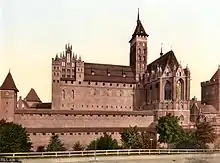
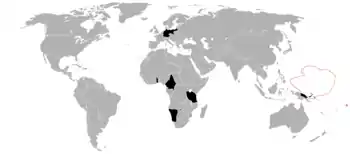
.jpg.webp)
